Europe, Part 4: A Day in Munich at the BMW Museum
— Europe — 18 min read
April 25 - 27, 2011
From Prague, I headed across southern Germany to visit a friend in Switzerland and passed through the Bavarian capital of Munich. Ever since I saw my first Road&Track magazine in my early days, I've been drawn to BMW cars and the passion hasn't let up. I was thrilled to finally be visiting the home town of this revered marque and its fantastic museum. If you're not interested in cars, skip to the next post.
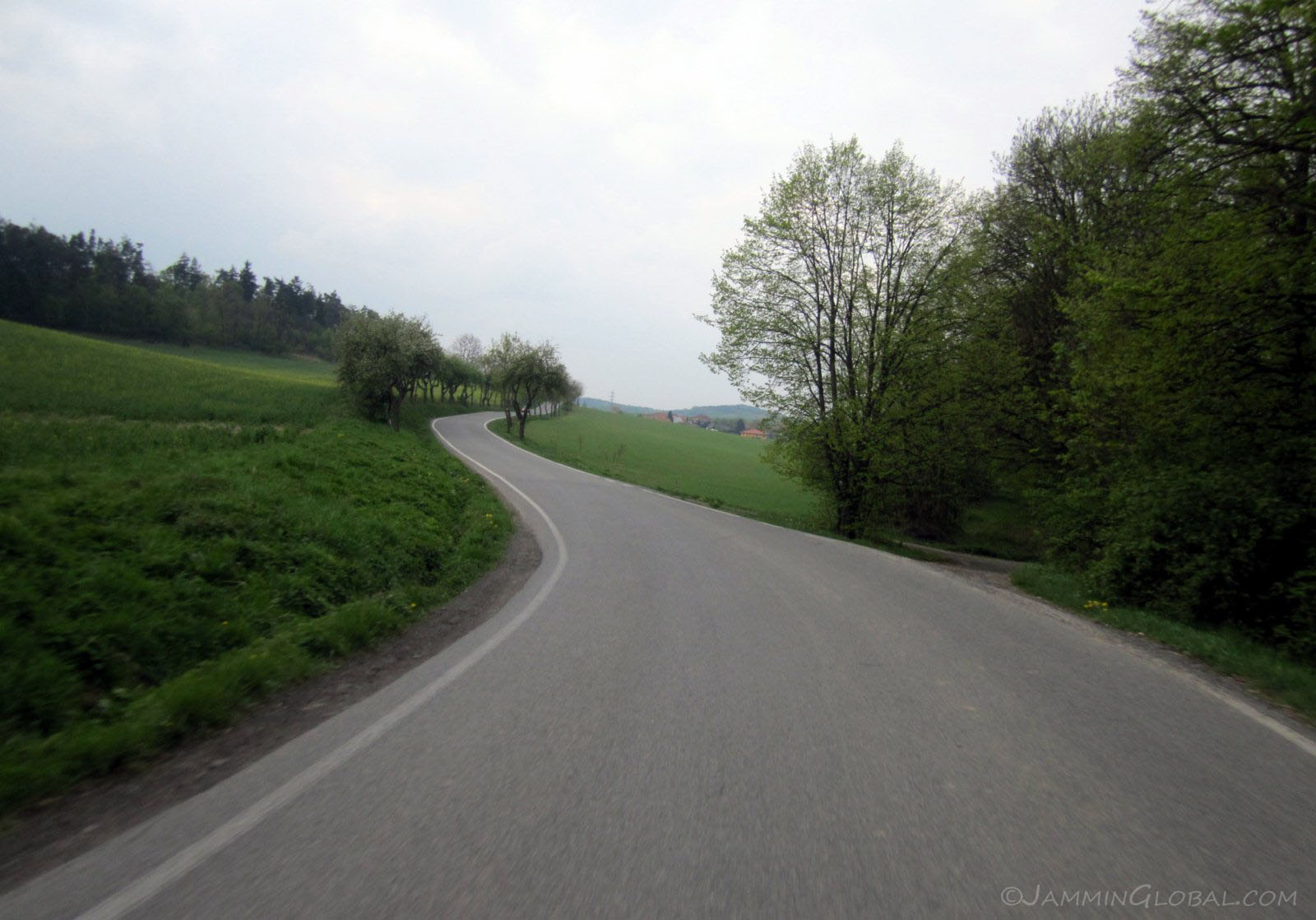
Taking sinuous secondary roads from Prague across the southwest of the Czech Republic. In my days of touring the asphalt of the US, I dreamt of riding in Europe and now I knew that those dreams were justified.
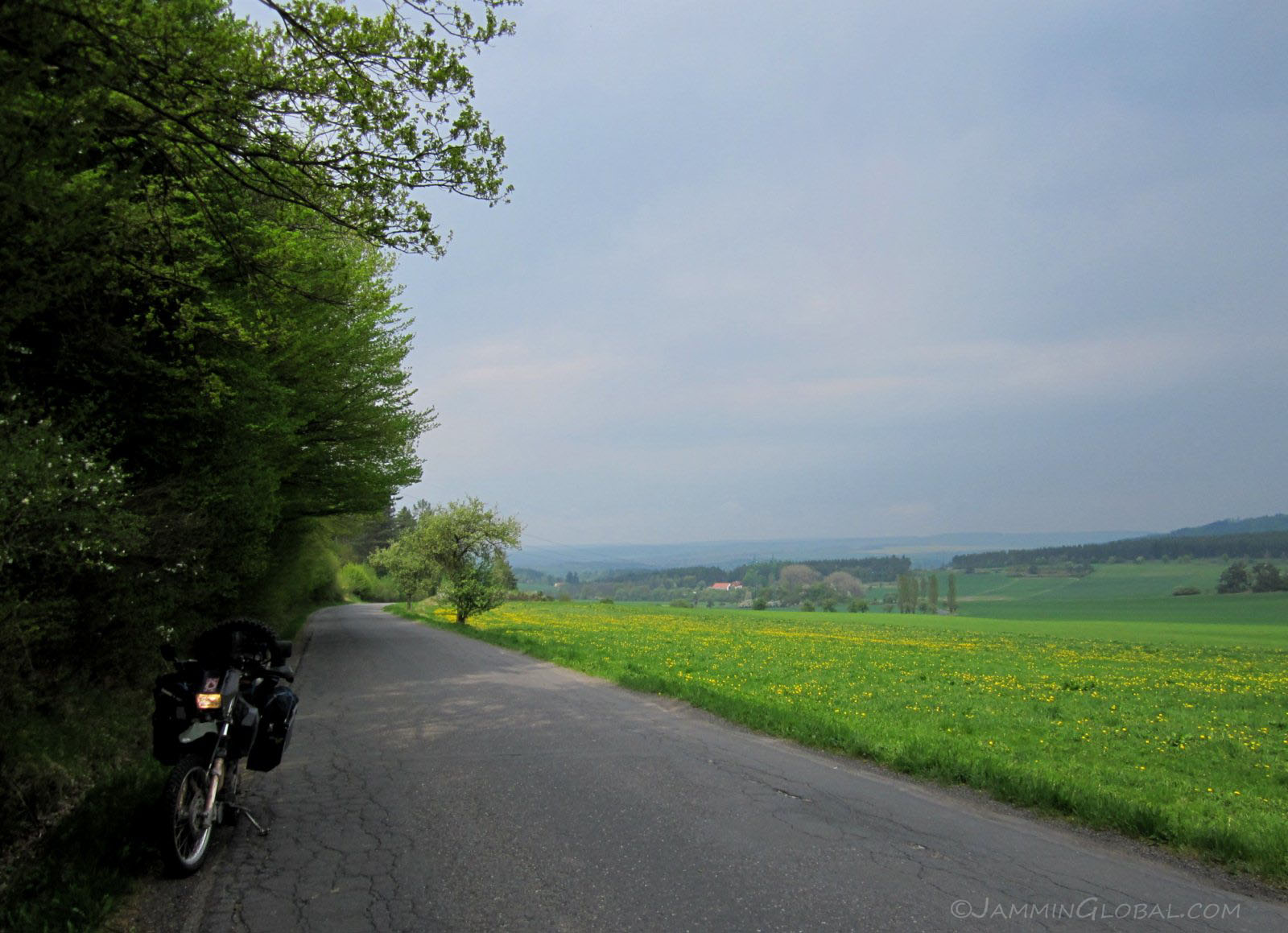
I love roads that don't have all the markings on them and are not that wide, which seems perfect for motorcycling.
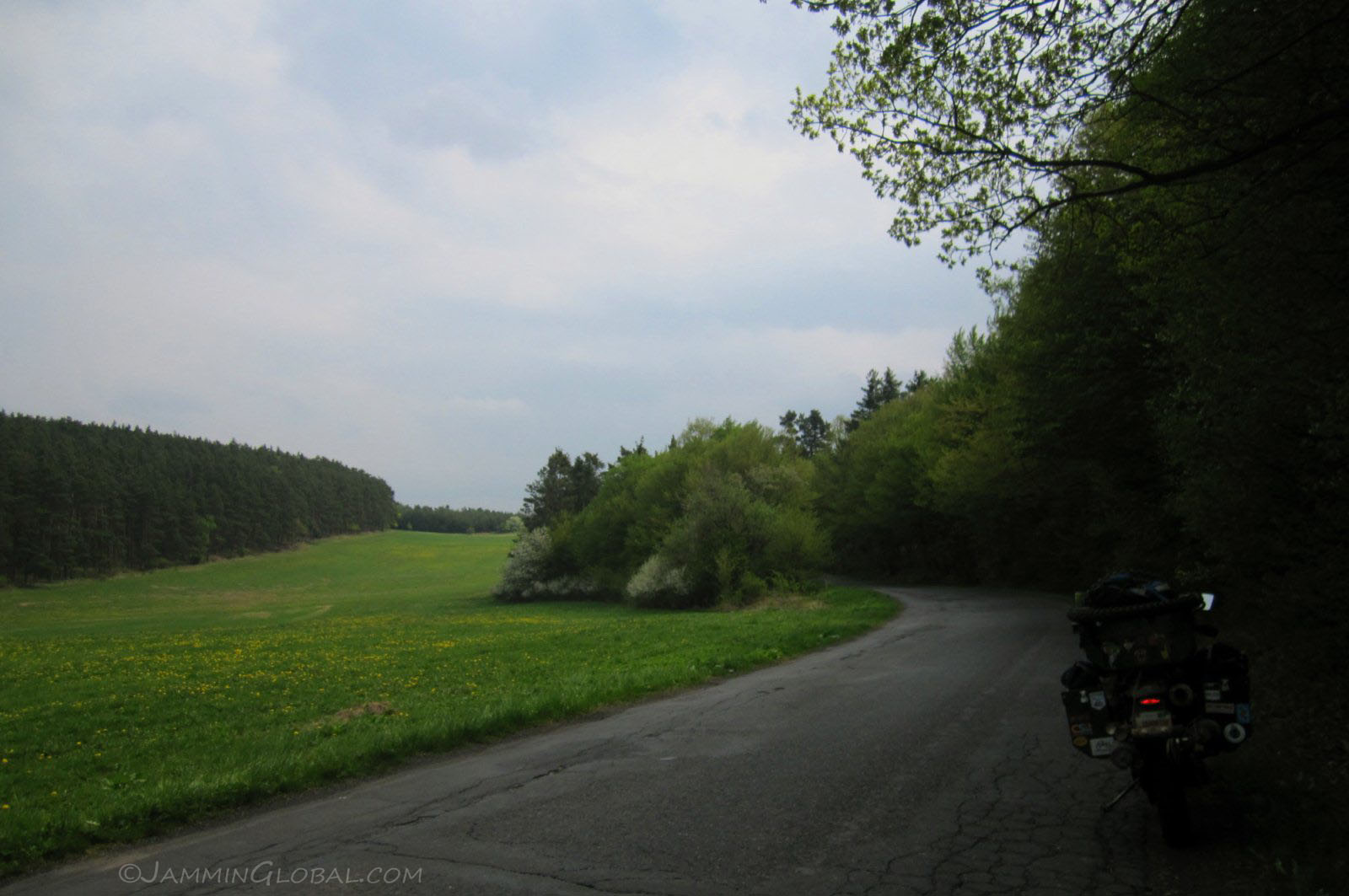
Heading off into the green hills of southwestern Czech country.
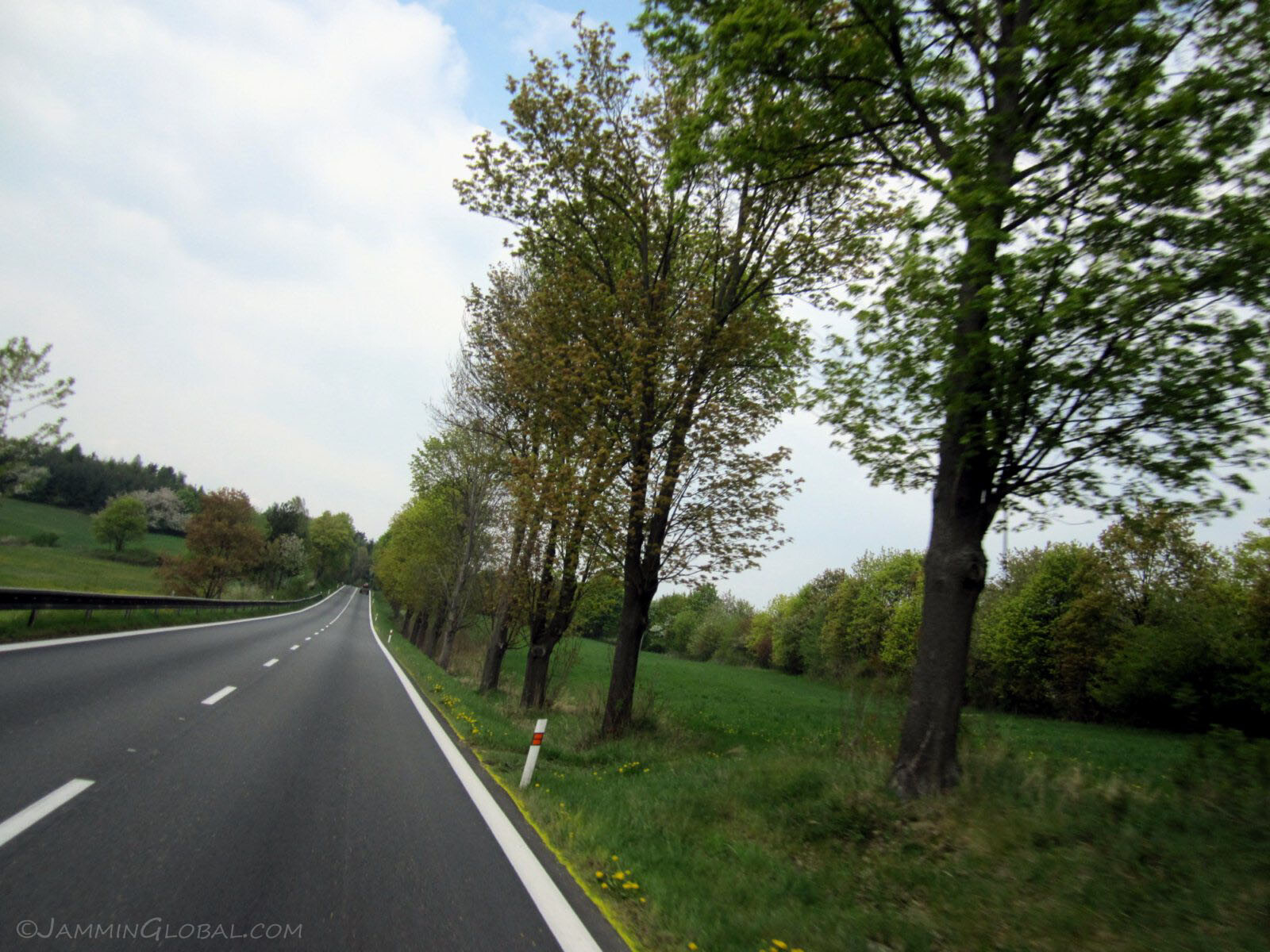
The markings showed up and the traffic increased but the riding was still enjoyable.
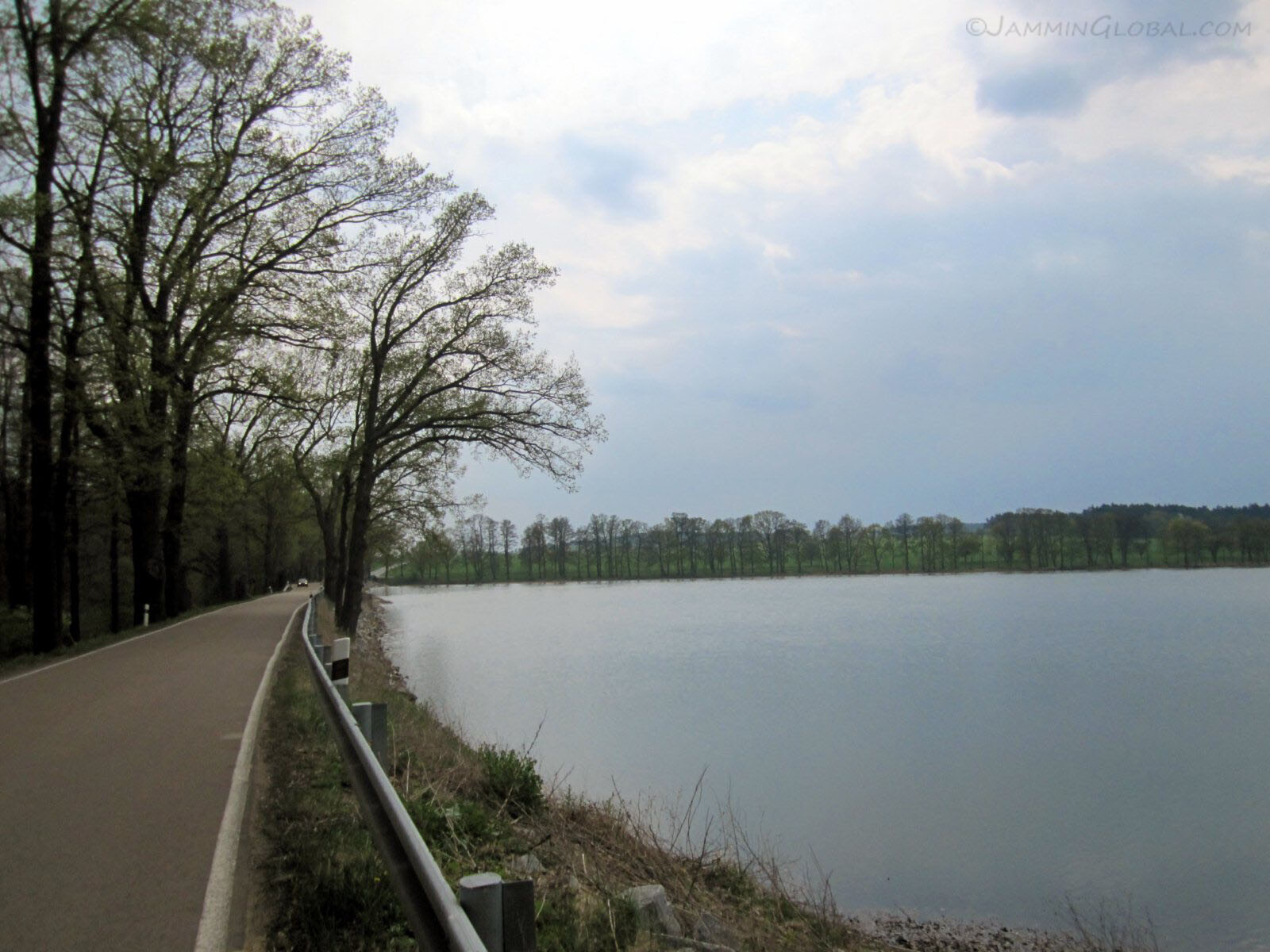
Passing by a lake near...
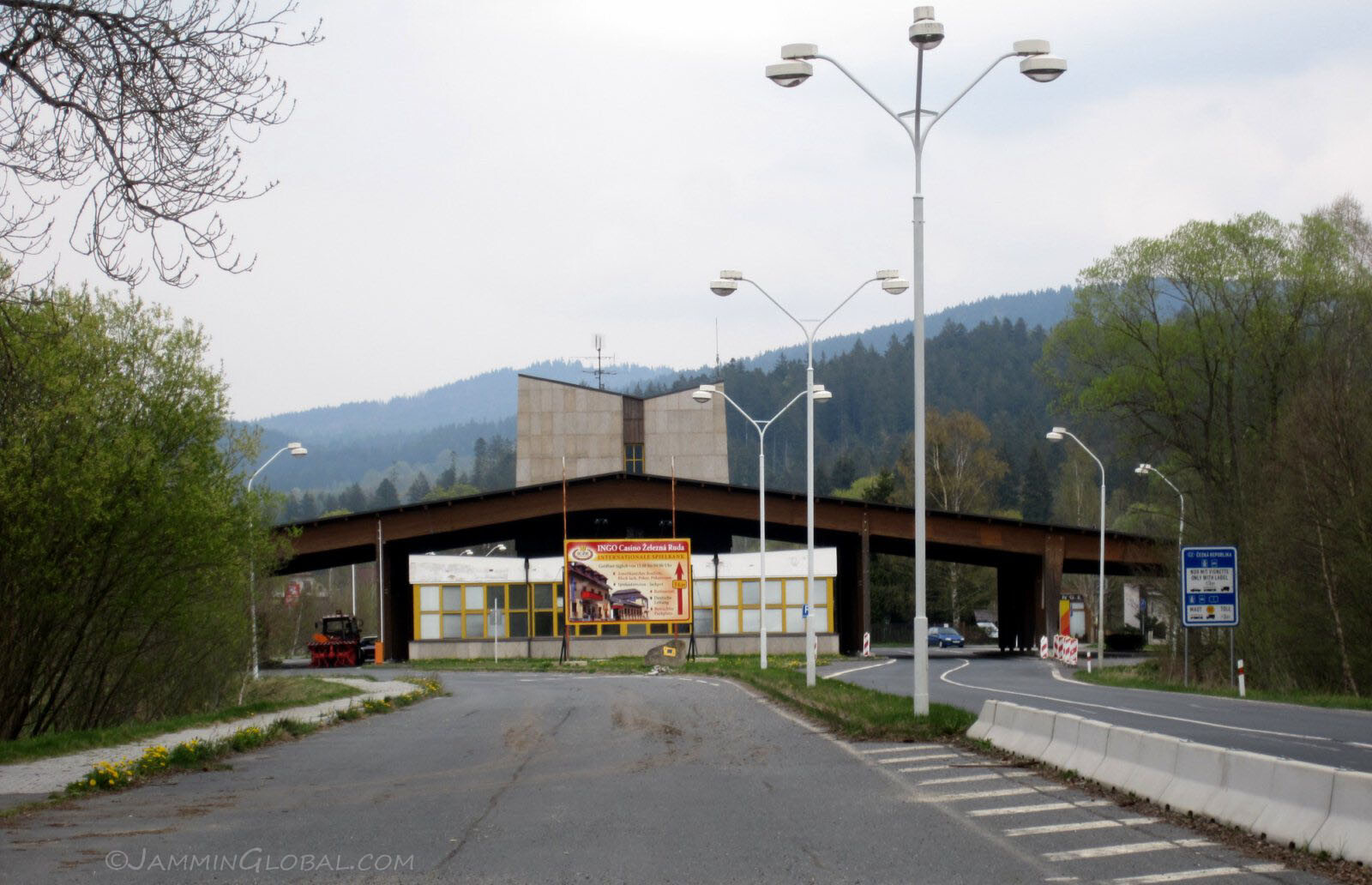
...the border with Germany, which was now just open and I can imagine how before Schengen and when the Iron Curtain was up, this portal to freedom must've been lusted by so many on the other side.
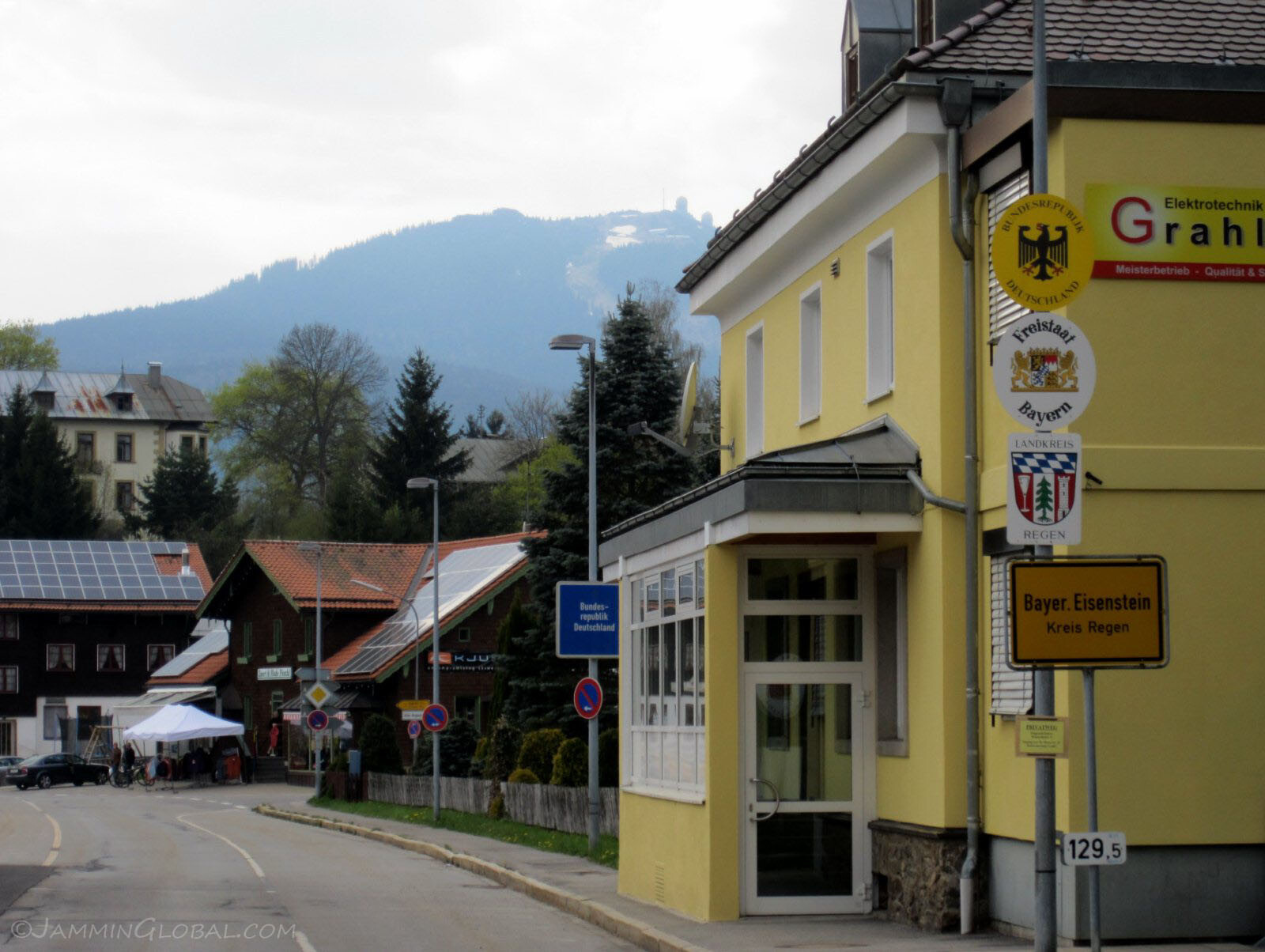
As I rolled back into Deutschland through the small border town of Bayer-Eisetentein, I noticed the changes immediately. There were a lot more Mercedes, BMWs and Audis running around.
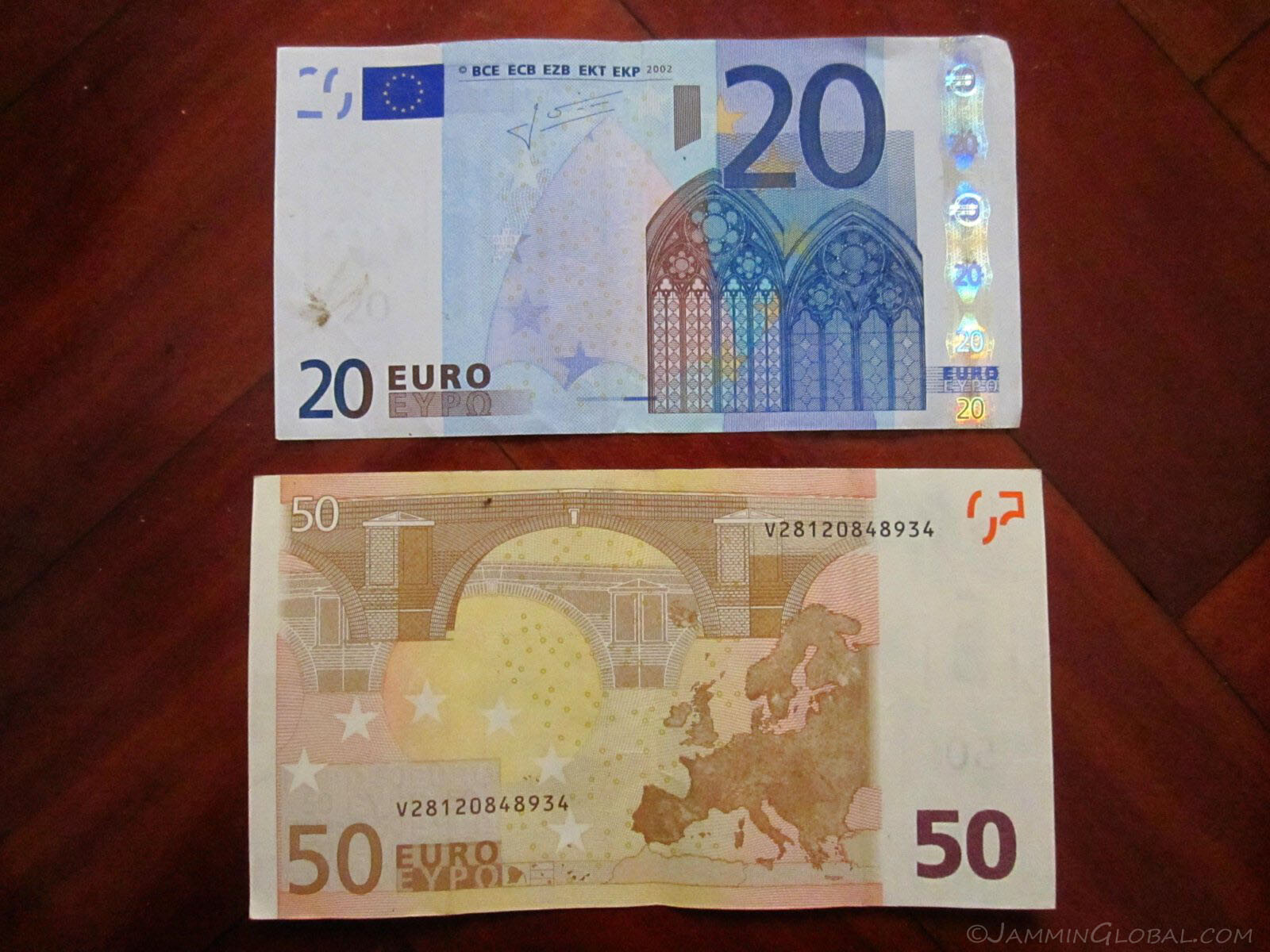
I made sure to use up the last of my Czech Crown at a petrol station near the border as now I was back in the Eurozone, the countries in the EU that have adopted the Euro as their national currency. A single European currency was the dream of many economists and politicians on the continent since the end of World War II to unite all their peoples. It was introduced on January 1, 1999 and slowly got adopted by more and more member states. The transition was surprisingly smooth considering the varied economies and cultures that this currency was tying together. I remember seeing a BBC program where a reporter left with £100 from London and changed it at every country through Europe and when he got back, he only got £75 back. This loss in currency exchange was one of the goals of the euro, among others. Today, it is considered to be the second reserve currency of the world, behind the US dollar, but the value of all its notes in circulation have surpassed the dollar. $1 = €0.70. That €50 note is worth $71.
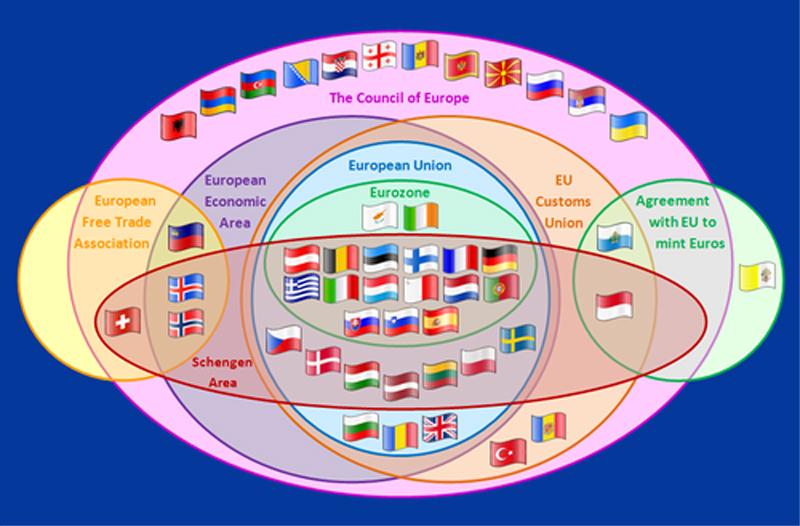
While the dream of the single currency was realized, Europe is still a strange union among cultures with clearly defined boundaries. This venn diagram helps to define which countries are party of which treaties in the area known as Europe.
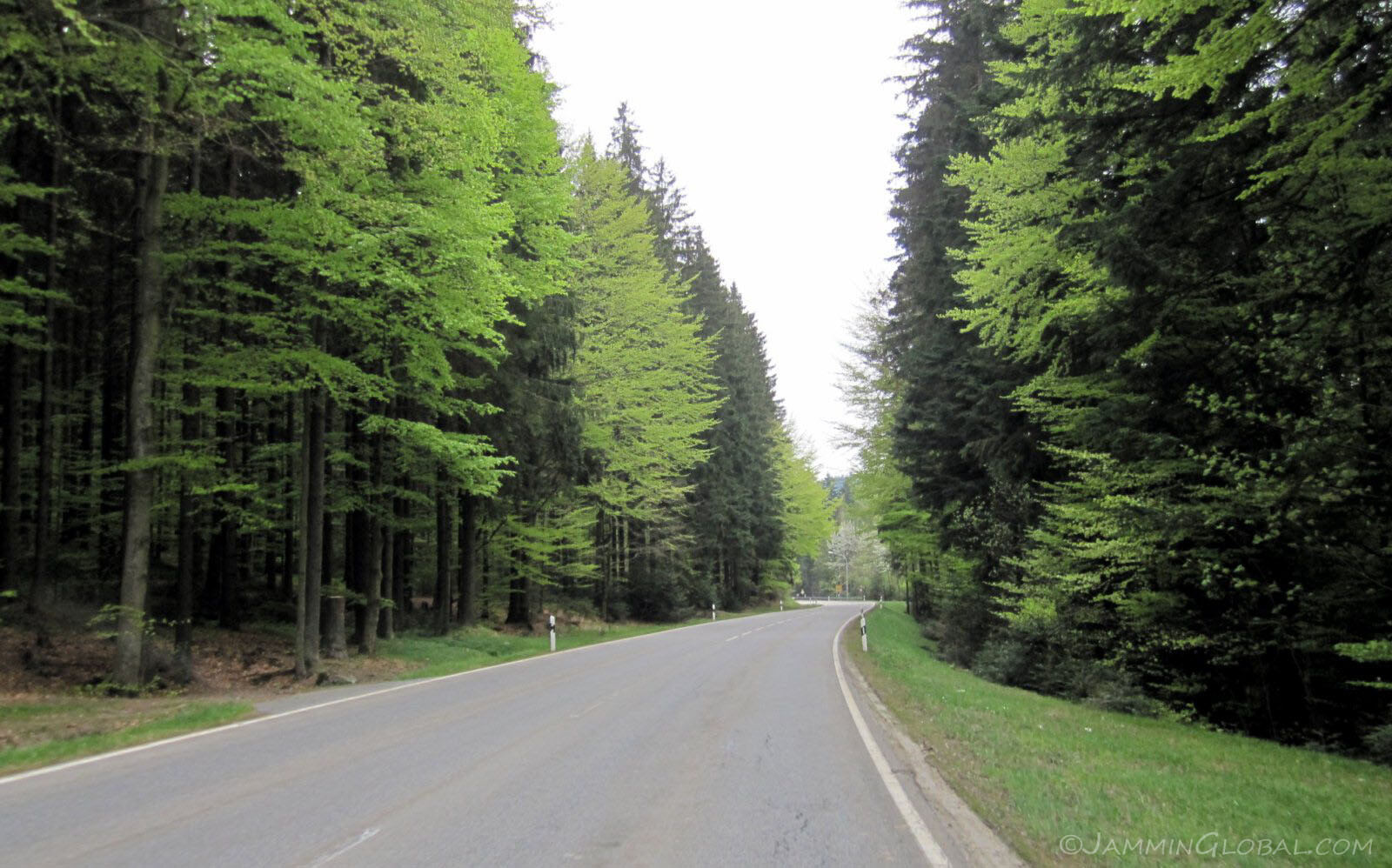
Riding the beautiful roads of Bavaria and heading to its capital of Munich.
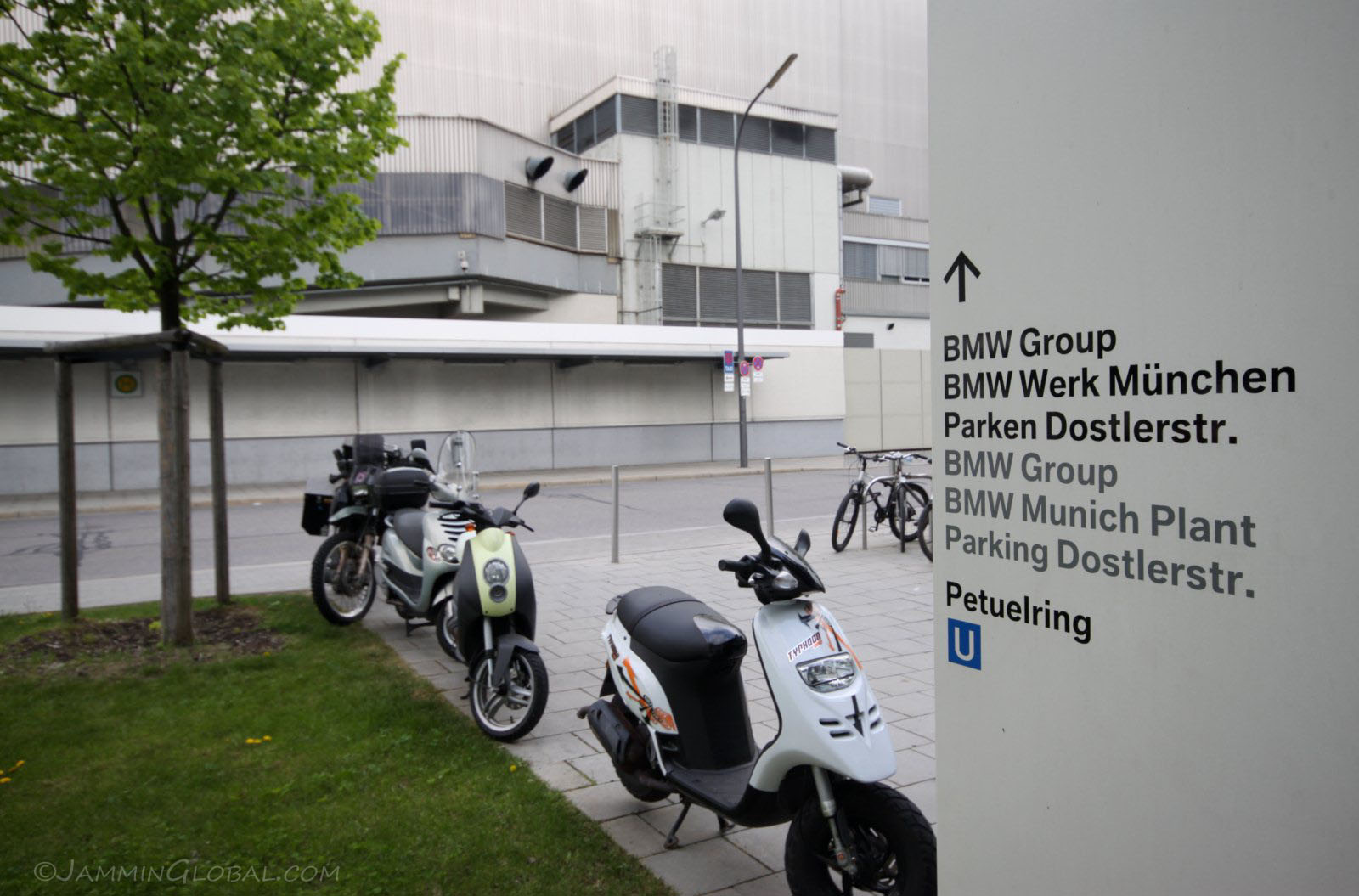
I spent just one day there and I spent that entire day getting to know my favorite car company.
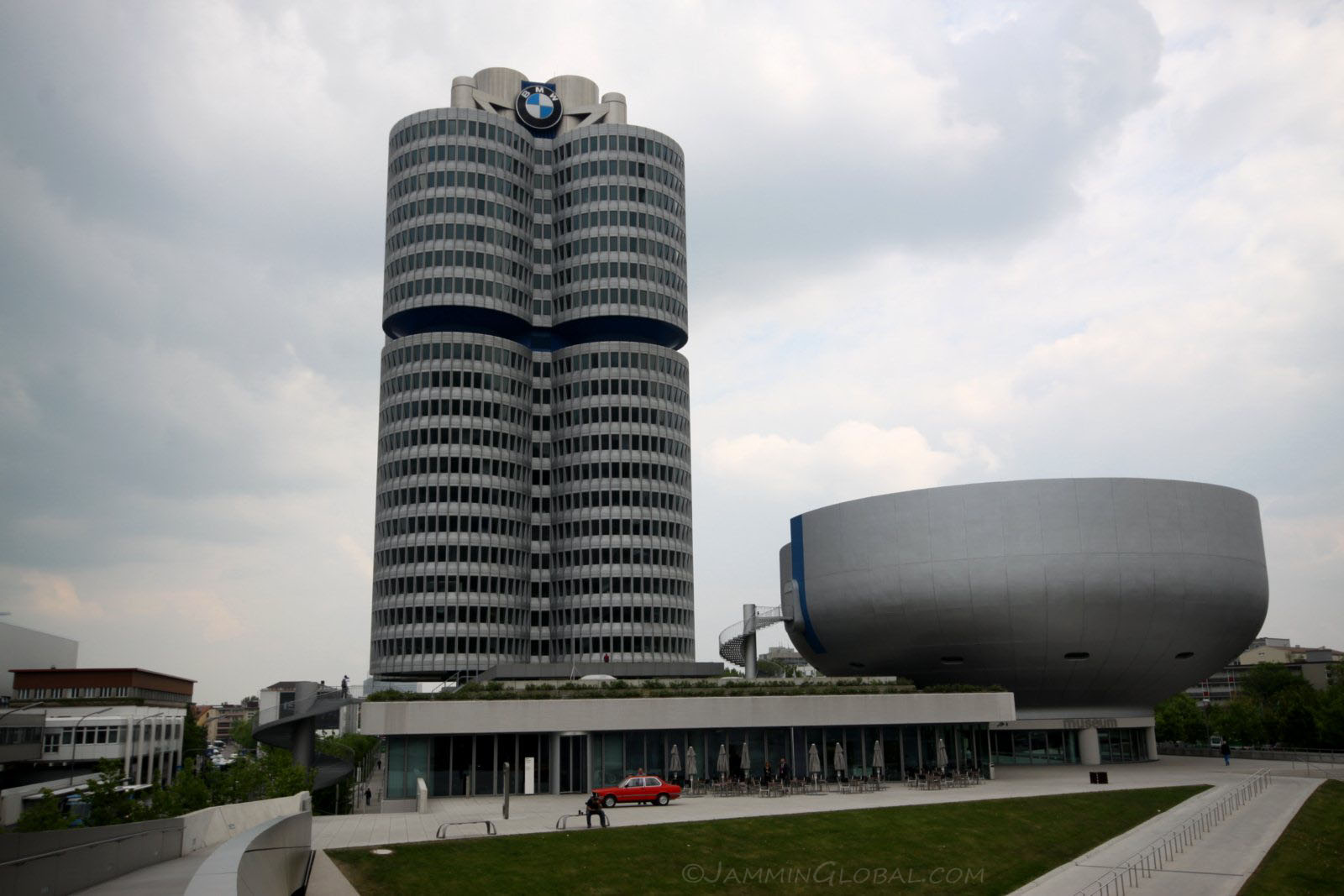
The iconic BMW Tower, known as the Vierzylinder, as the four towers represent a four-cylinder engine. It was built in time for the 1972 Olympic Games at Munich as has been serving as the group's headquarters since then. The round shape in front is the BMW Museum, which extends a few floors below ground. For €12, it was a special treat.
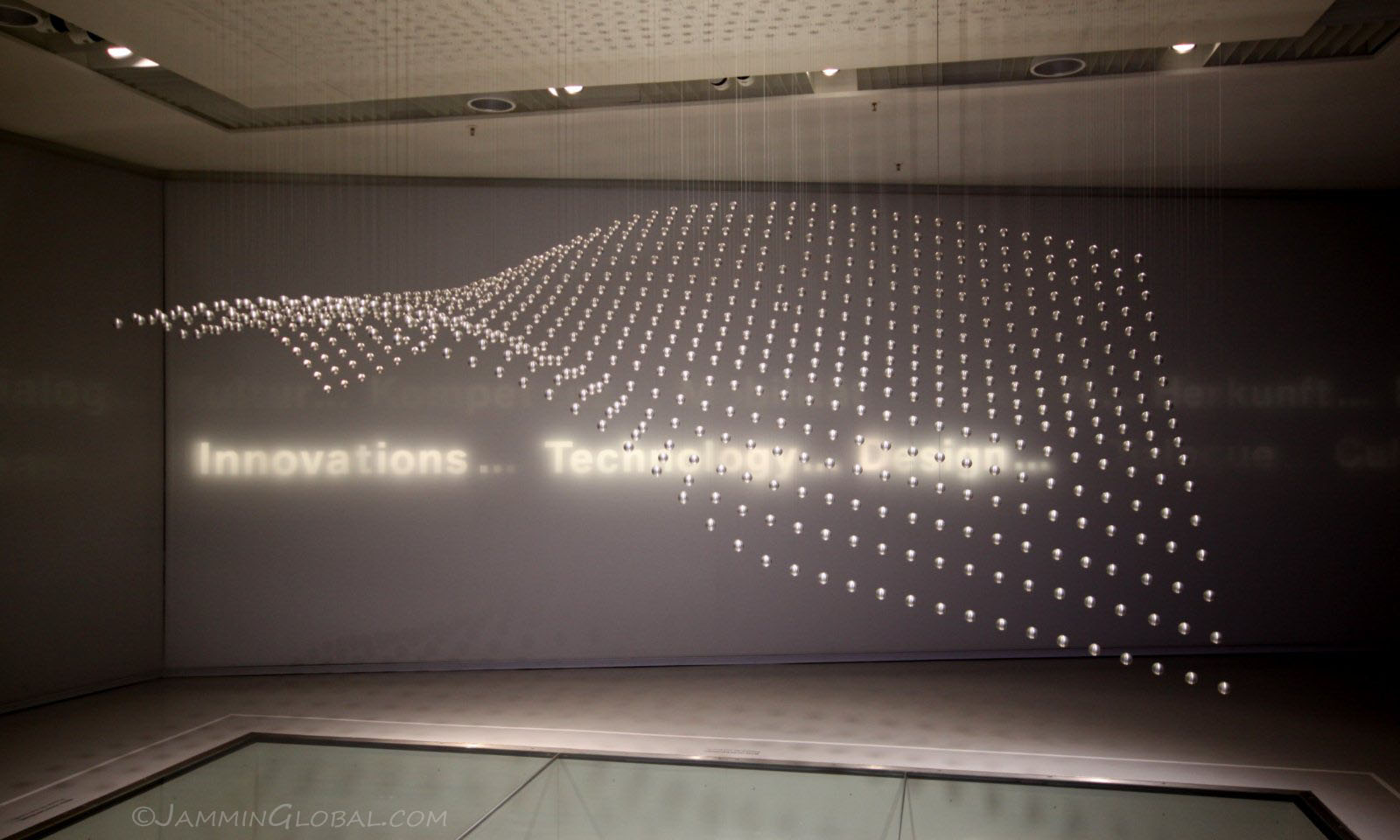
Upon entering the vault-like museum, this is the first display to greet visitors. Round metal balls are suspended from thin wires and they move up and down to create different shapes.
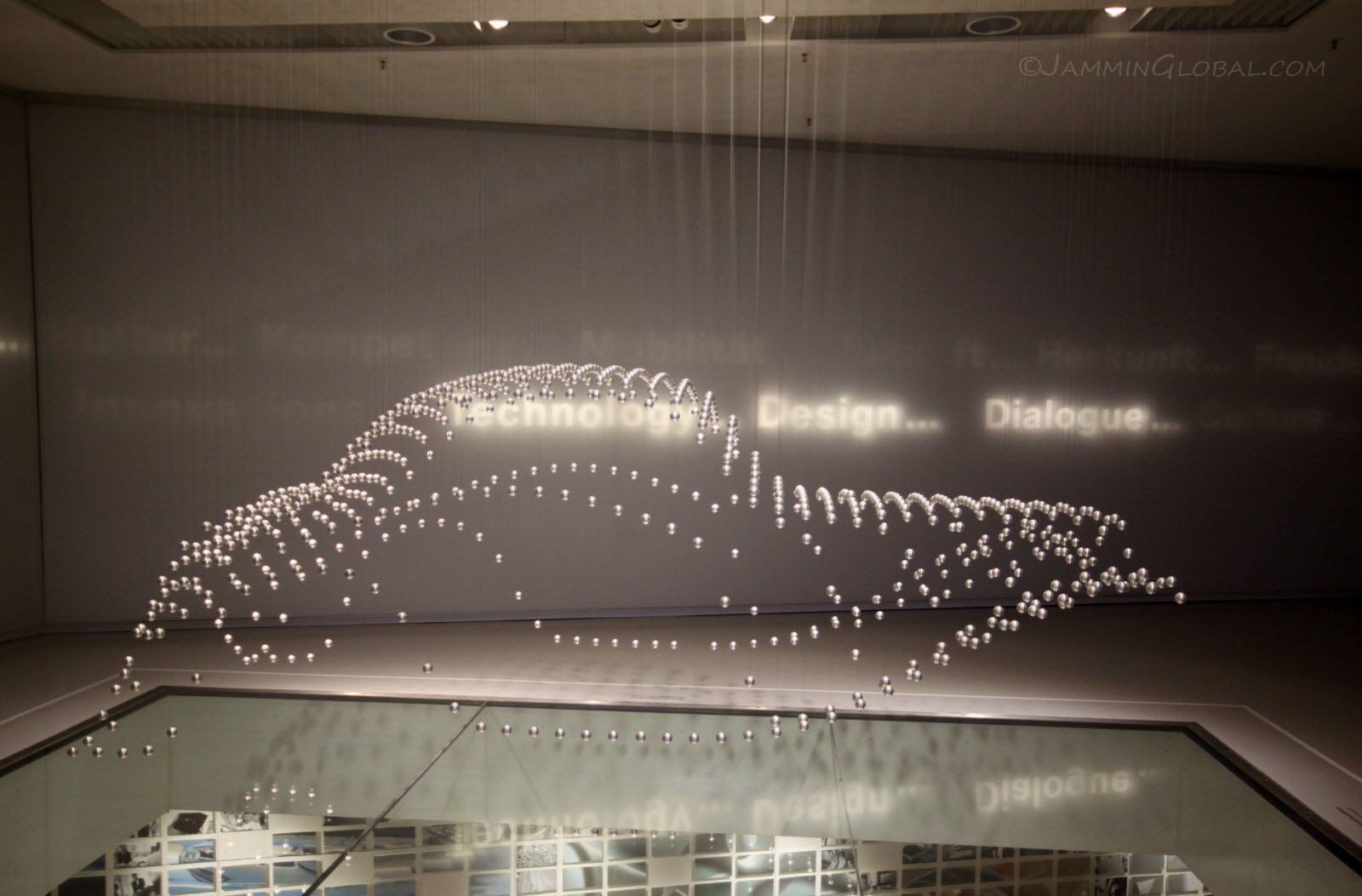
Along with me, everyone else there was in silenced awe of the display. It went on to create all kinds of cars through BMW's history.
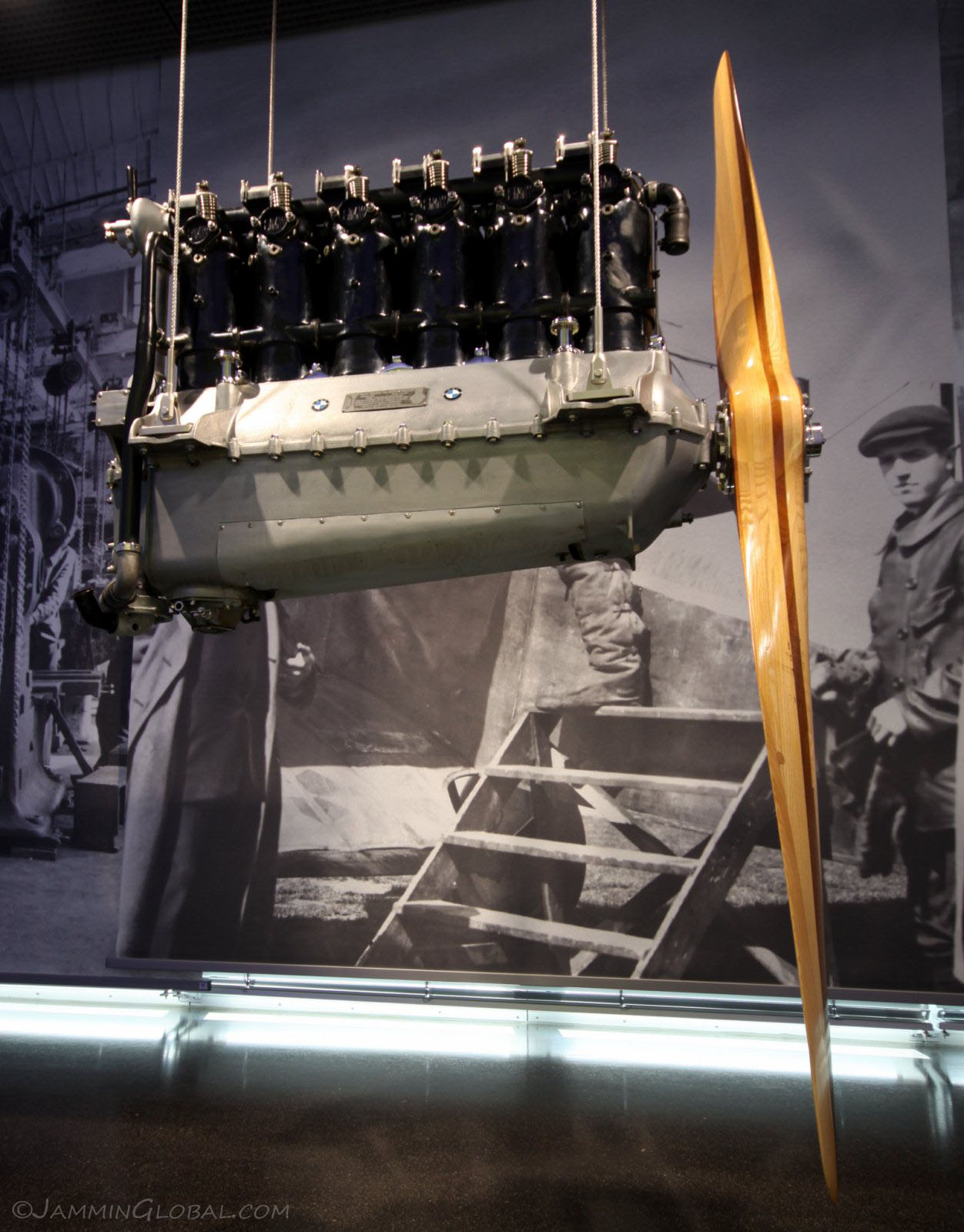
As was explained in the movie Finding Forrester, the BMW emblem of blue and white quadrats represents a spinning propeller against a blue sky with clouds. The company came together in 1916 when World War I aircraft engine manufacturer Rapp Motorenwerke became Bayerische Motorenwerke and was then bought by Bayerische Flugzeugwerke who were making motorcycles and that soon became an integral part of the new BMW company.
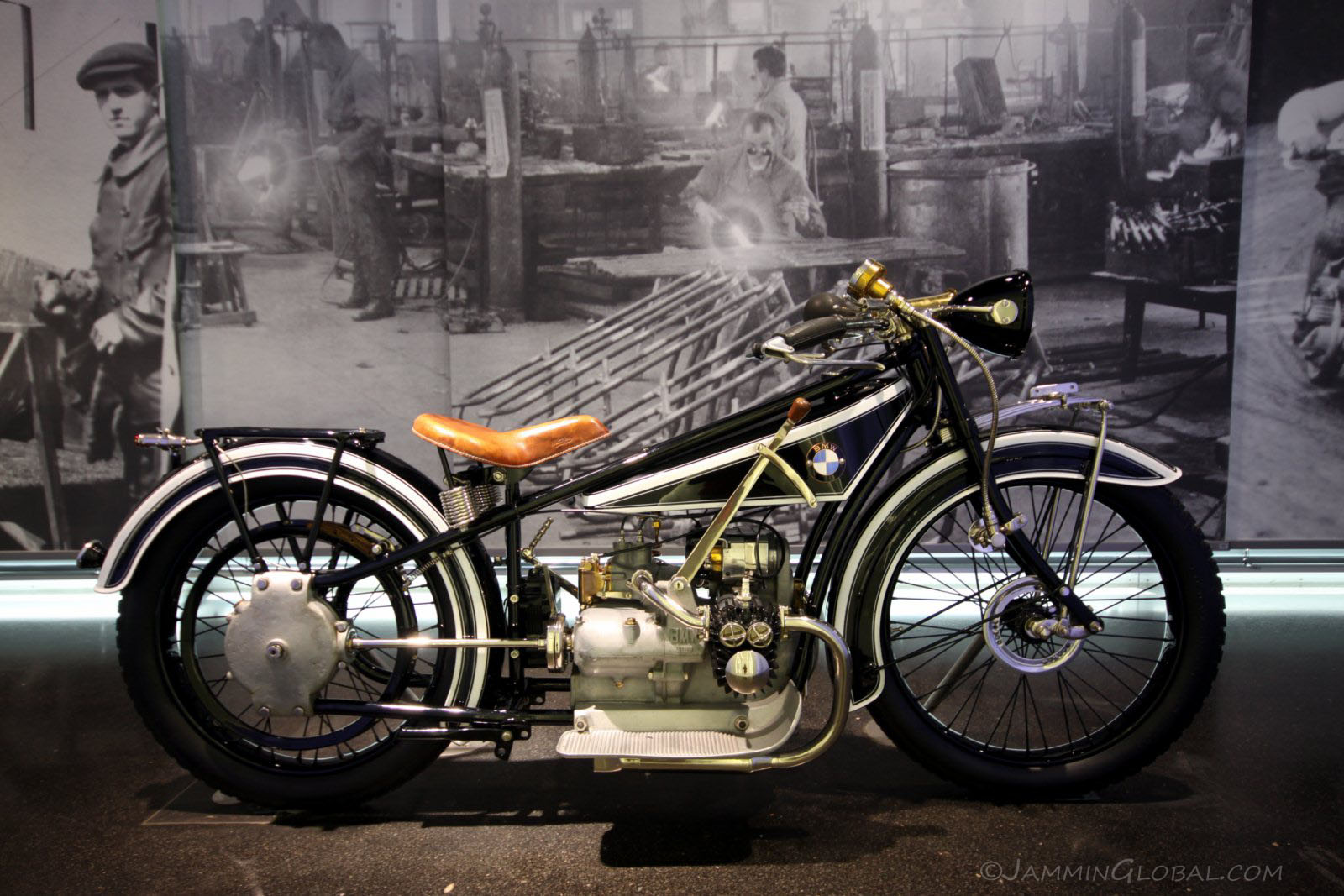
An impeccable BMW R32, the first motorcycle to wear the BMW badge, being produced from 1923 to 1926. It was a redesigned Helios motorcycle that was made by Bayerisch Flugzeugwerke (BFw). The redesign by Max Friz addressed the cooling of the cylinders by laying the boxer engine with its two opposing cylinders sticking out in the wind for adequate air cooling and coupled it with a shaft drive to the rear wheel. Amazingly, 90 years later, that configuration is still what defines most BMW motorcycles. It's not to everyone's liking, but it seems to tickle enough consumers to keep the design going. This is one of the primary aspects of the company that has kept me a loyal fan - their ability to buck the trend and stick to their ideals in a sea of convergent designs.
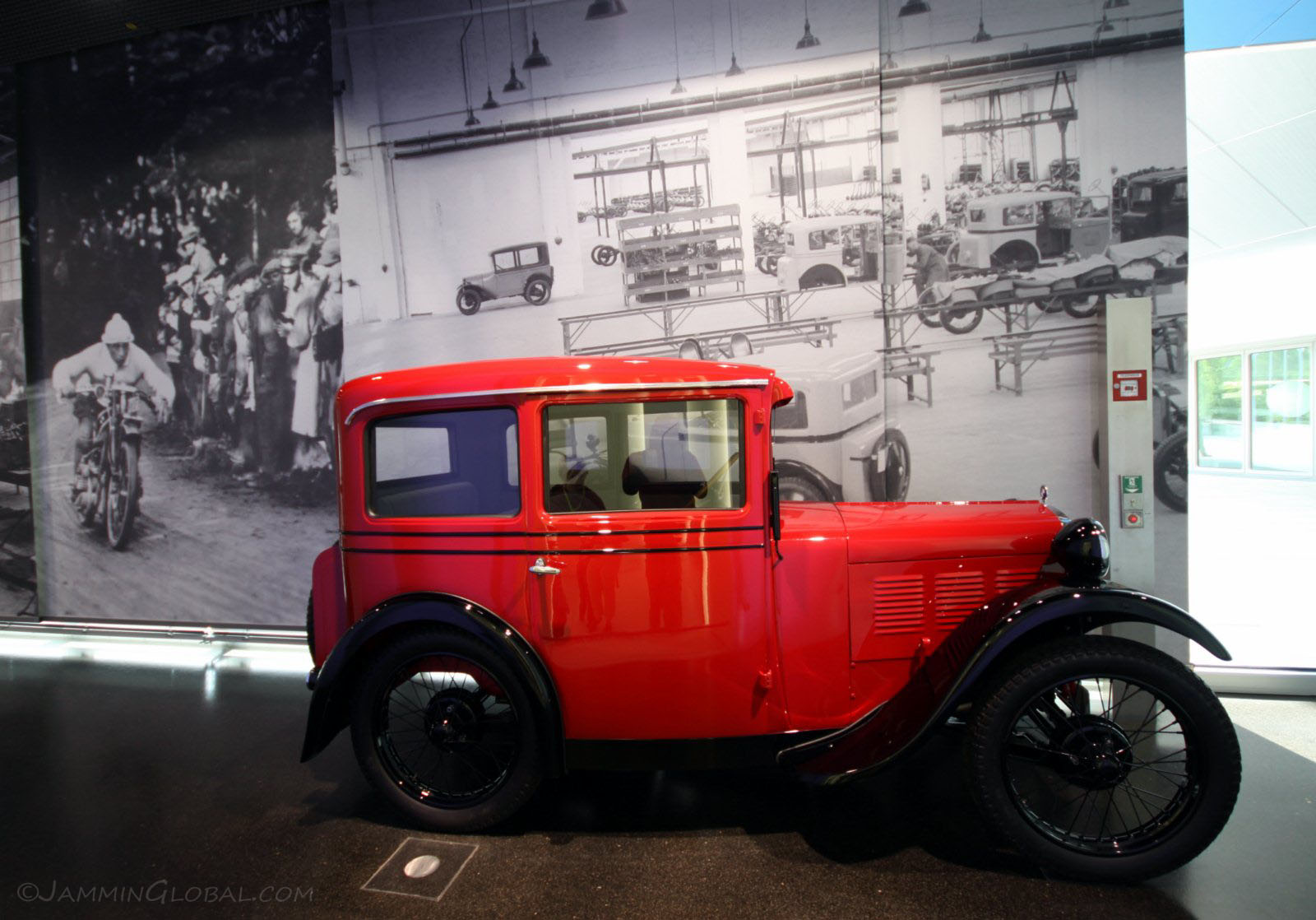
The first car to carry the BMW badge was the Dixi 3/15, produced from 1927 to 1929. This car was a German version of the English Austin Seven, which was made under license by Fahrzeugfabrik Eisenach using the Dixi marque, which BMW bought in 1928 to enter the automobile industry. The car made 15 horsepower and hit a top speed of 75 kph (45 mph).
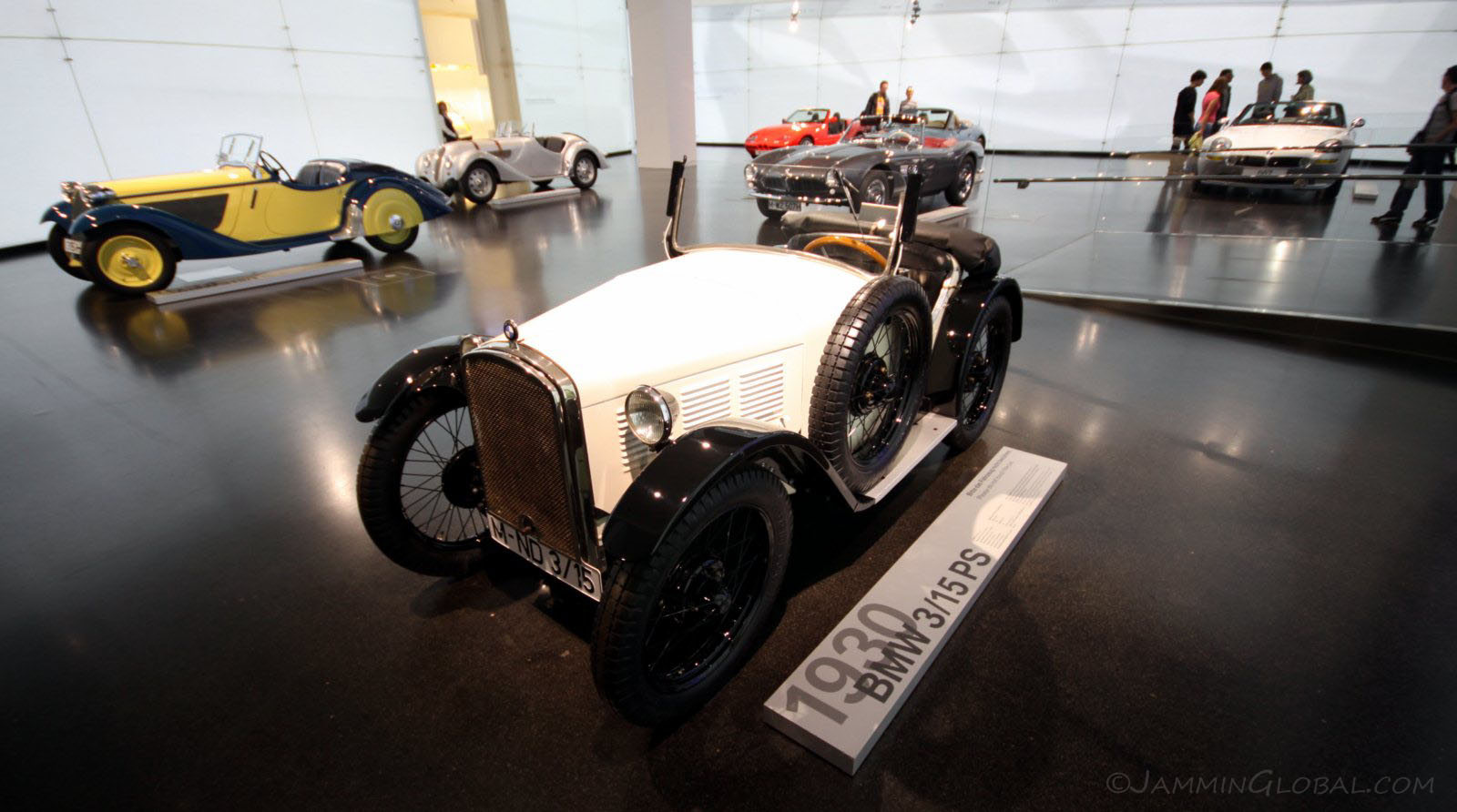
Many variants of the 3/15 were produced, including this cute roadster in the open-top gallery.
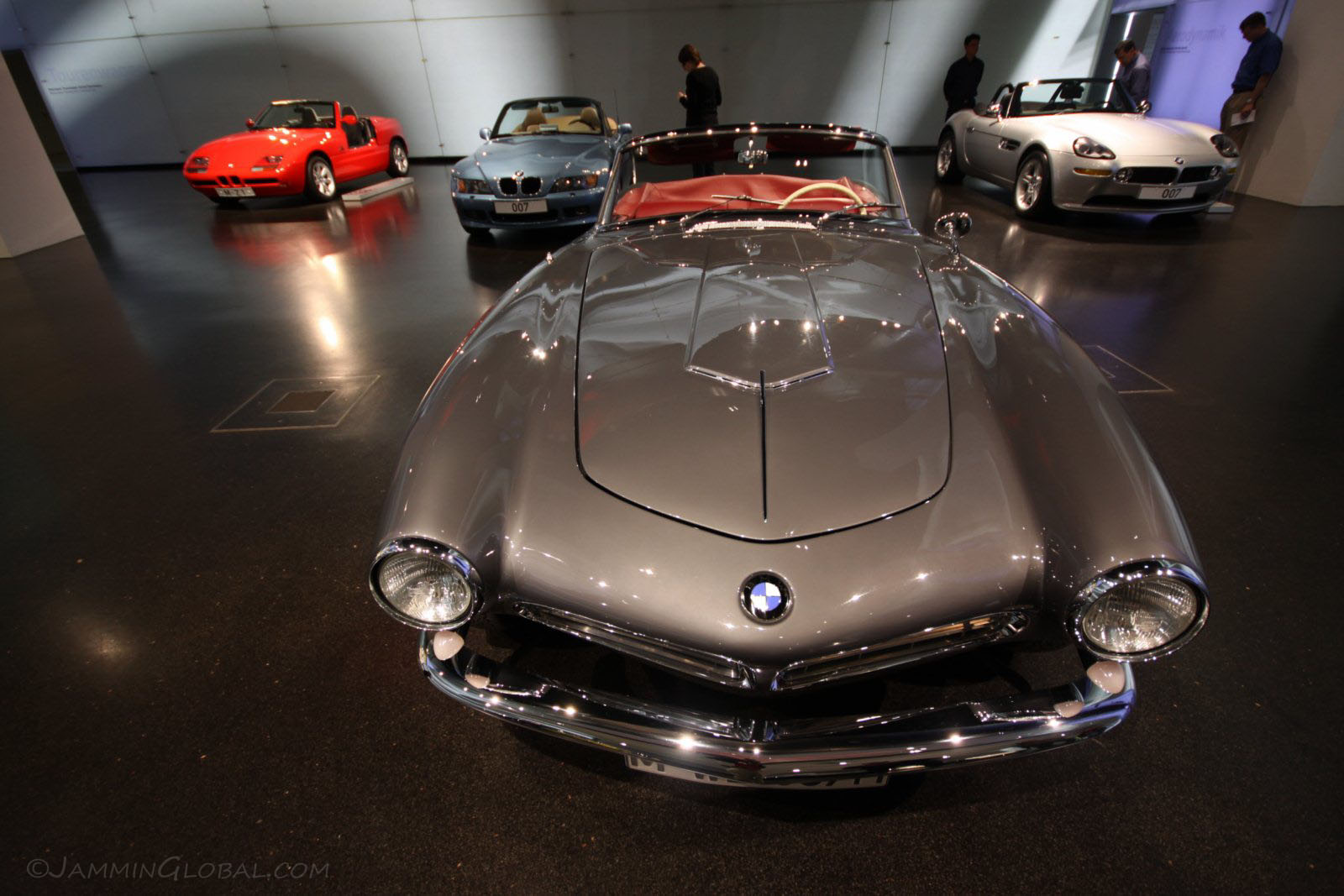
Behind it was the sexy BMW 507 roadster, considered one of the most handsome cars of all time with its long bonnet and swooping lines. It was produced from 1956 to 1959 with only 252 examples ever made. While being an aesthetic success with 202 models still surviving, it was a financial failure for the company due to the expensive manufacturing costs and drove them near bankruptcy. The body was made of hand-formed aluminum and thus, no two cars are exactly alike. From its initial list price of \$10,000 in the 1950s, the 507 now auctions for a million dollars.
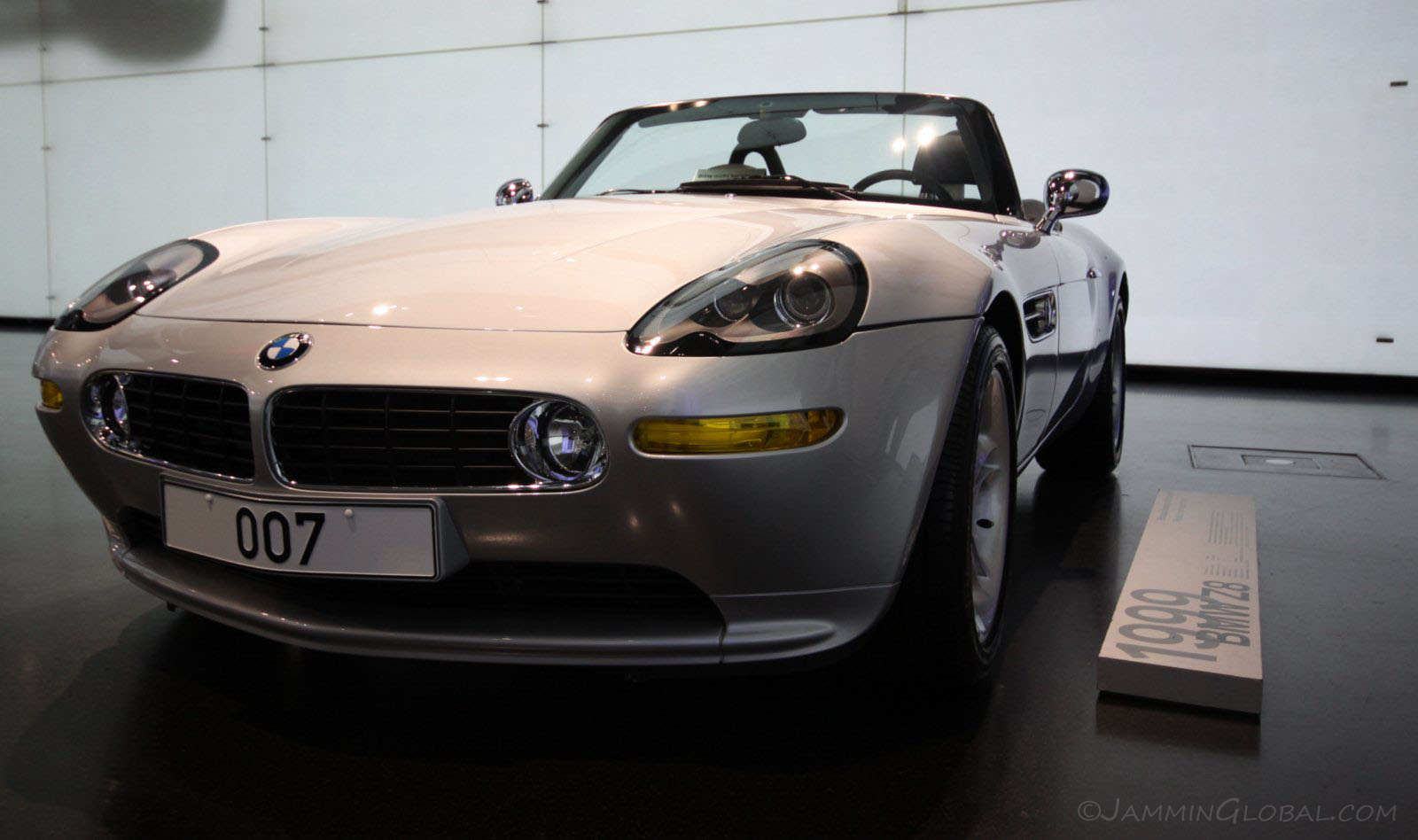
The 507 inspired the future roadsters of the company and is best captured in this BMW Z8, which is the exact car that was used in the 1999 James Bond film, The World Is Not Enough. In the movie, the car was swapped for a model before being cut in half by a helicopter saw.
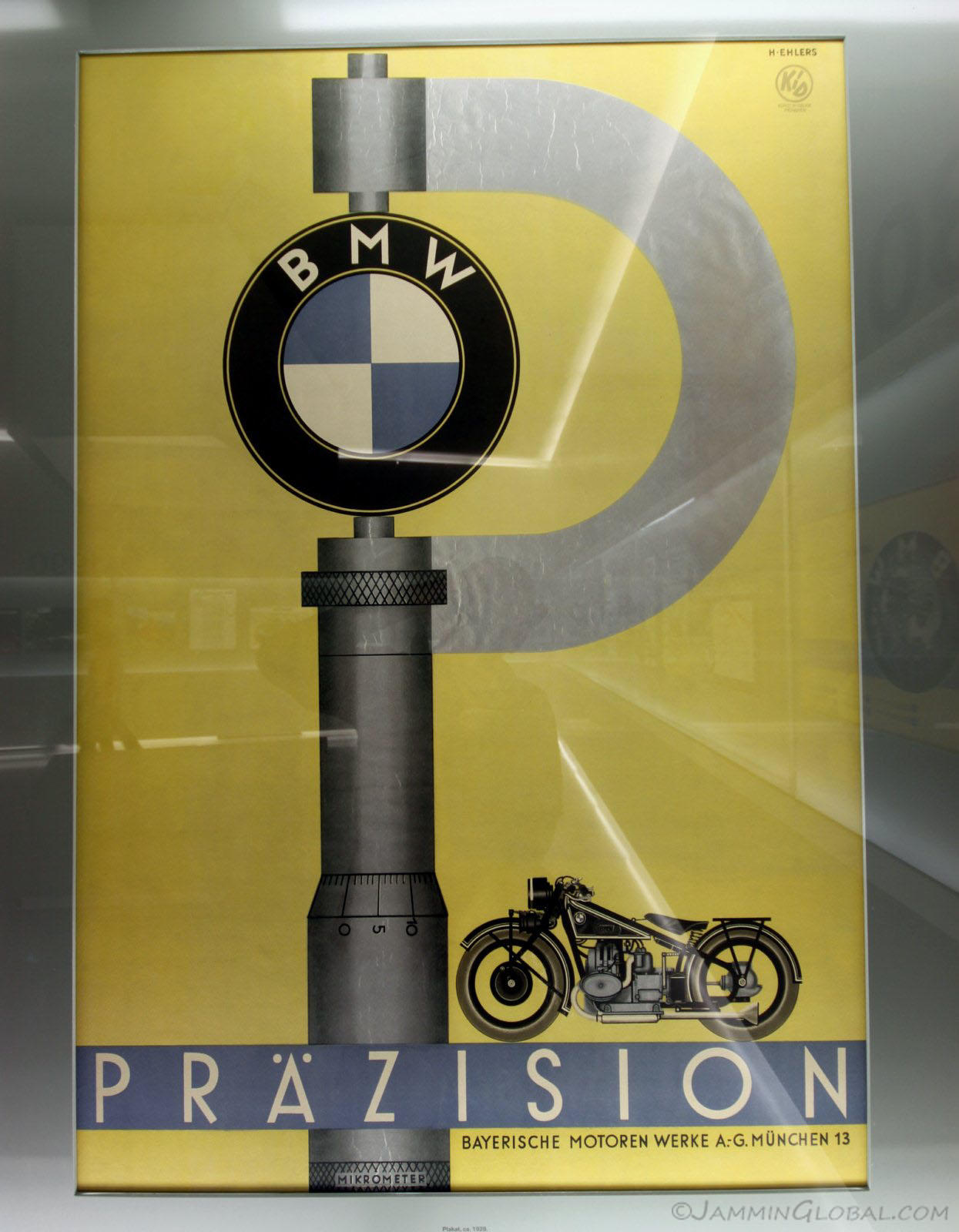
From the early days, BMW advertising showcased their superior precision engineering, captured here by a micrometer.
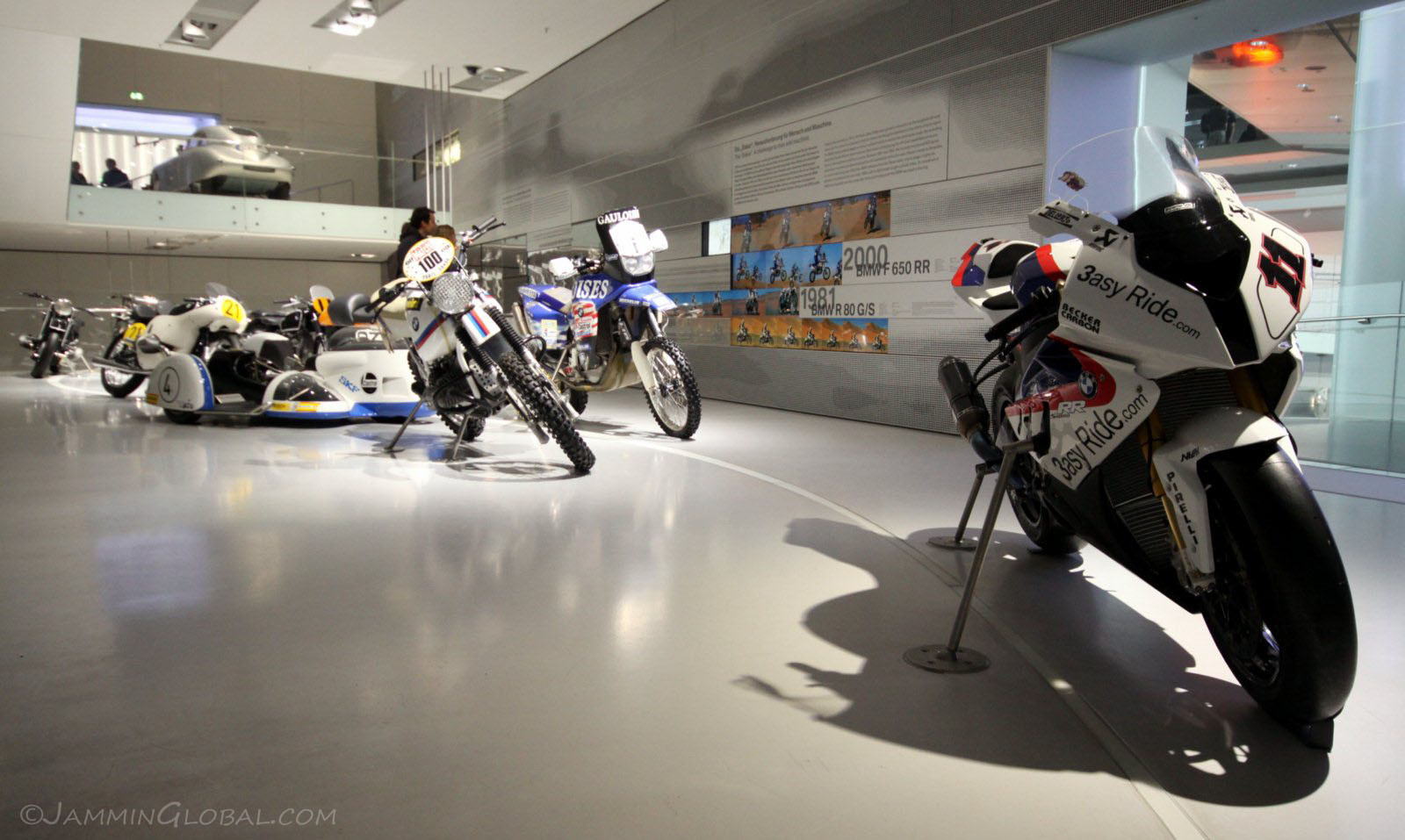
The company's racing motorcycles were setup in an interesting display to depict them flowing around a race track. Up front is their newest S1000RR, which actually conforms to the current trends of putting in an inline-4 engine, driven by a chain and looking like most of the Japanese competition.
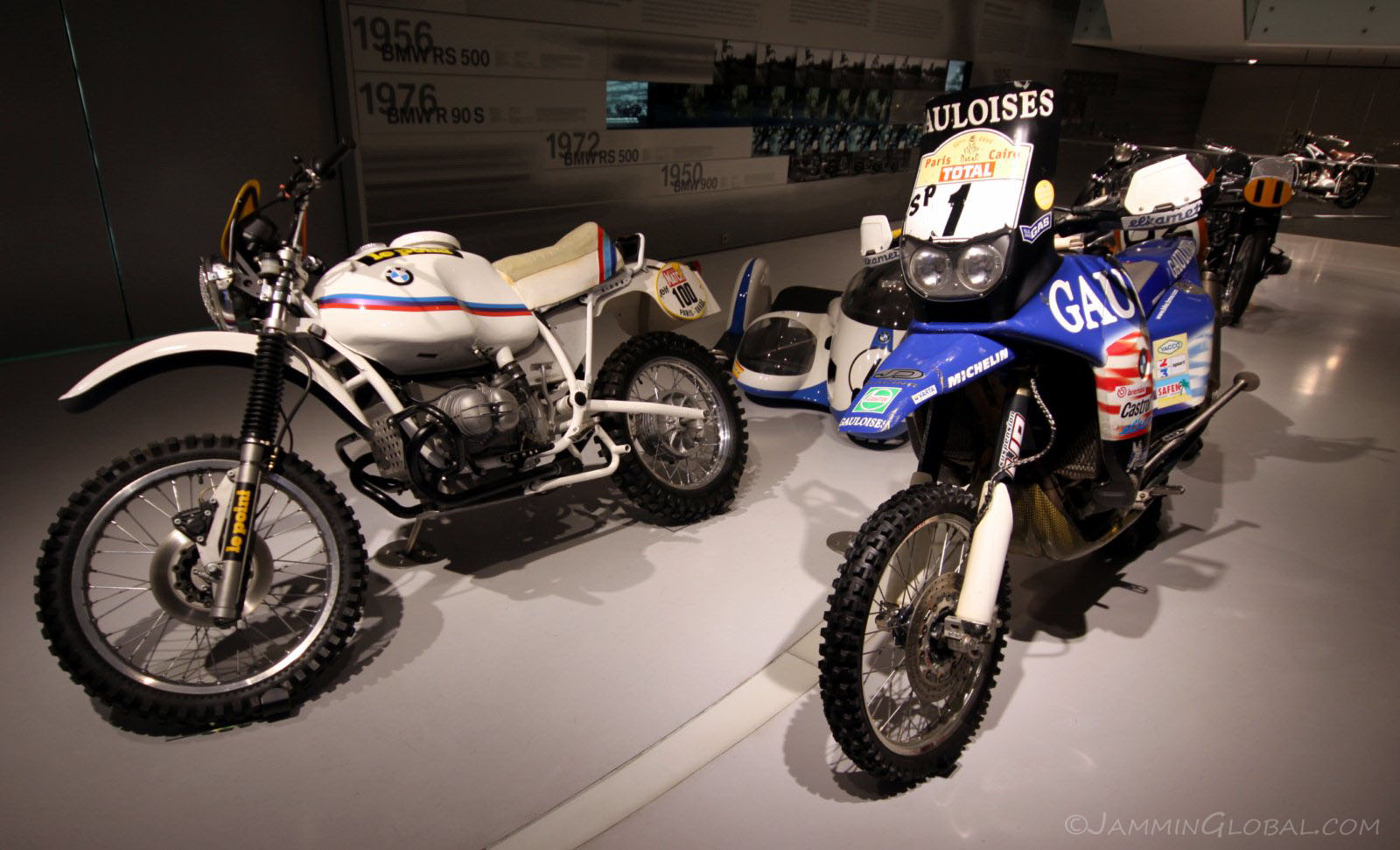
A bit further back in time showcasing BMW's motorcycle triumphs in the Paris-Dakar Rally. On the left is a BMW R80G/S, which in 1980 launched the still running G/S line of dual sport motorcycles. The G/S (Gelände/Straße) is German for off-road/on-road. The blue one on the right is a more recent brother, the F650RR, built by Richard Schalber and Touratech to compete in the endurance rally event. Its 700cc single cylinder produced 75hp and it had a fuel capacity of 50 liters (13.3 gallons)!
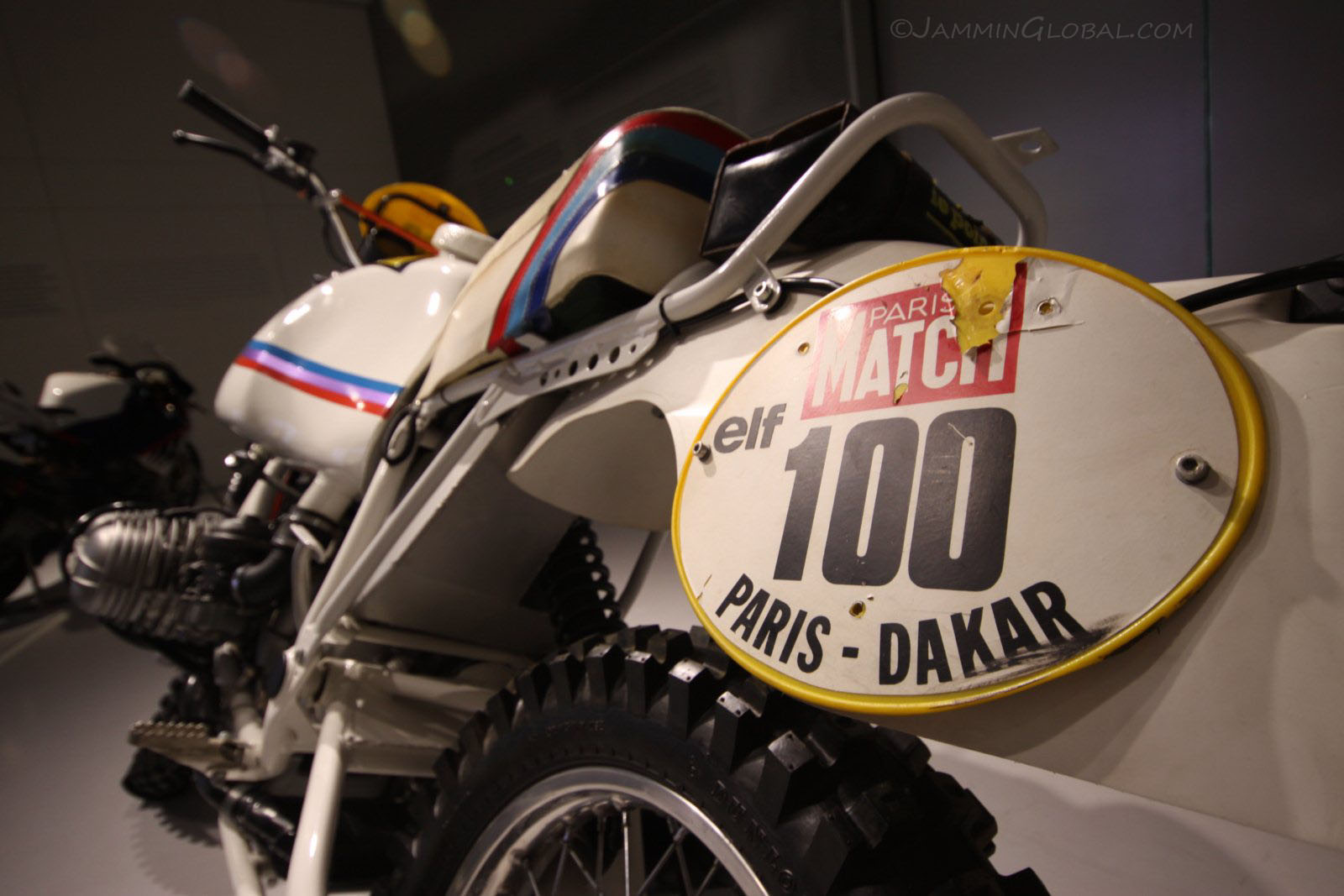
BMW's dual sport motorcycles took off after its numerous successes in the Paris-Dakar Rally and is considered by many to be the obvious choice for around-the-world motorcycle travel. However, I quite don't like their complexity and heaviness, instead preferring the simpler Suzuki DR650.
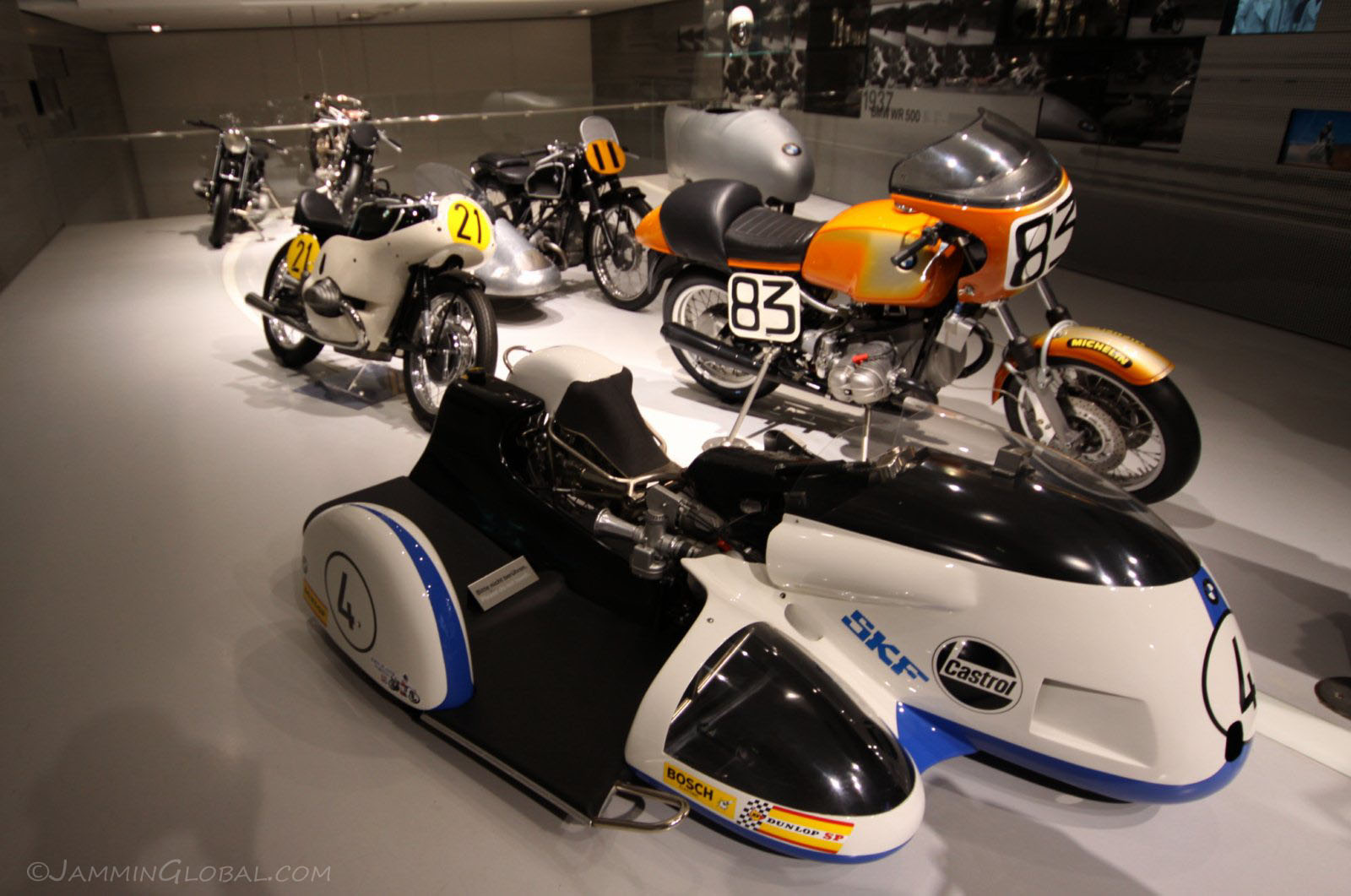
Low-slung motorcycles with racing side cars. I'd love to try this someday.
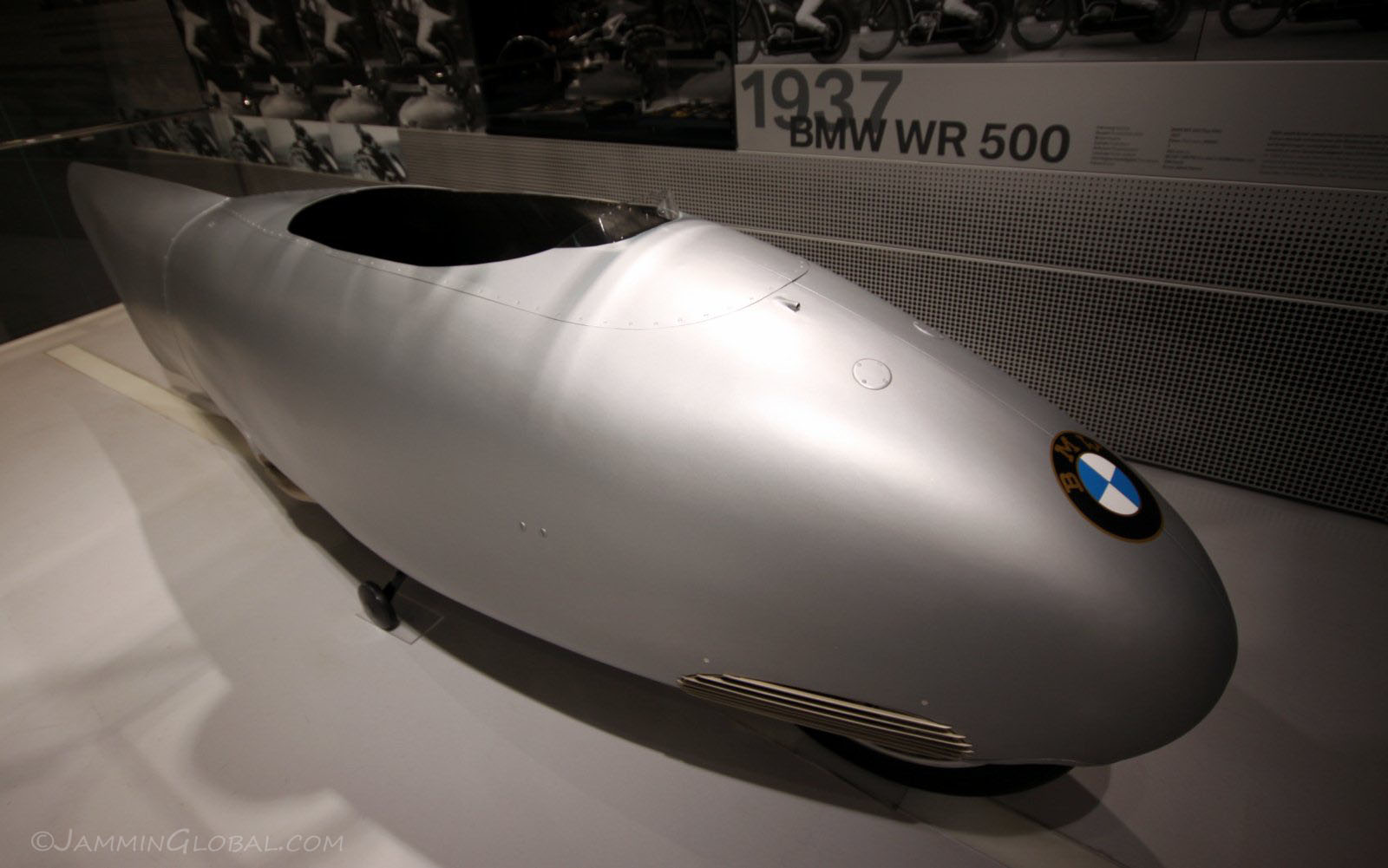
The 1937 WR 500, a streamlined motorcycle, nicknamed The Egg, which with its 500cc supercharged engine set a motorcycle world speed record in 1937 of 279.77 kph (173.88 mph). It was ridden by Ernst Henne and the record stood for 14 years.
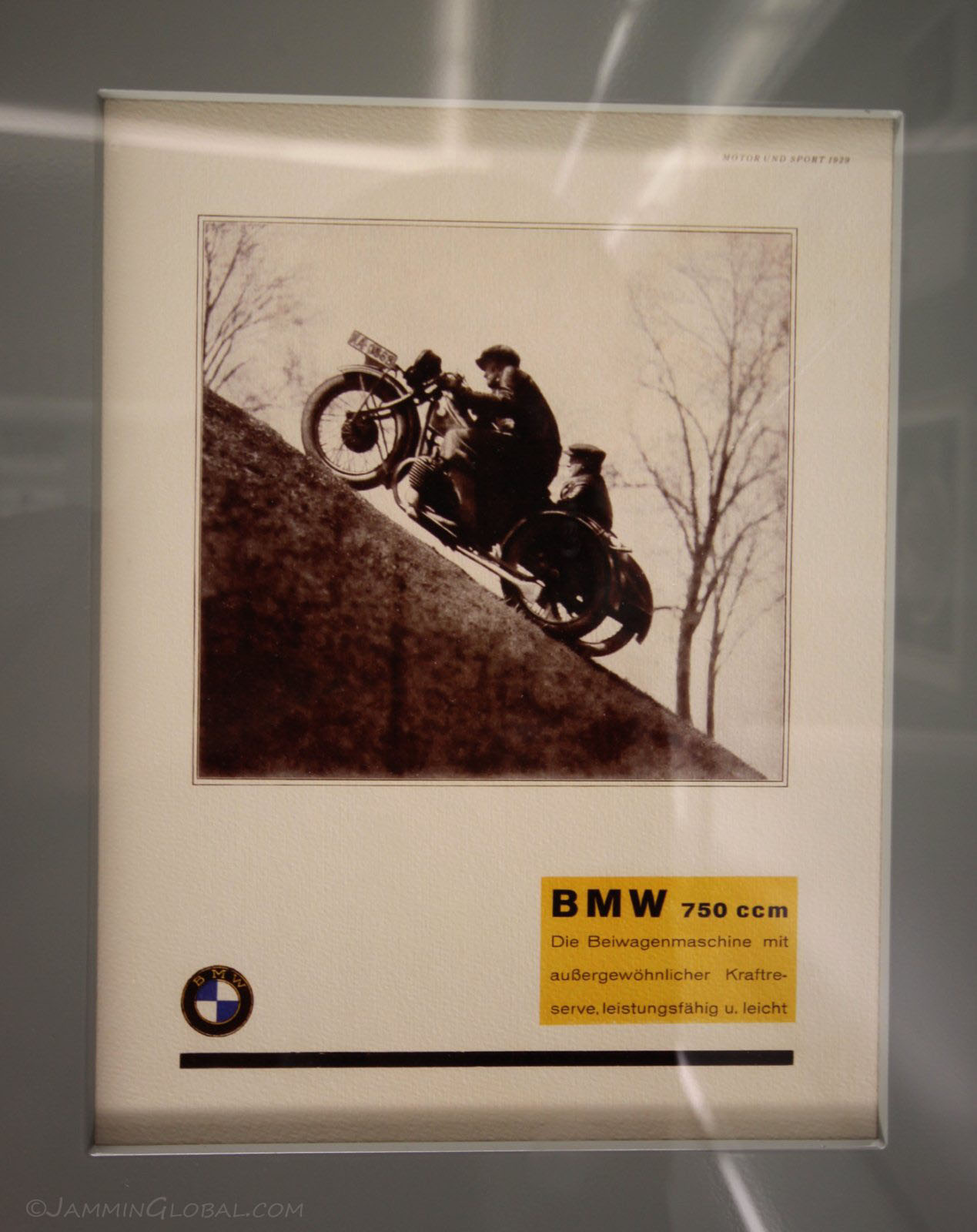
Hill-climb challenges were used since the early days to showcase the strength of engines. That's some serious grade there, coming close to 45 degrees.
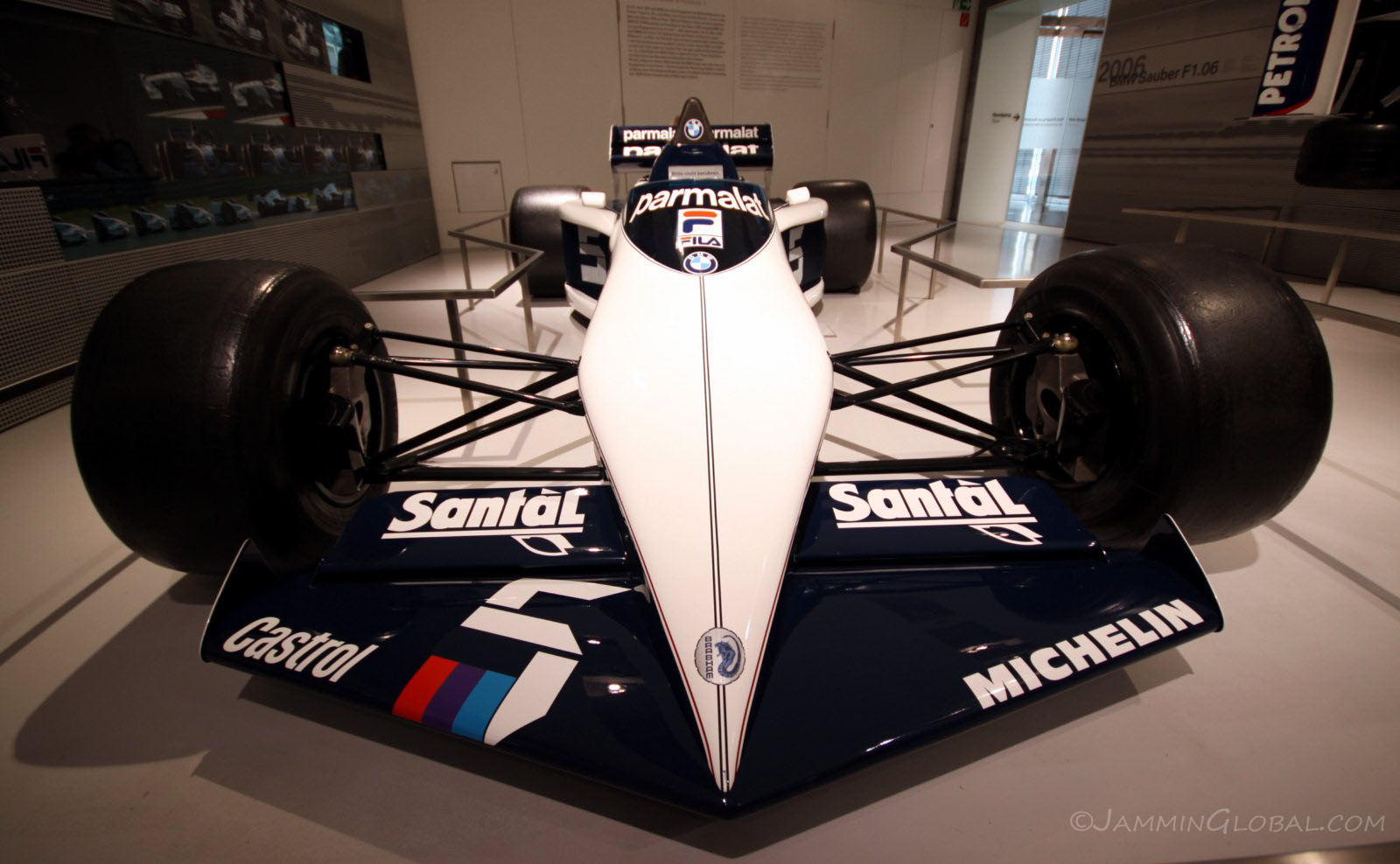
Another avenue of telling the world about your brand and letting them see for themselves your reliability and sportiness was to get into the top echelon of motorsport, namely Formula 1. It's a motor racing series that's been running since 1950 and the formula is a set of rules agreed upon by all the competitors, such as car length, engine configuration, etc. This is the 1983 Brabham BMW BT52 with its distinctive dart-shaped profile, powered by the awesomely powerful BMW M12/13 turbocharged inline 4-cylinder engine, which in this car made 850 hp but by 1986 was producing around 1,300 hp from a four-banger. Those were the days of unlimited engine tweaking. Nowadays, everything is very restricted. This was a good promotion for BMW's 4-cylinder engines in their production cars compared to Ferrari's V12s. This Brabham was designed by Gordon Murray, who then went on to design the legendary McLaren F1 road car.
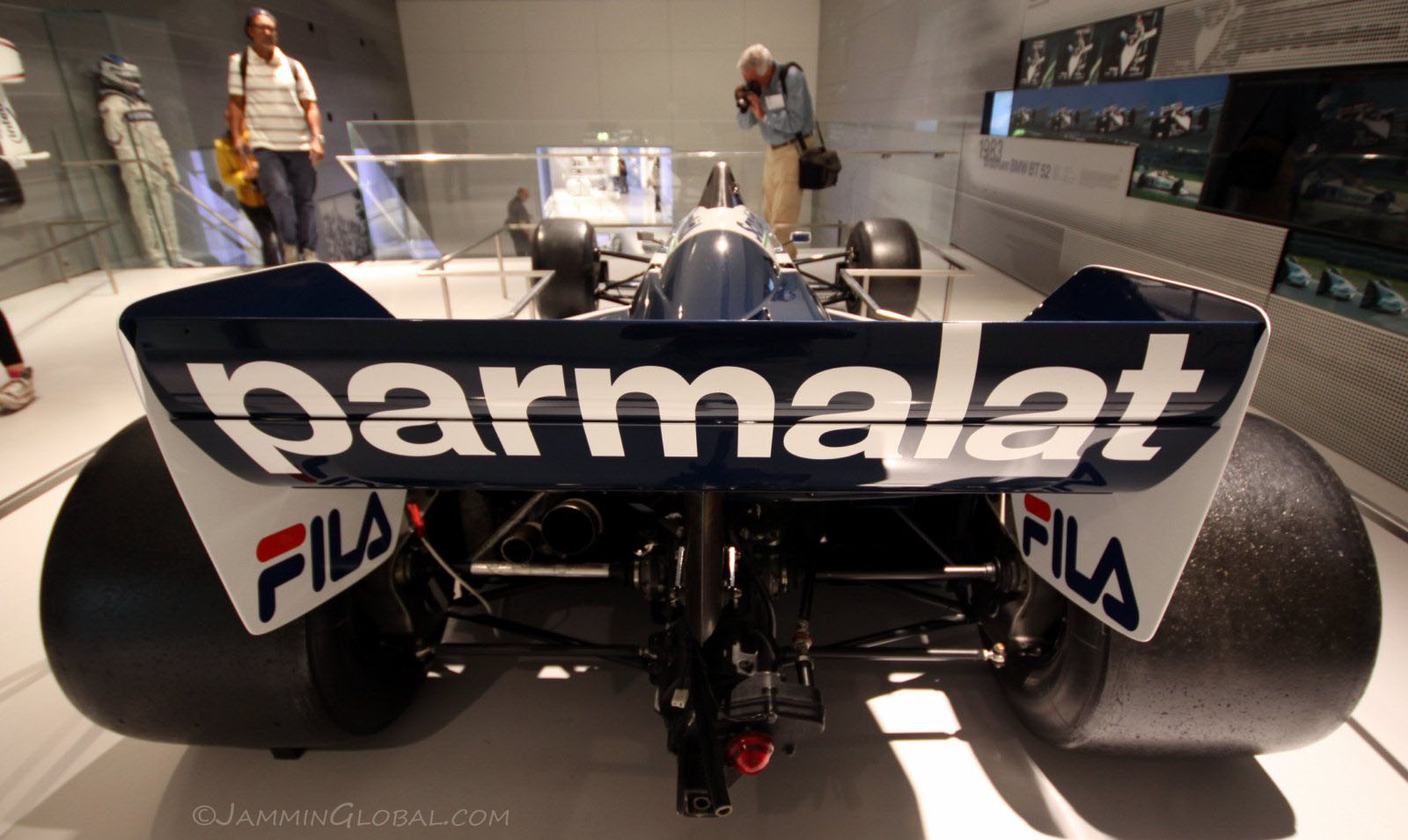
The rear of the car with its massive wing to generate as much downforce as possible. It's the same principle of an aircraft's wing, but flipped the other way so instead of generating lift to take off, it generates downforce to push the rear tires into the ground and stay in contact with the track as it rips around corners. Having test driven a Formula SAE car that I built during my college days at Purdue, I can attest to the addiction that downforce is, which I guess is the continued attraction to four-wheeled transport even though I am so deep into motorcycles. I don't discriminate, as the feeling of riding two wheels is different from that on four wheels. On a street motorcycle, you lean into the corner and become an integral part of the riding dynamics, while in a race car, you are stuck to the chassis and fight the g-forces (weight of gravity against your body) as your steer it through a corner. I love both feelings.
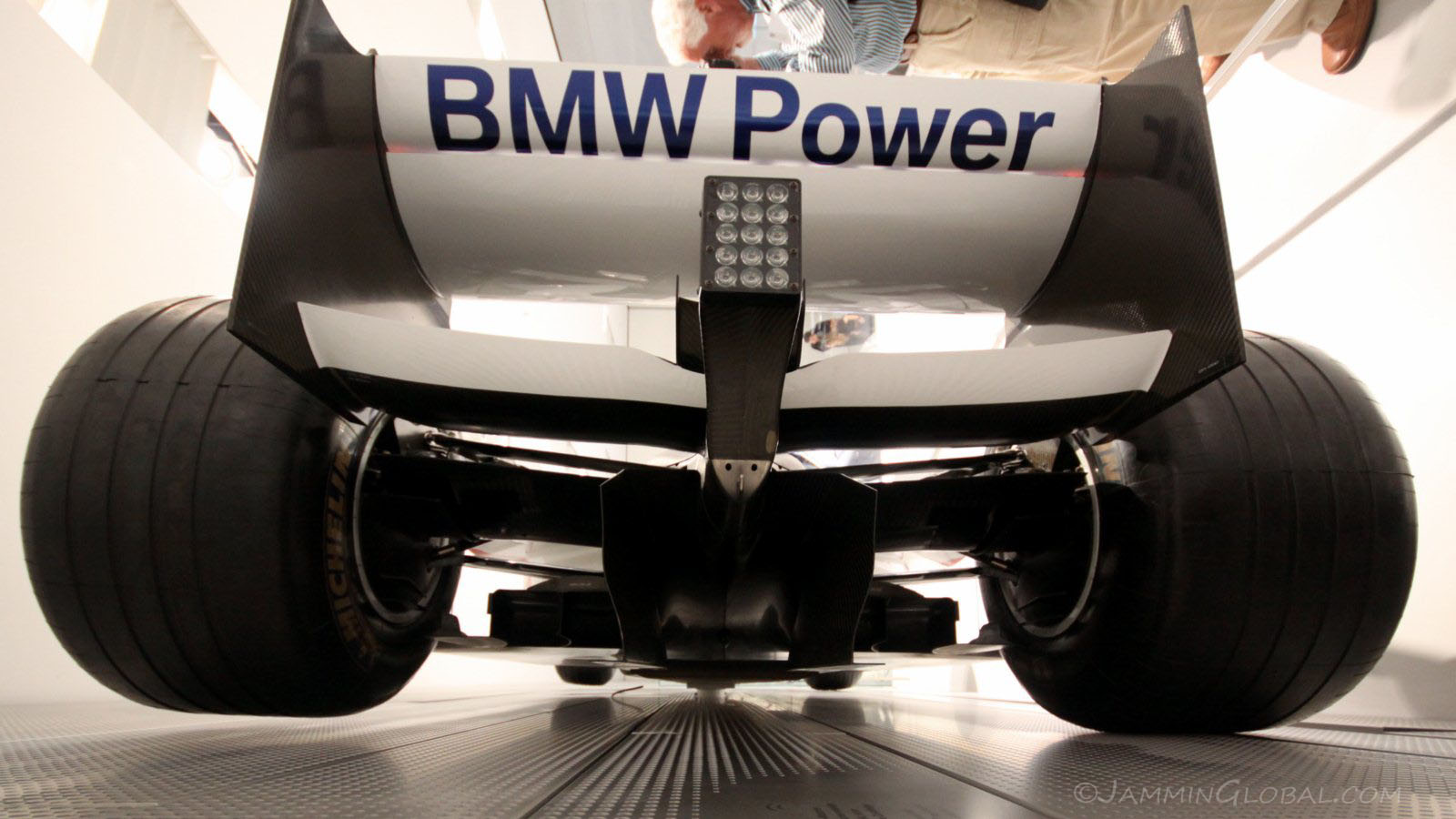
The clean rear end of the 2006 BMW Sauber F1 car, which highlights the importance that aerodynamic efficiency gained in the recent years of car development. With engine design being restricted in the name of cost, aerodynamics is currently the area where teams differentiate themselves. A clean underbody (you can see the flat floor and the front wheels) is crucial these days in creating as much downforce as possible. Regular road cars don't go anywhere near as fast, so the underside of regular cars is just a mess of engine, exhaust and suspension components.
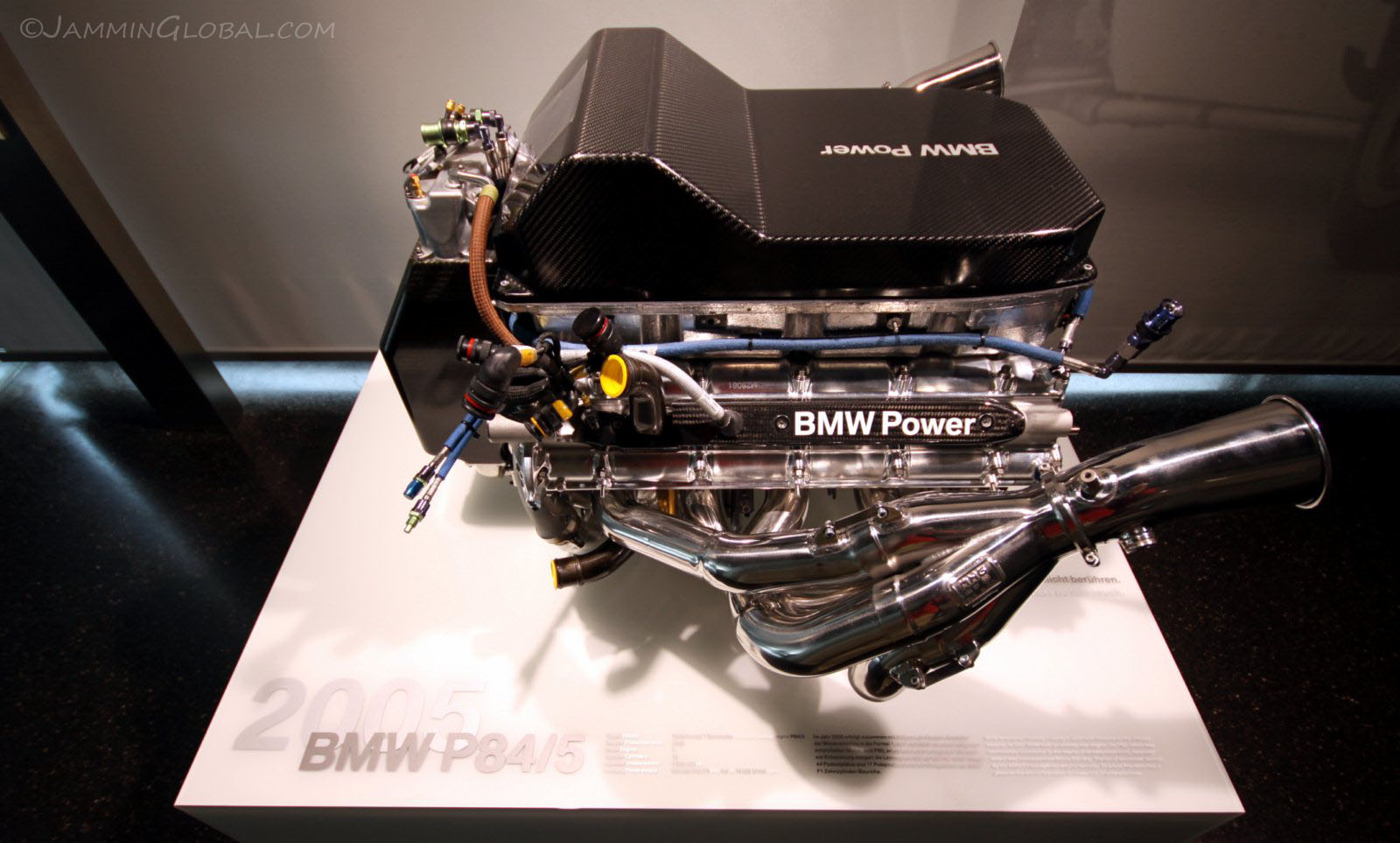
I then walked over to the engine alley with all the super motors from BMW's history on display. Being a mechanical engineer with a gear head passion, this is considered art to me. When I was young, I was just interested in the numbers, such as horsepower and torque, but after my education and learning how to tear down and rebuild an engine, the appreciation of the beauty within is much deeper. This is the BMW P84/5 F1 engine for the 2005 season. It's a 3.0 litre V10 making around 900hp at 19,000 RPMs, but it was detuned from the previous season for the sake of reliability that was forced on the teams.
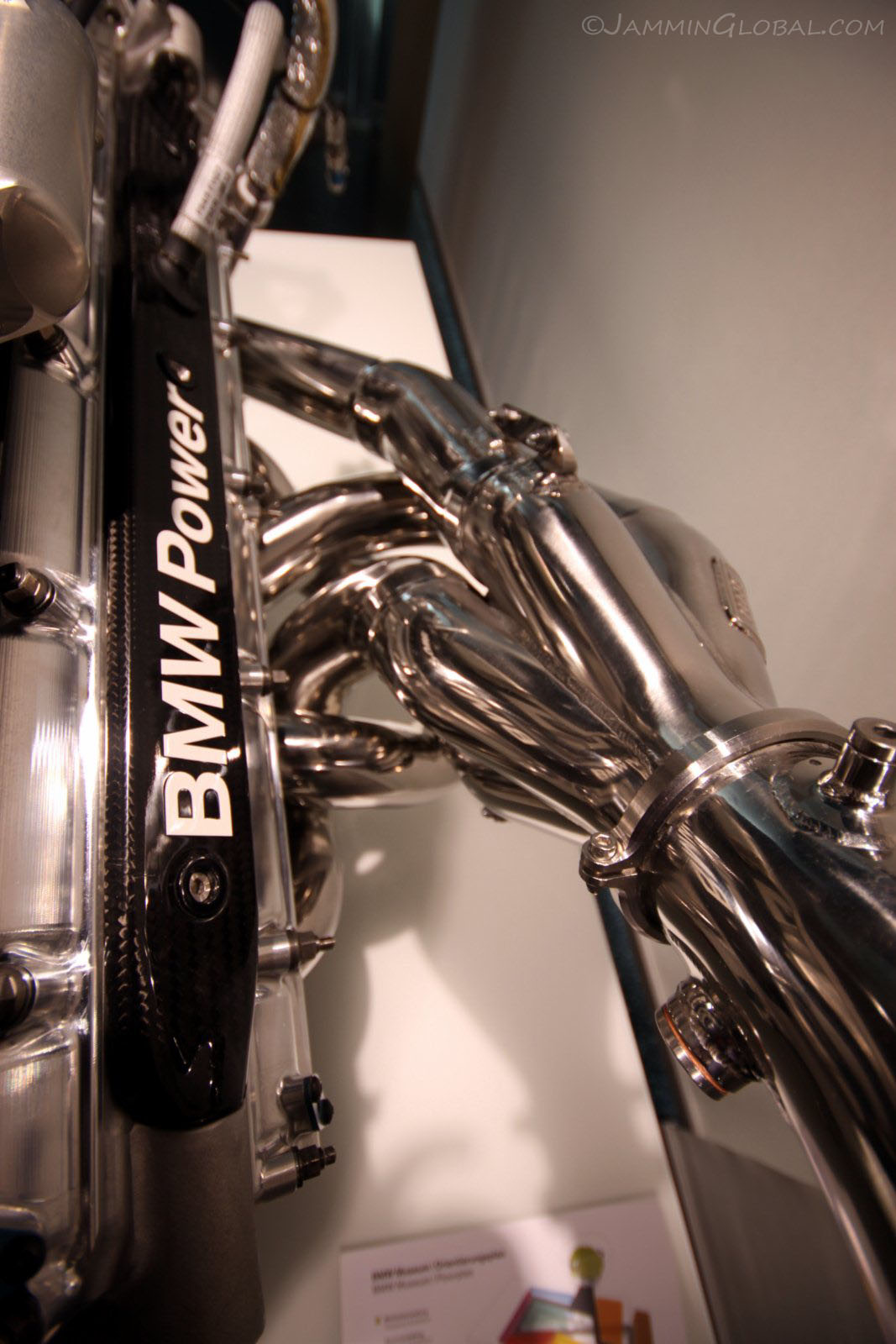
A fine example of the art of bending exhaust header pipes. Here, five exhaust headers are blended into one and to achieve a smooth running engine, the lengths of each exhaust header must be identical, taking into account all the bends. It's a complex science, first simulated on the computer and then skillfully hand-crafted in reality by specialists.
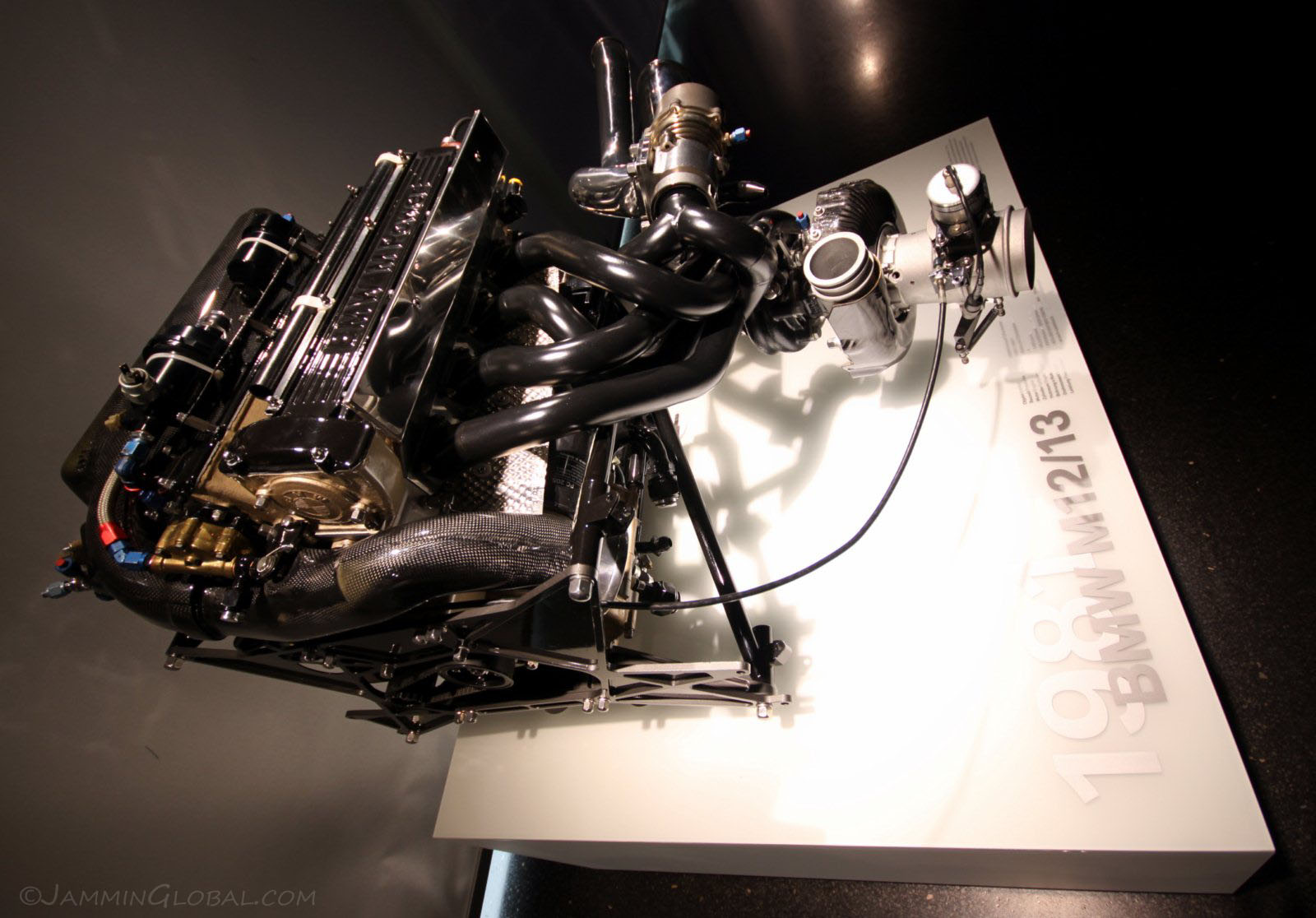
The famous BMW M12/13 (mentioned above in the earlier Brabham Formula 1 car), considered the highest ouput per cylinder ever produced for a car. In its peak configuration, it made about 1,450 horsepower from a 1.5L four-cylinder turbo engine; that's 362.5 hp per cylinder with each cylinder having a capacity of 375cc. Comparing that to the current most powerful road engine in the Bugatti Veyron EB16.4, which makes 1001 hp from a 16 cylinder quad-turbo engine with a capacity of 8L (translating to 62.5 hp per cylinder from 500cc), it makes one realize the technical supremacy that was achieved with the little M12/13 engine. Of course, it was built for a specific purpose and had to be rebuilt after every race, but still, wow. The engine is on the left side and the massive turbo lies on the right.
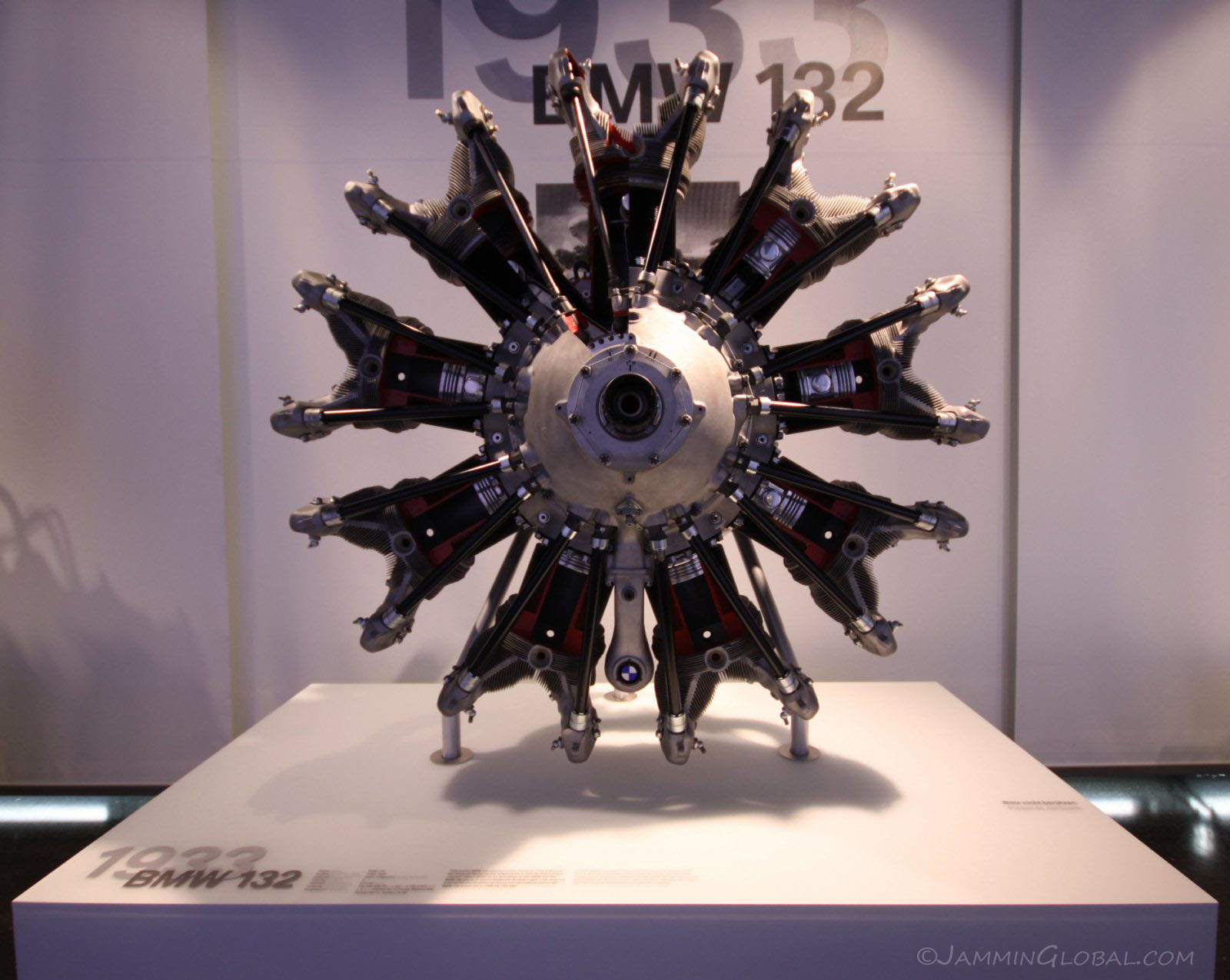
The BMW 132 9-cylinder radial aircraft engine that was used heavily by the Luftwaffe during World War II. The chairman of the company at the time, Fraz Josef Popp, tried to stop the company from becoming a war supplier because after supplying aircraft engines to the German army in World War I and with their subsequent defeat, BMW's survival was at stake as when the engine orders stopped, the company's lifeline was cut. Popp knew the war would end at some point and the orders would stop again, but the Nazi government demanded almost all of his production facilities to be converted to building aircraft engines. And to support the increased production, the Nazis supplied forced labor from concentrations camps (such as Dachau) to work in the factories. BMW regrets this period in their history and there was a section of the museum dedicated to telling this story. They've since compensated the surviving workers.
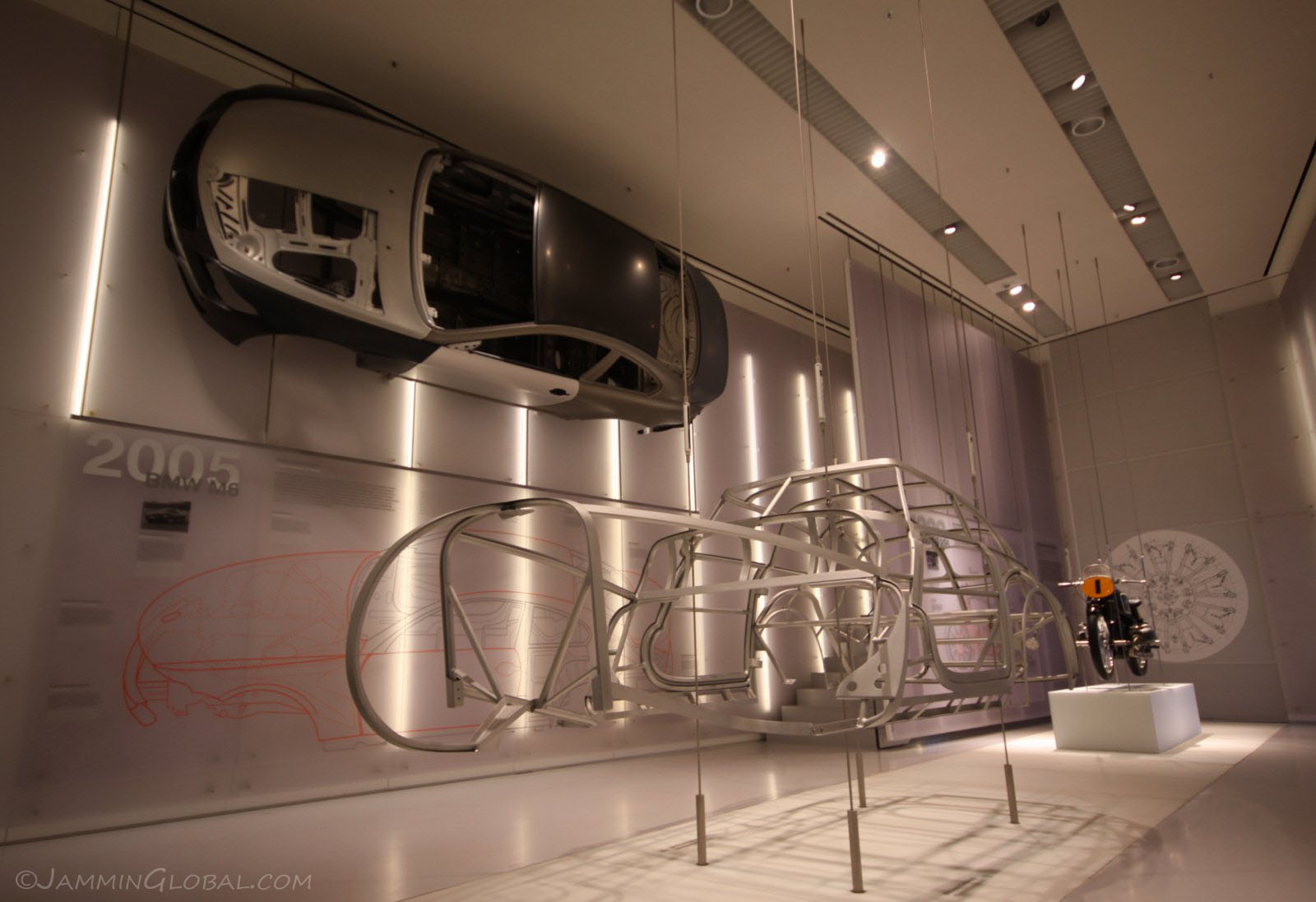
The hall of production, showing their aluminum body construction.
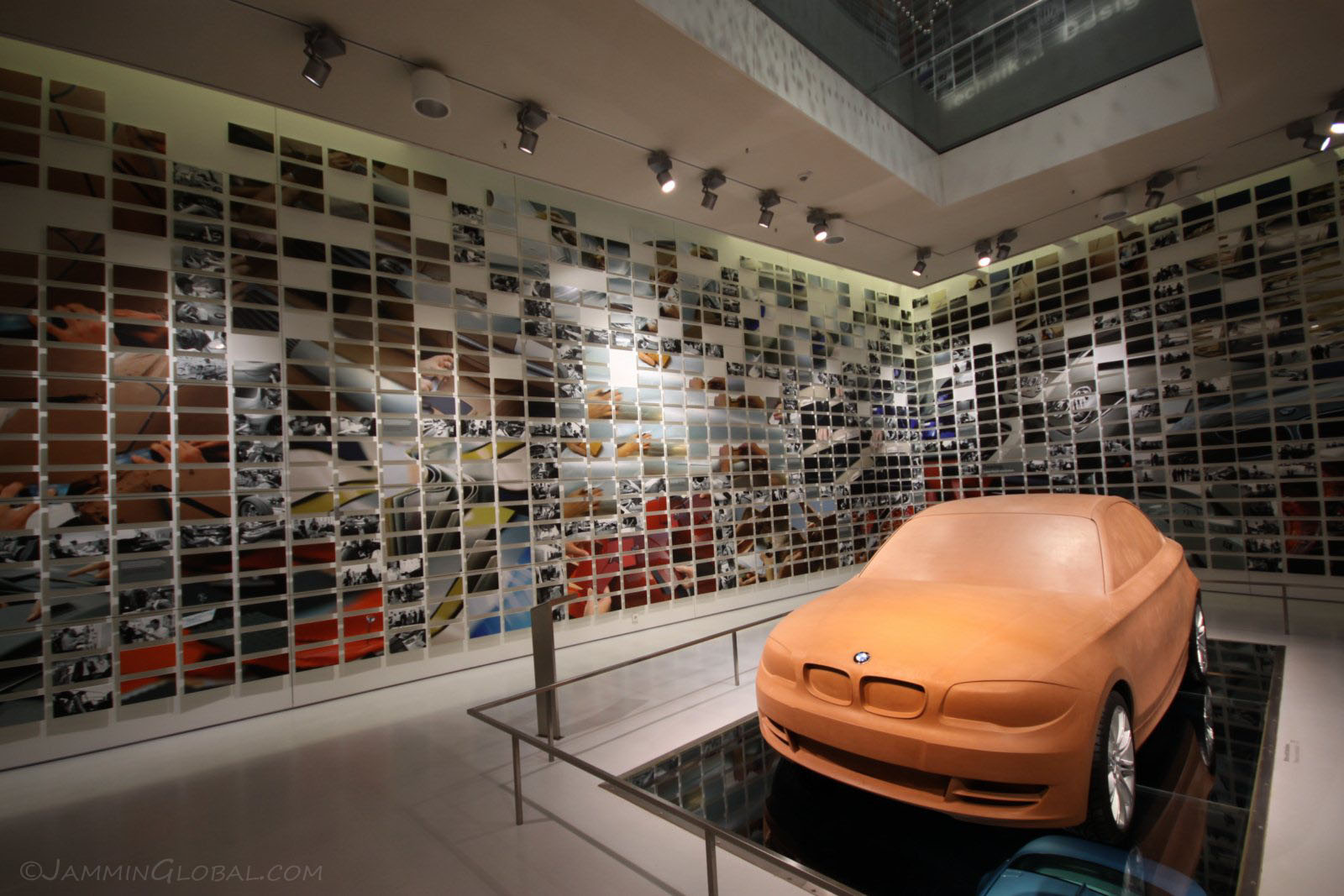
The hall of design, showing how a car is translated from concept to clay model before building a prototype. This is a clay model of the 1 series.
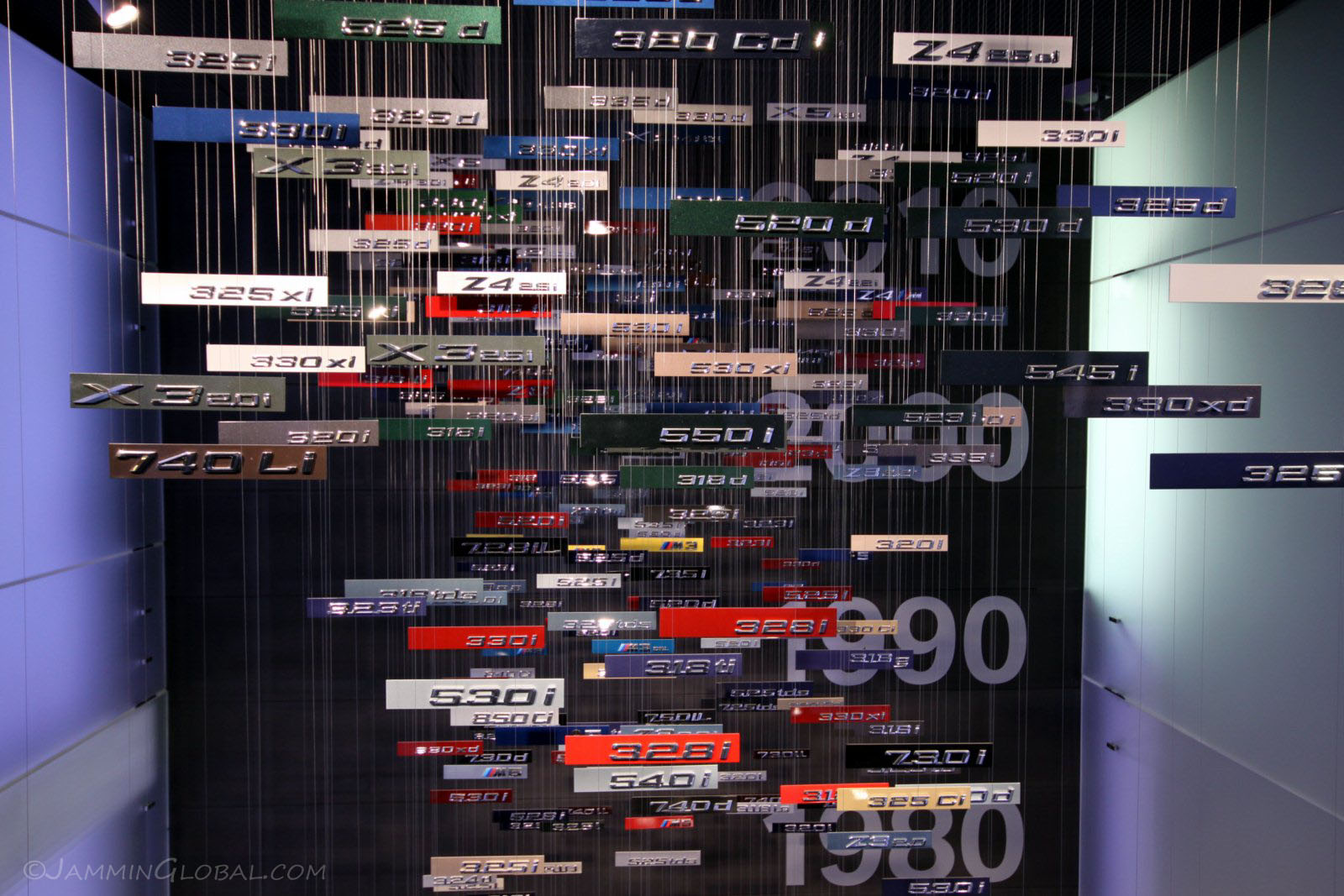
A timeline display of BMW's trunk emblems. This is another reason why I've liked the company: sticking to simple yet meaningful designations of their models. A 325i (a car I owned) signifies a 3-series car with a 2.5L engine with fuel Injection. However, lately they've been straying slightly from this due to marketing pressures.
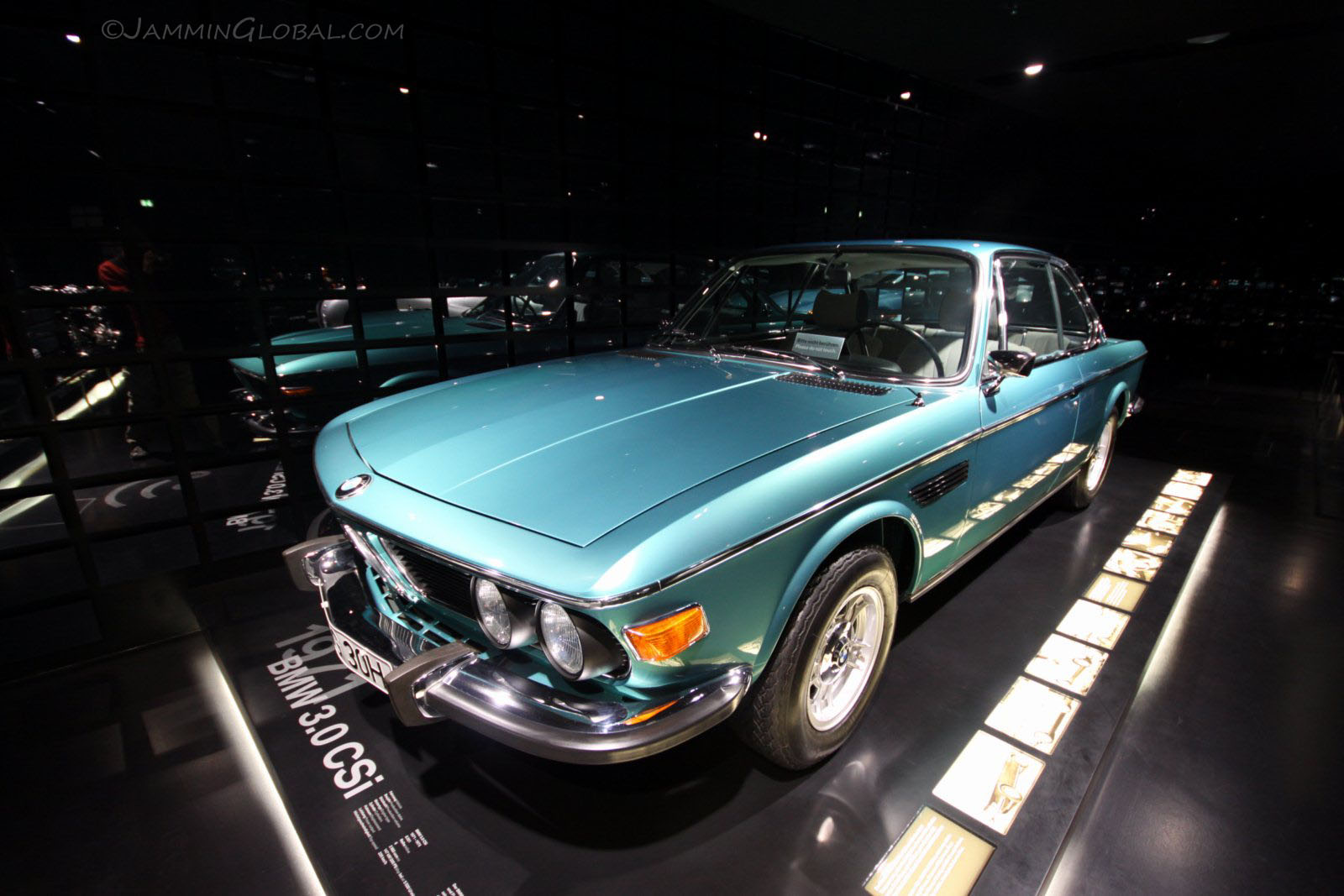
At one end of the museum was The Vault, showcasing the design stars of the company. This is the eternally beautiful BMW 3.0 CSi, highly revered by car collectors for its simple, yet elegant lines. This car's design will still be appreciated a 100 years from now.

Moving into the motorsports hall and marveling up close at the 1975 BMW 3.0 CSL (the race car version of the previous car), known as the Batmobile, due to its wide bodywork. Besides building engines for other race series, such as Formula 1, BMW's reputation for a solid handling chassis were showcased in their countless wins in production car racing, especially with the CSL. The early days of BMW's racing also cemented their motorsport colors, the bands of light and dark blue, followed by red. The light blue represented the blue from the Bavarian flag and in the early days, Texaco was a major partner of BMW and the red represented them and the color in-between was used for a transition. However, nowadays, BMW says that red is supposed to represent motor racing.
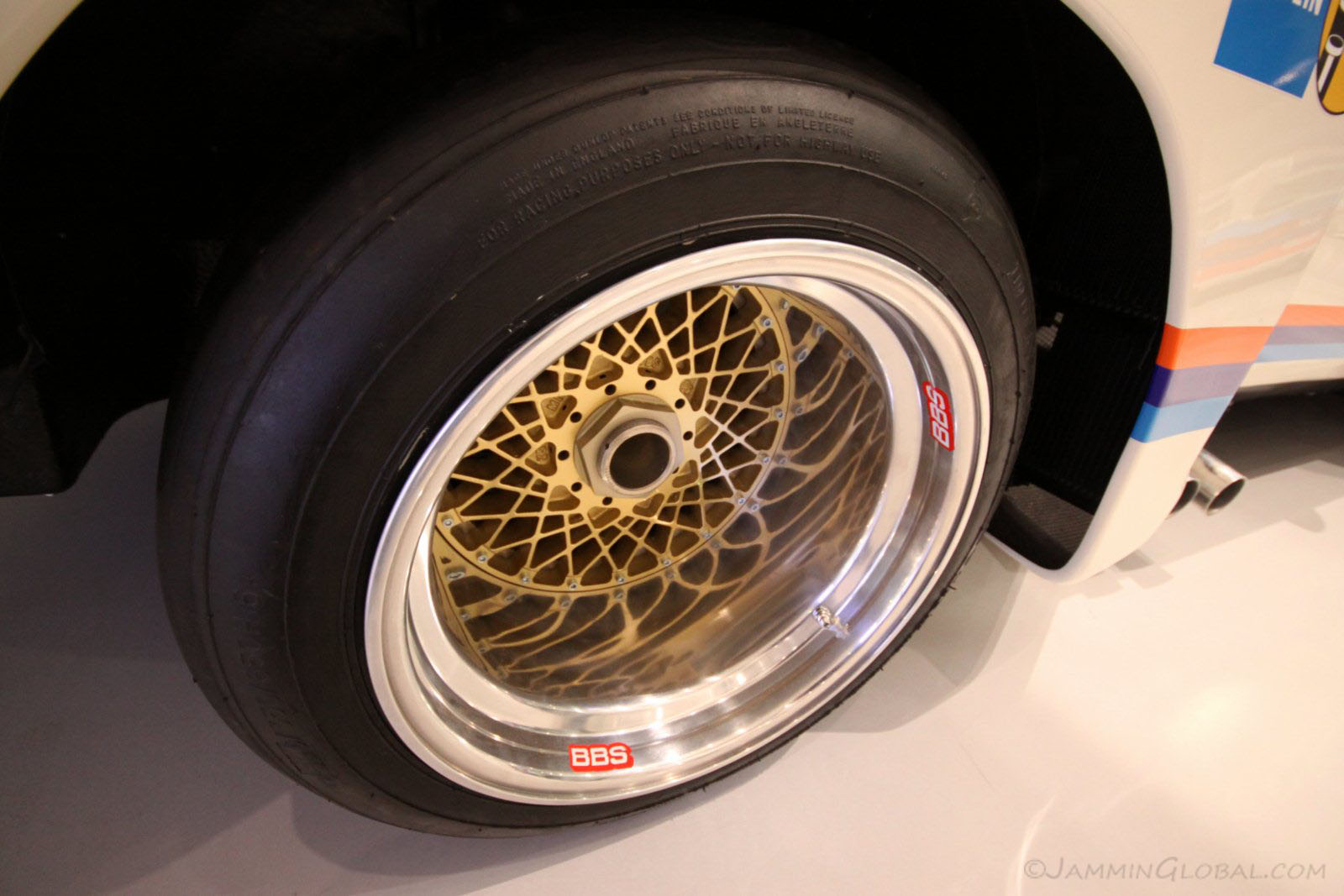
The original deep-dish BBS wheel rims, with the hub (golden part) set in about 20 cms (8 in) from the lip of the rim. This allowed them to use shorter axles, for better control, while using the widest tire possible for maximum grip. Nowadays, these kind of rims are pranced about on hip-hop stars' SUVs.
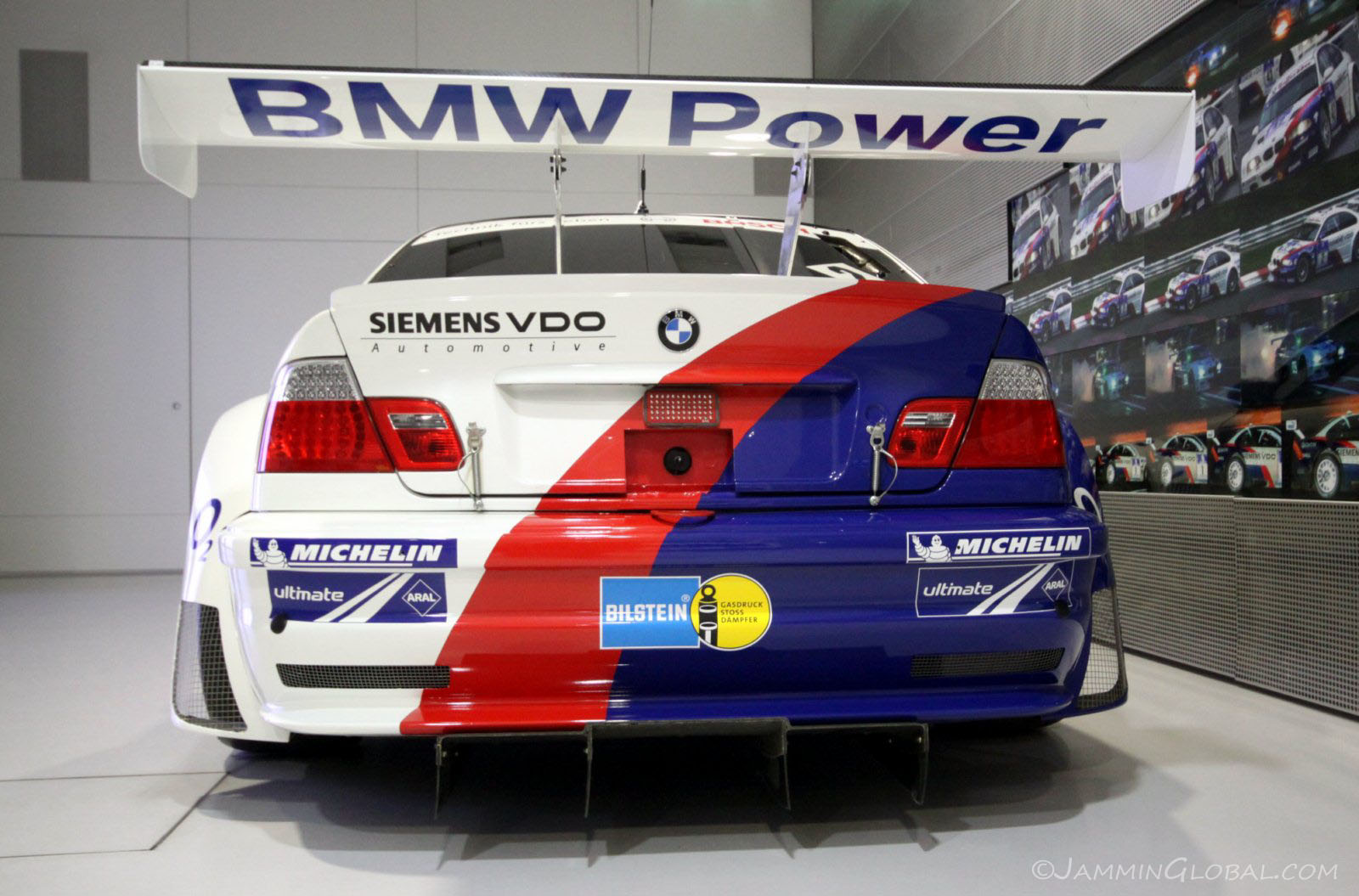
The BMW M3 GTR sporting a massive rear wing and an under tray rear diffuser (the slats below the bumper). This signifies a flat floor under the car, like Formula 1 race cars, to reduce the disturbance to the air as it passes under the car. More turbulent air creates a bigger aerodynamic profile, meaning the car meets more resistance the faster it goes.
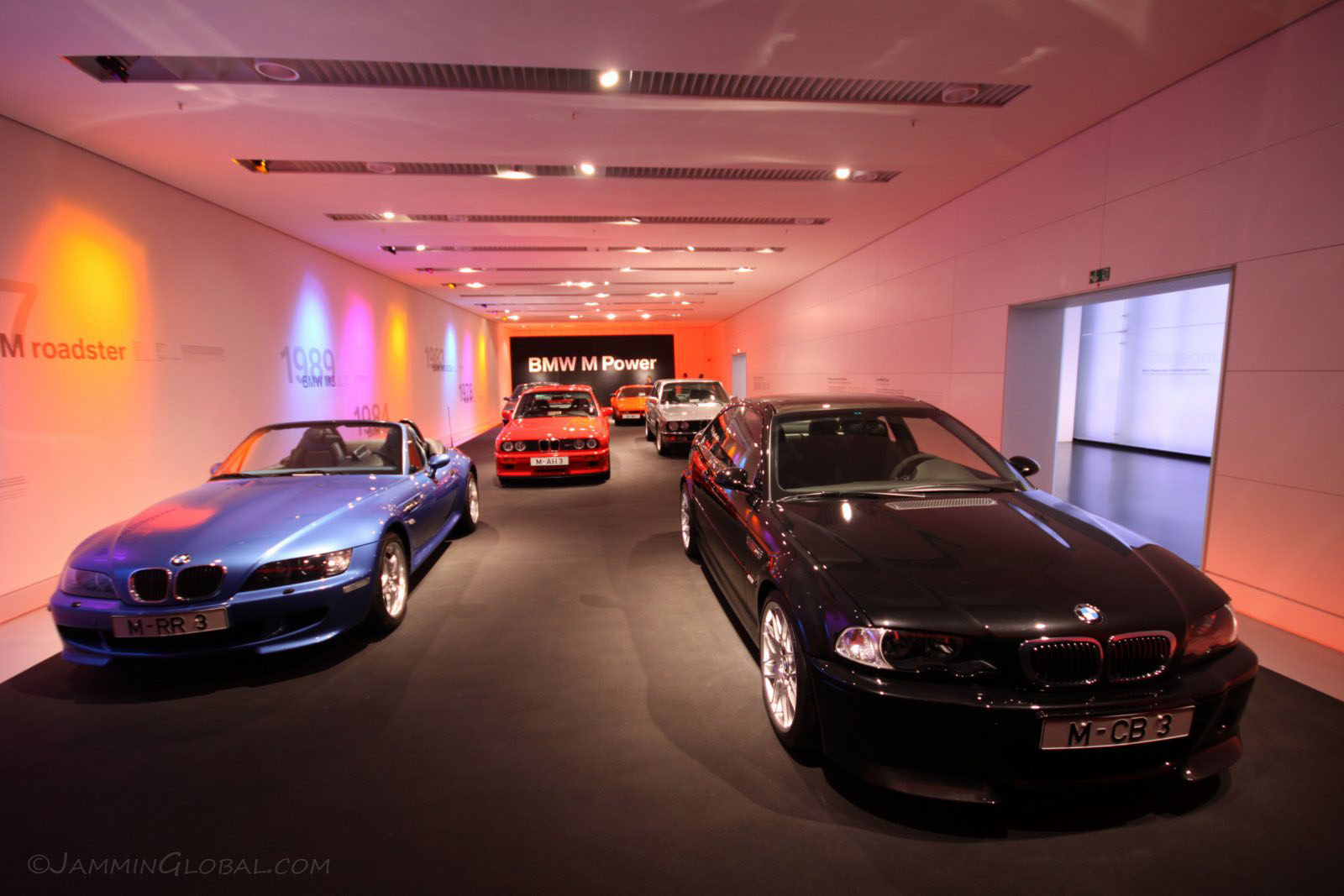
From the motorsport hall, I flowed into the next logical place, my favorite side of BMW, it's M division. M stands for motorsports and signifies the highest performing of their production cars in each class. So, for the 3-series, the black M3 up front would be the highest performer in that series. For the 5-series, it was the M5 and so on. Besides having a more powerful engine, the M cars have more racy suspension and handling dialed in, making them more of a driver's car, as opposed to the luxury that the casual up-market buyer is looking for. These cars cemented BMW's reputation for making real sport sedans. Any car wearing the M badge has been tested and tuned at the Nurbrugring racing circuit, where BMW keeps a permanent testing facility. In my view, other high-end manufacturers make luxury cars with some sportiness thrown in, while BMW makes sporty cars with some luxury thrown in. I'm clearly biased here.
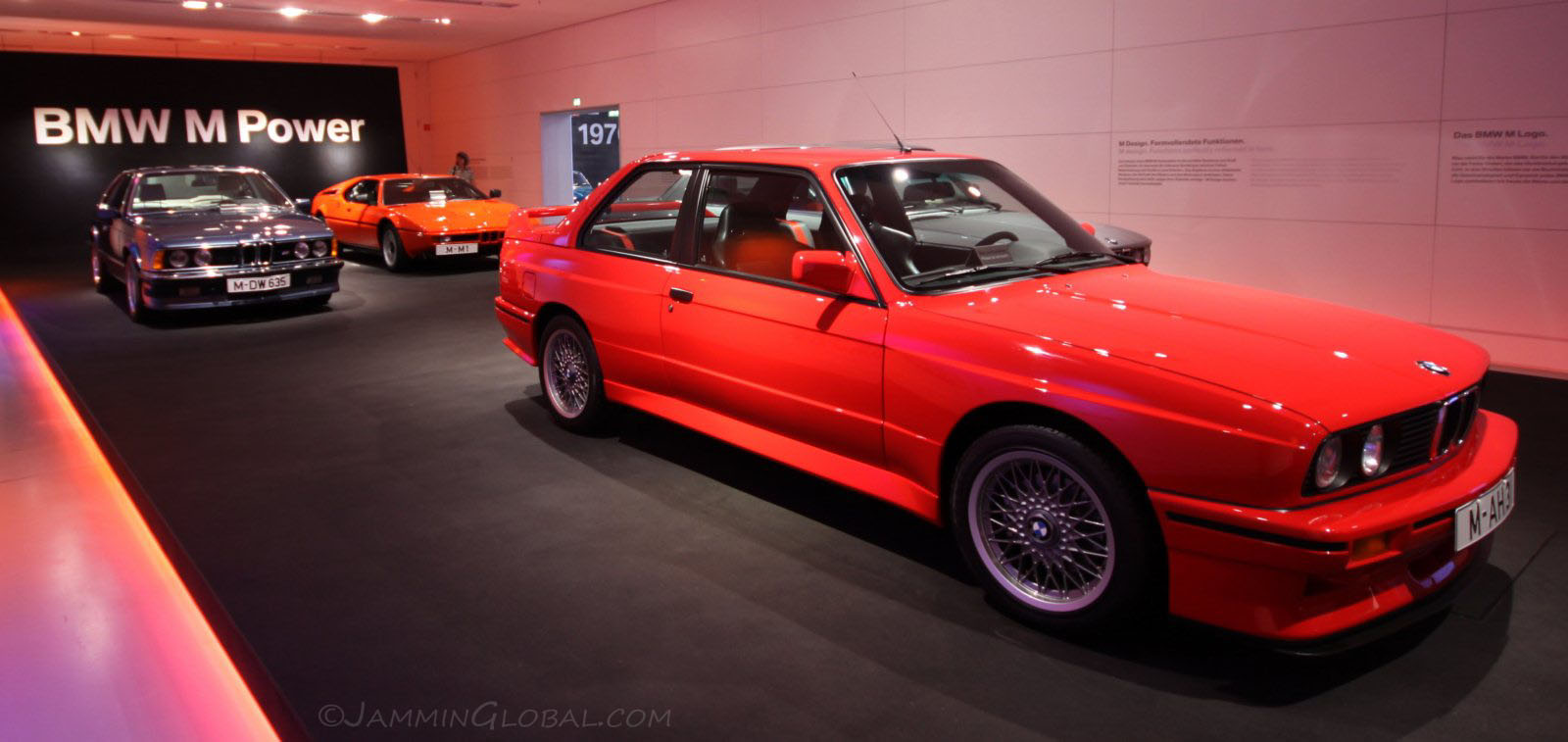
A bit back in time and one car of my dreams, the E30 BMW M3 from 1989, which showcased simple design with a powerful engine and superb handling. Behind her are the original M cars, the 1984 M5, 1983 M635CSi and the 1978 M1.
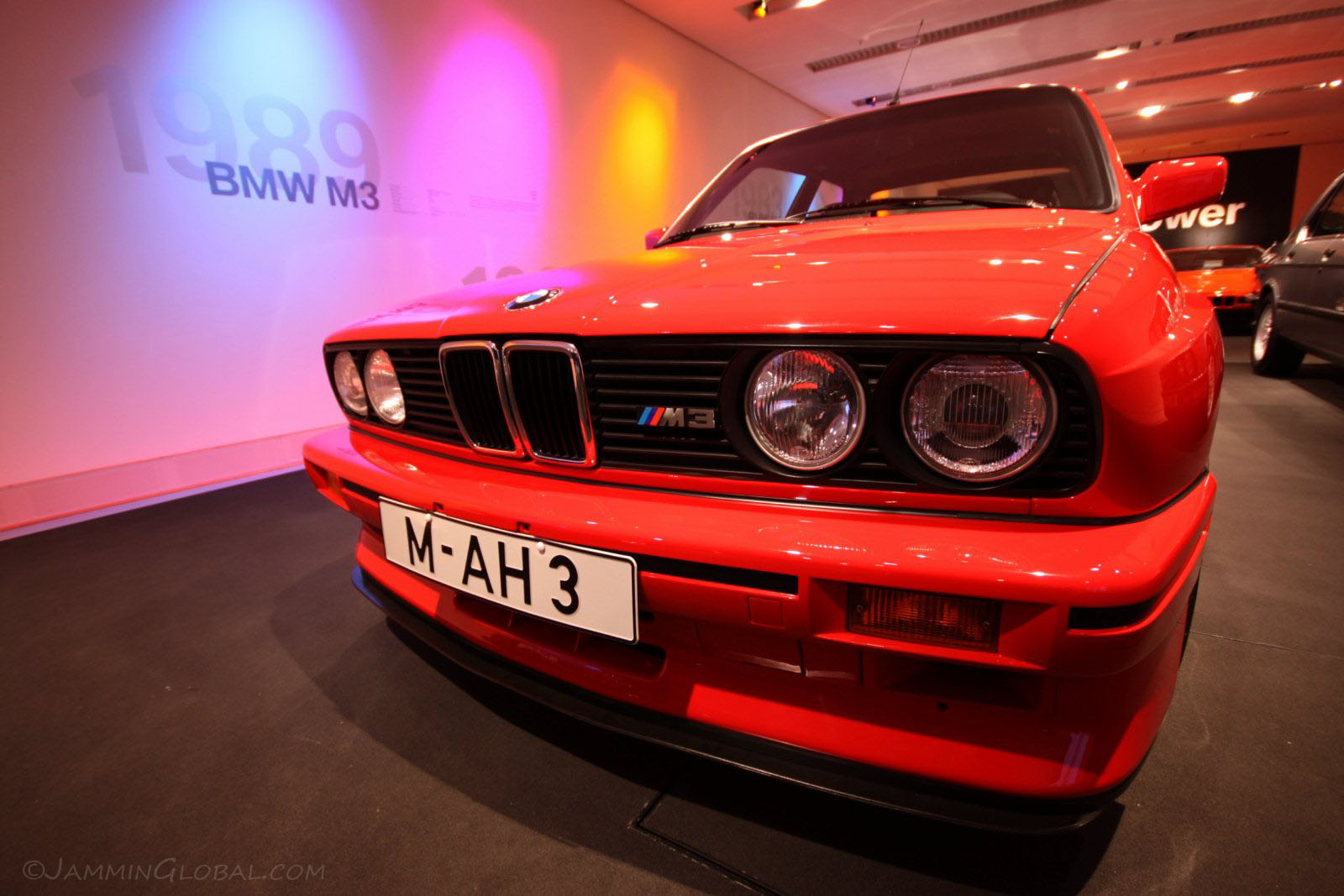
A shot of this simple, yet butch-looking front end, which displays the traits of most BMW's, namely the double kidney grill sandwiched by twin headlights. The company has tried to keep this common trait through all its cars but the headlights are now merging into one unit, but the double kidney grill will live on.
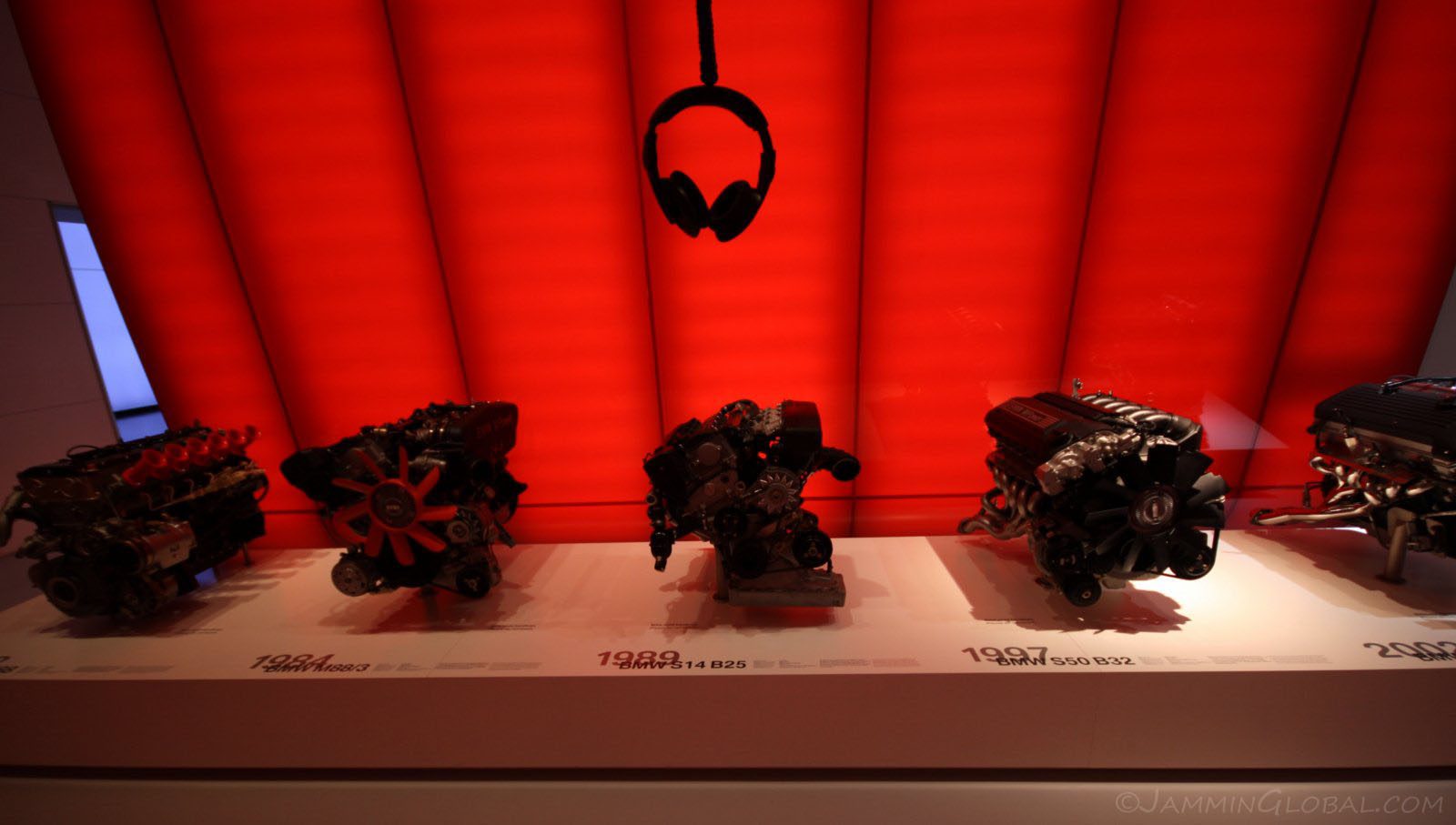
More exciting than the cars up front was this M engine sound display in the back with headphones hanging from the ceiling of each engine racing through its revs as it motored through some twisting curves. I think I spent about 20 minutes there, listening to each display with my eyes closed and feeling the gear changes as I drove these imaginary M cars. There was a similar display at the launch of the new E90 BMW M3 at the Chicago Auto Show with the engine racing through its rev and my friends had to come back and get me as I was so enthralled by those primal auditory waves.
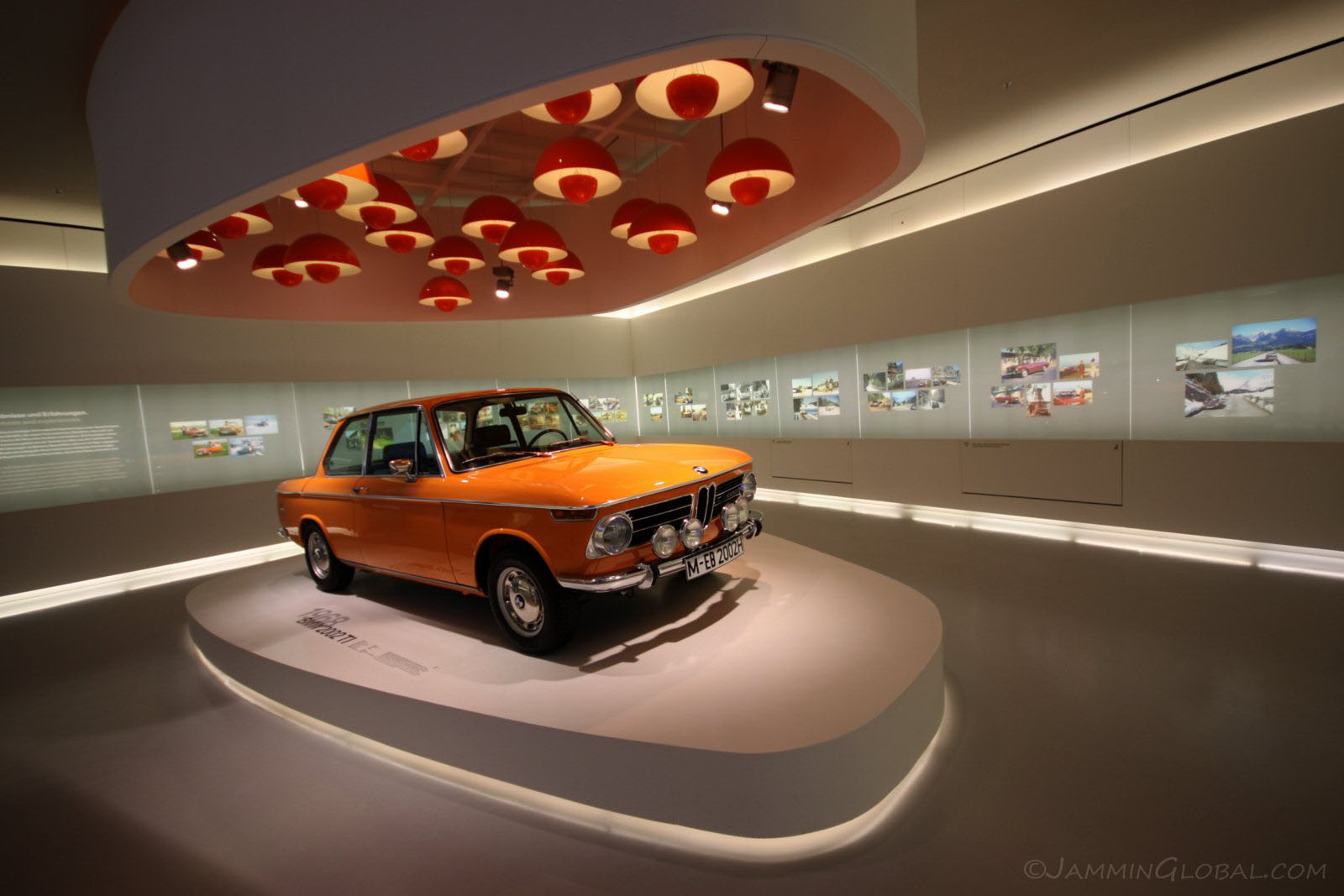
The car that started BMW's resurgence in the compact, sports car segment, the 1968 BMW 2002Ti. Besides looking quite chic (even today), it was lightweight with a strong enough chassis and 2.0L engine to provide responsive driving in a family-looking car and cemented BMW's place in the US as a maker of sporty cars. This car is credited with inventing the category of compact sporting sedans, which are now very popular is numerous car companies around the world and it's the predecessor of the 3-series.
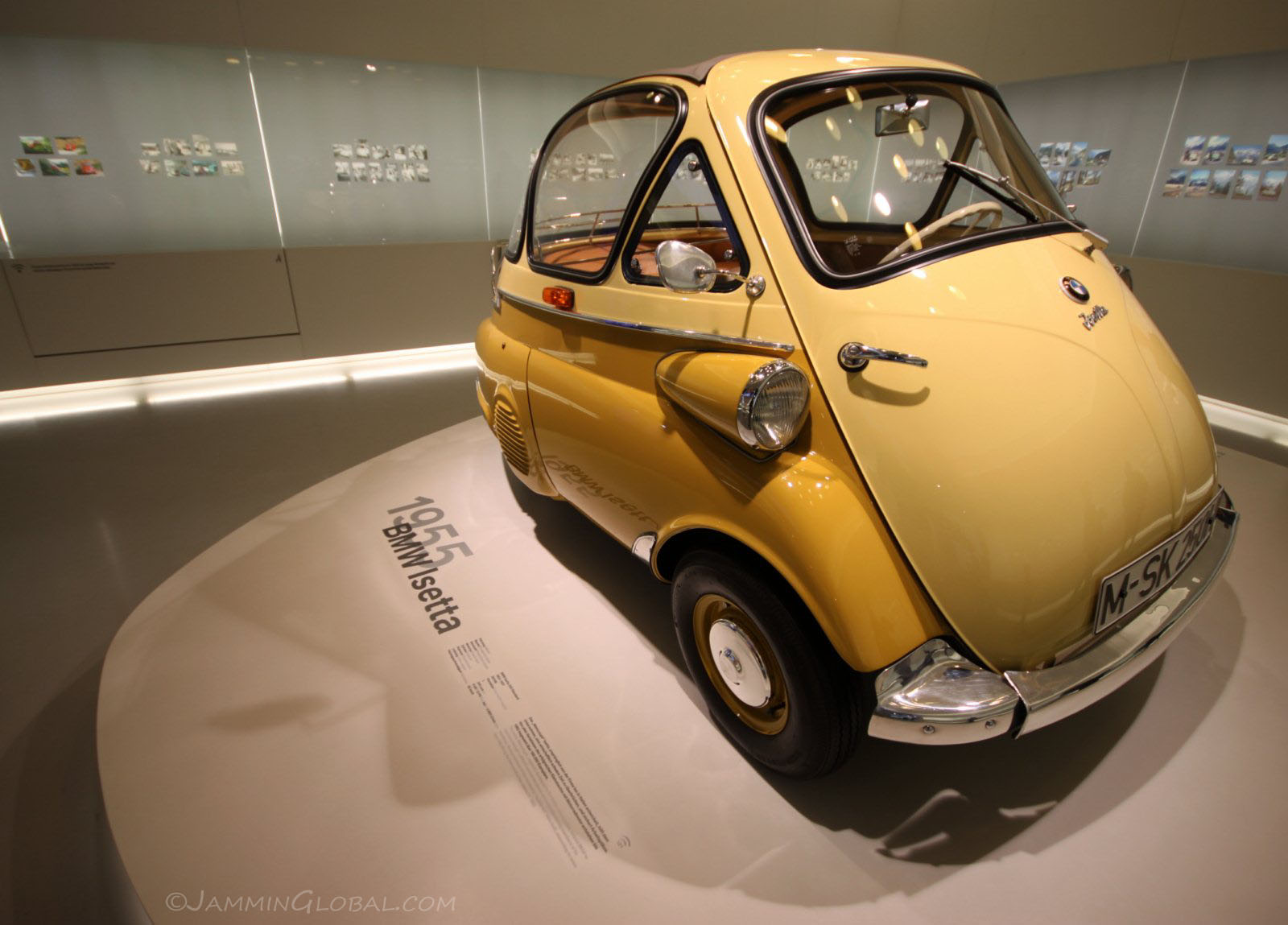
The cutesy Isetta, an odd-ball in BMW's history, but this little bubble car saved the company, when times were tough after the end of World War II. Since BMW made aircraft engines for the Nazi government, they were banned by the Allies from producing automobiles for three years after the war. The company survived by producing bicycles and kitchen supplies and slowly got back into motorcycles and then into cars by 1952. The design for the Isetta came from an Italian company, Iso who wanted to make a micro car for the city and their innovative design revolved around the whole front of the car being the only door, which swung out with the steering wheel and dashboard to allow ingress. This allowed them to make a very short car, which was ideal for parking. I had a Mini Cooper in the US and the shortness was very handy when trying to find parking in the city. BMW licensed production from Iso to produce the Isetta for the German market and get their automobile production going again. It had a motorcycle's single cylinder engine, making 13 hp and was renowned for its fuel efficiency of 3 liters/100 kms (77.6 mpg), and it was chain driven.
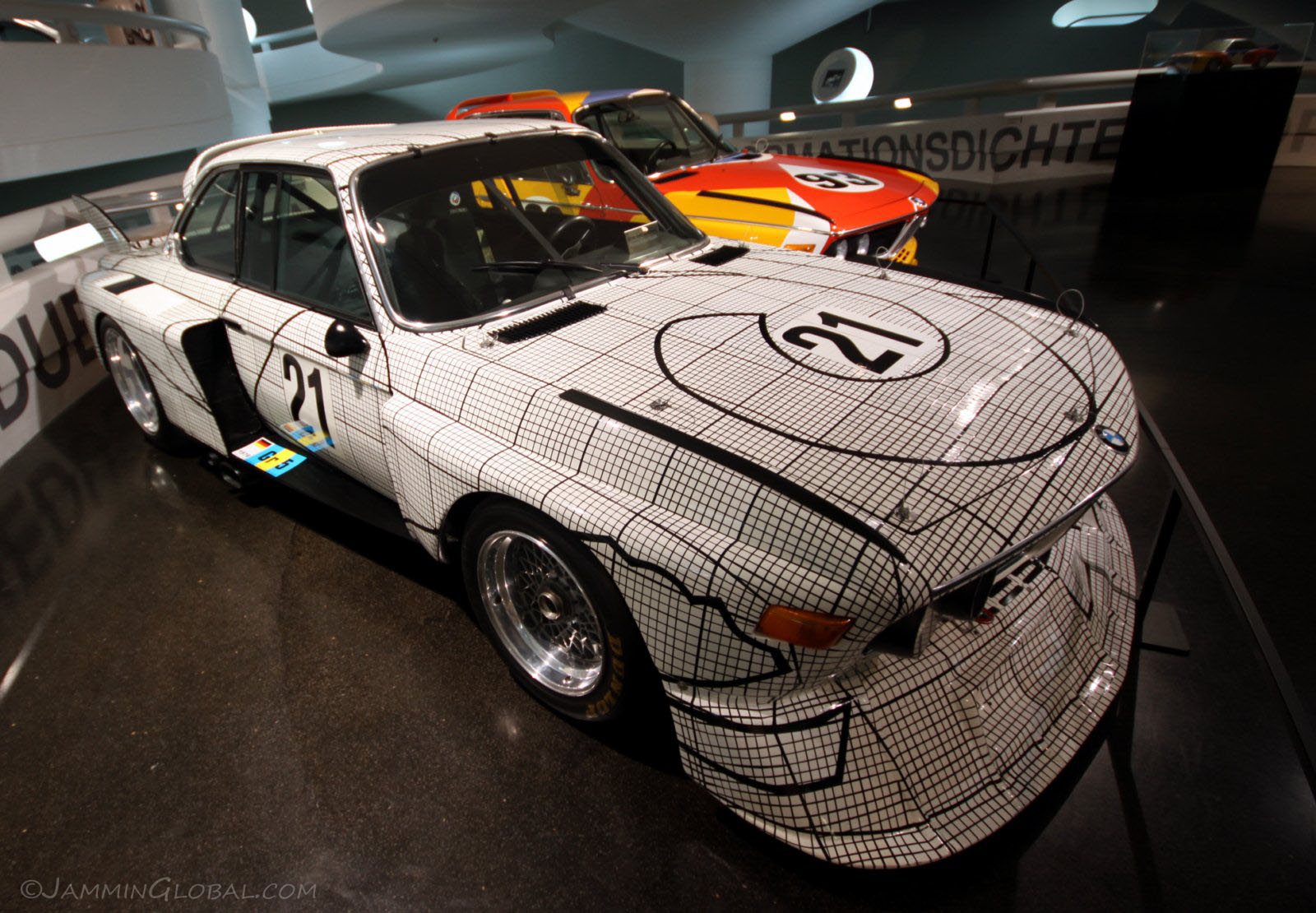
After seeing the regular part of the museum, I climbed back up above ground and into the raised bowl for a special exhibition of BMW's Art Cars. I had timed my visit to Munich just right since all 17 of the Art Cars were on display back at home. The Art Car project started when French racing driver, Hervé Poulain invited Alexander Calder to use his race car as a canvas for a painting. Poulain then went on to race the car in the 24 hours of Le Mans endurance race. This started a program at BMW of artists being invited to paint special cars, which were usually raced and then put on display in various museums around the world. This is Art Car #2, designed by Frank Stella in 1976 using a BMW 3.0 CSL. The graph paper design was used by Stella to capture the precision of motor racing.
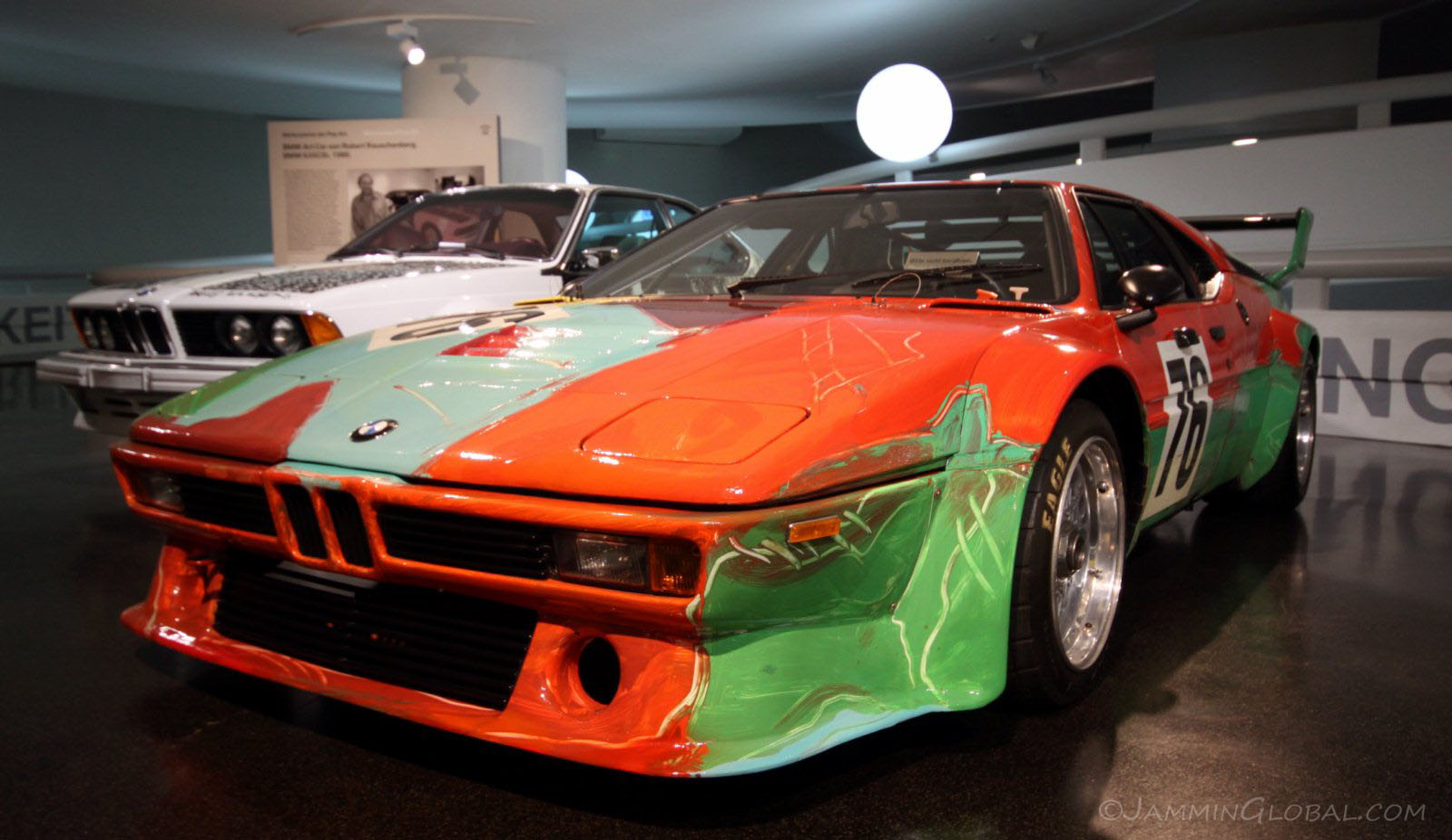
Art Car #4, Andy Warhol's 1979 BMW M1, probably the most famous of the Art Cars. Warhol said he wanted to depict speed by his colors and when the car was seen at high speed the colors would all merge. A unique thing about this car was that Warhol painted it himself, compared to most other cars that were designed by artists and given to others to put the paint to the metal. This M1 went on to race in Le Mans and placed sixth overall.
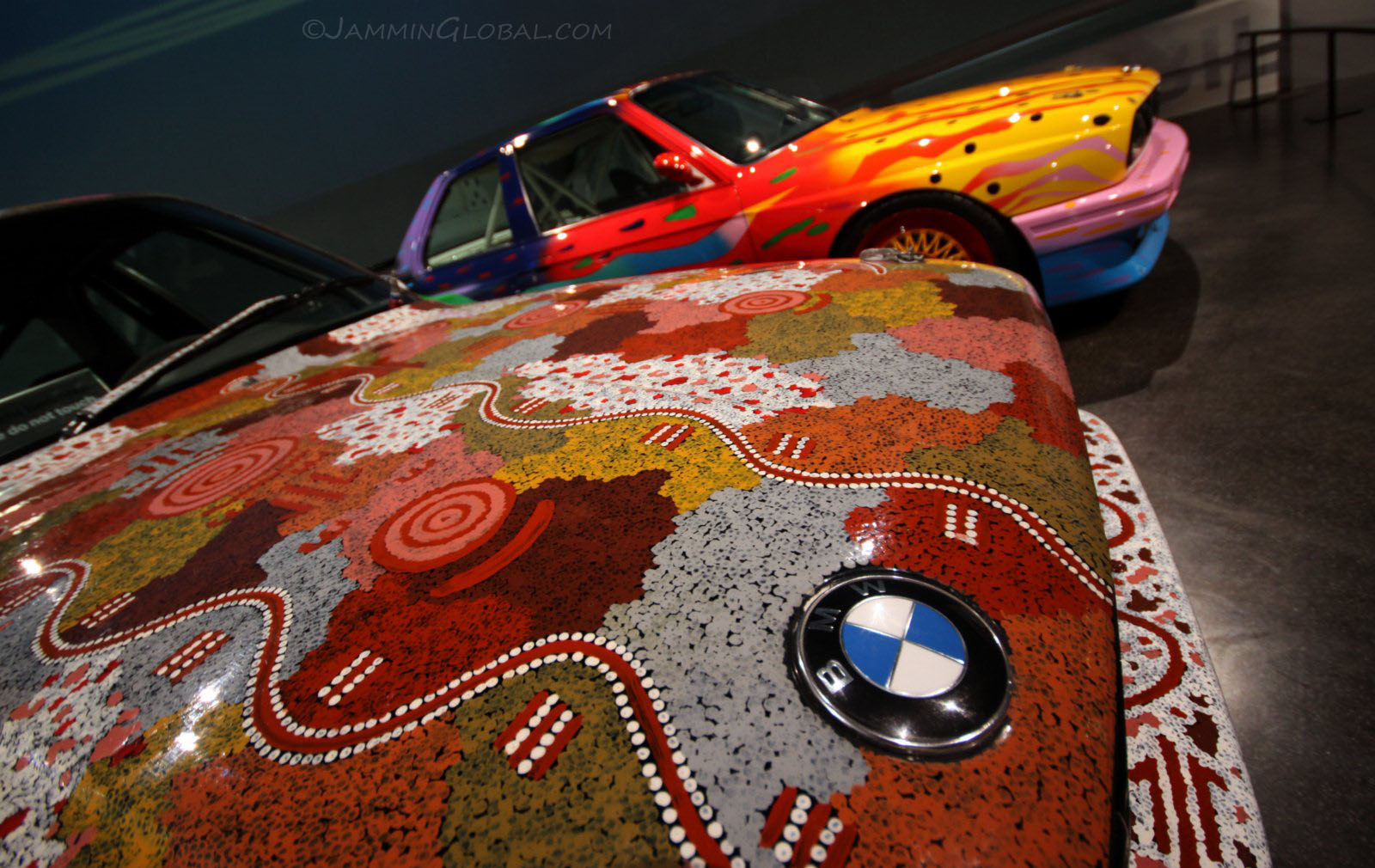
Two 1989 E30 M3 Art Cars, #8 in the foreground by Michael Jagamara Nelson and #7 by Ken Done. Nelson, from Australia, turned his car into a Papunya masterpiece, a form of painting by the Aborigines. The abstract shapes have in them embedded kangaroos, emus and opossums. Ken Done, also from down under, tried to portray the beauty and speed of vibrant parrots and parrot fish on his M3.
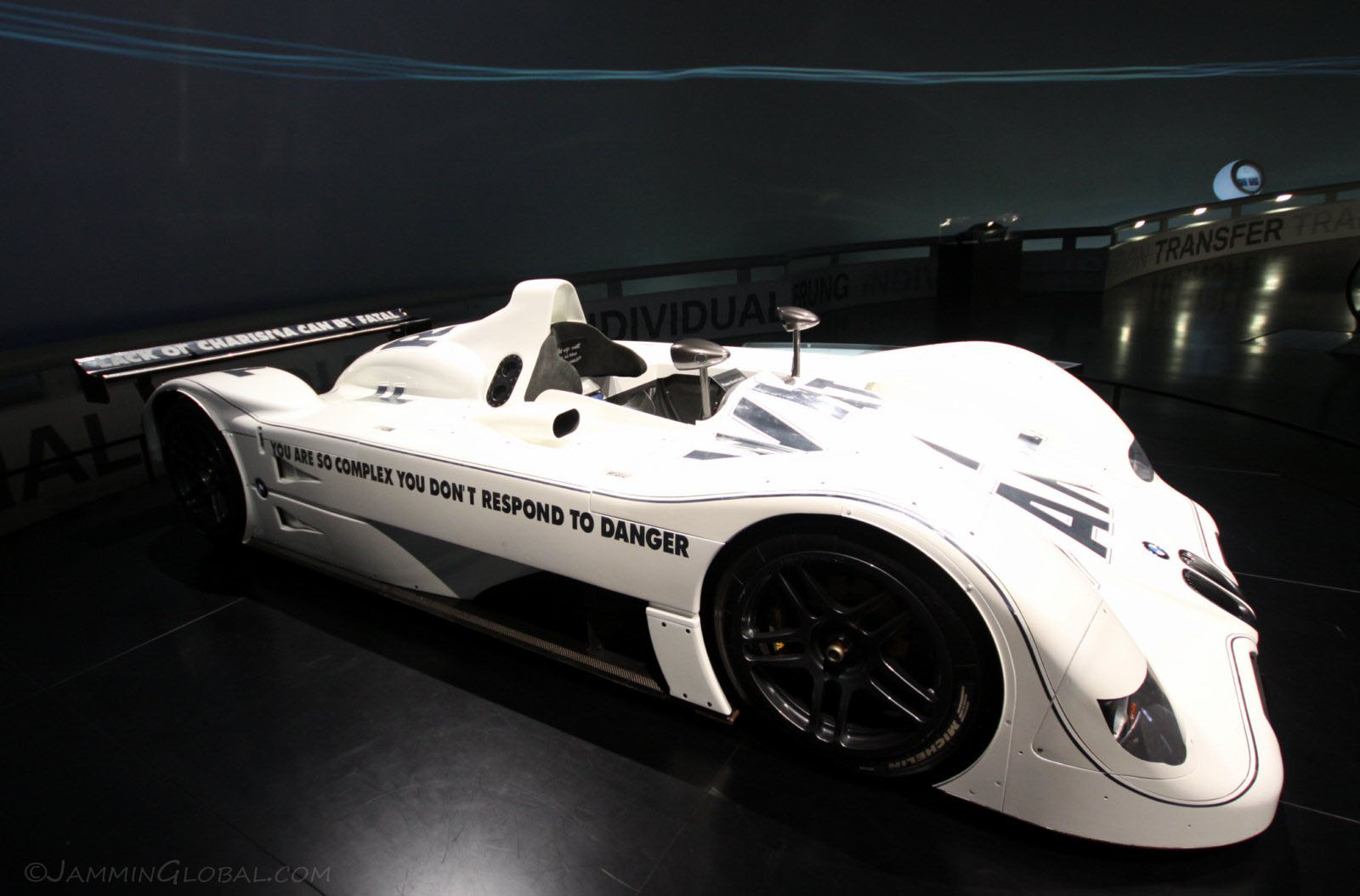
I think an art student can appreciate the diversity in artistic styles that the BMW Art Cars represent. This 1999 BMW V12 LMR, #15, was designed by the conceptual artist Jenny Holzer, who used words to convey her emotions. The car has messages that she says will probably never become void. The message on this sidepod reads 'you are so complex, you don't respond to danger.' The rear wing reads 'lack of charisma can be fatal.' I like it.
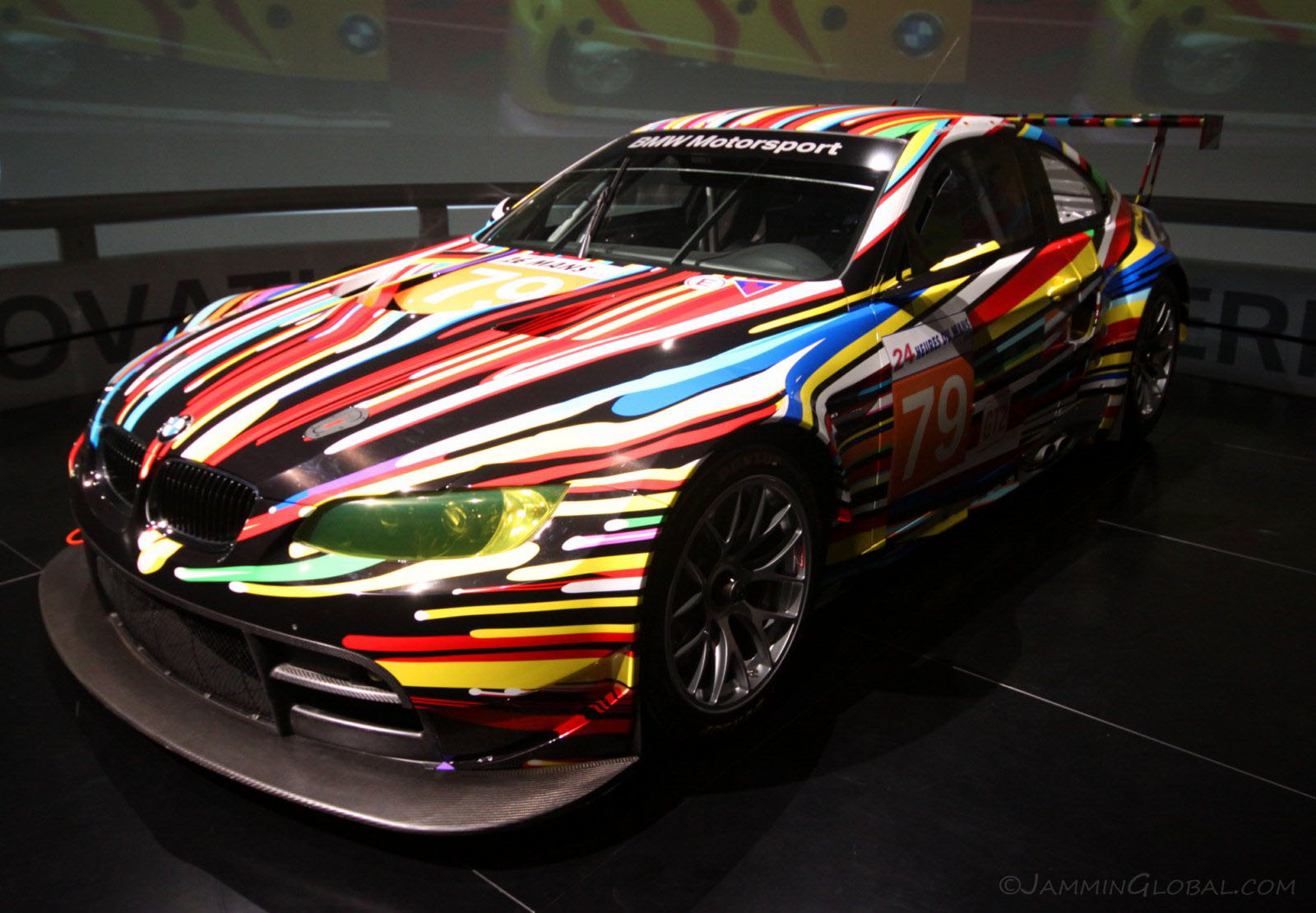
The newest art car, #17, designed in 2010 by Jeff Koons is of a BMW M3 GT2. Koons wanted to capture the power that was under the hood and his explosion of colors is supposed to resemble the motion of this extremely fast car. It says something about the company when they commission an artist to paint a car and then go and race it, risking damage to their fine work of art.
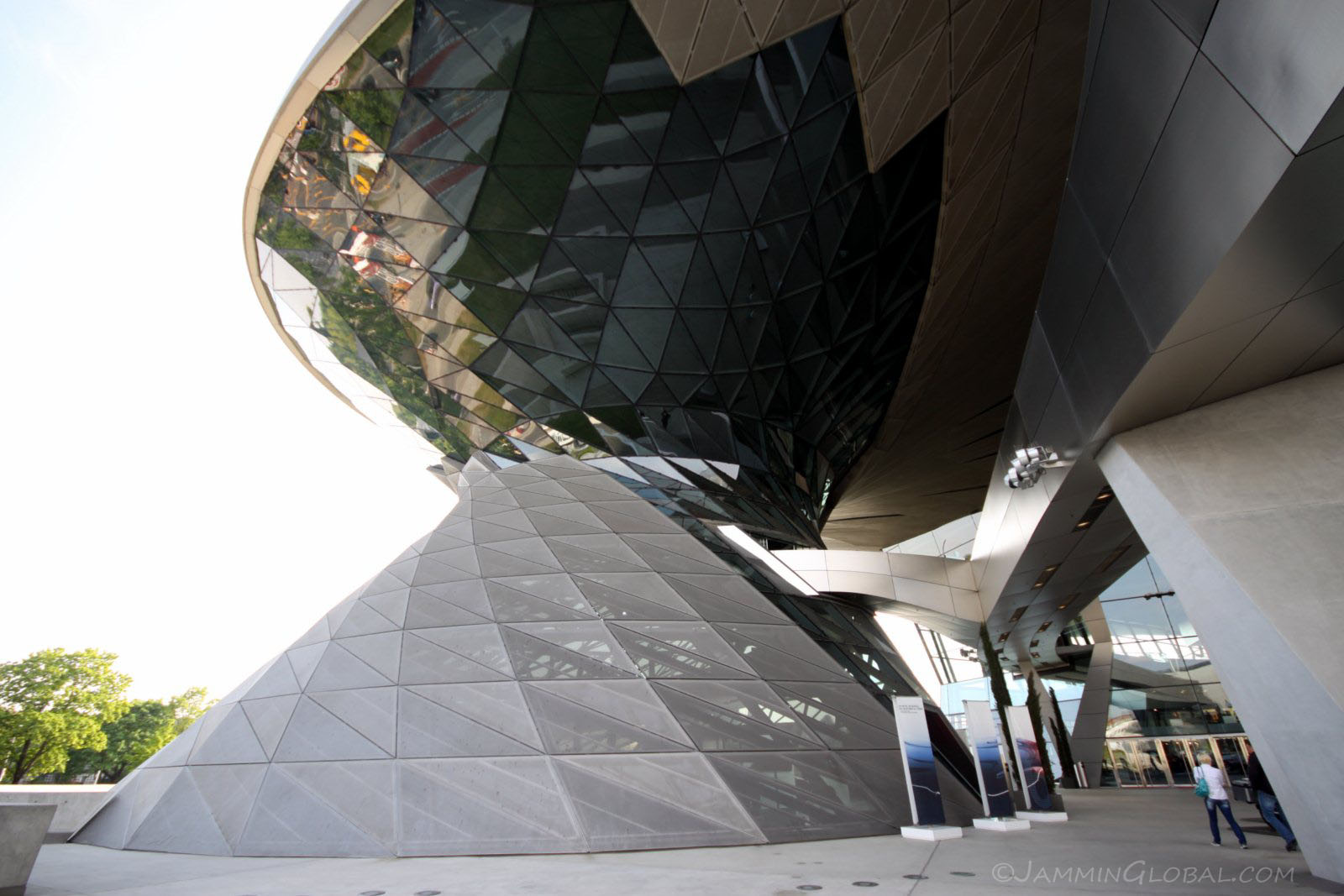
Across from the museum is BMW Welt (world), which is a huge multi-purpose hall used for car deliveries, exhibitions and show-casing all the latest models. I wandered inside and managed to get myself on a factory tour. No pictures were allowed but it was very impressive to see the precision in the robotic chassis welders, a sort of robotic dance with sparks flying everywhere.
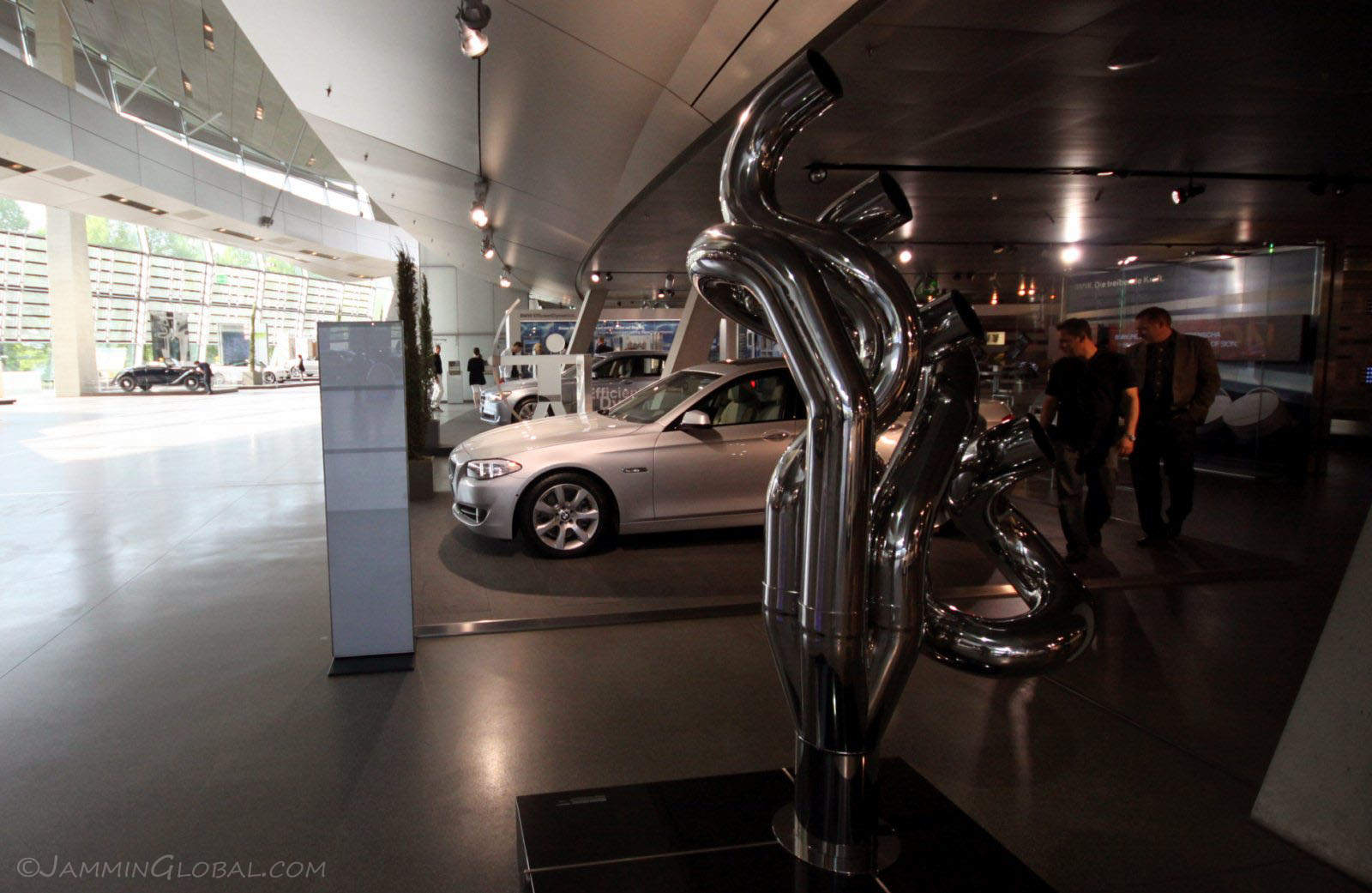
Inside BMW Welt and marveling at a sculpture of exhaust headers. They had informative displays on the internal combustion engine and how all their latest electronic aids functioned. After spending the whole day immersed in BMWs, I reflected on the smile-inducing drives of my very own Bimmer.
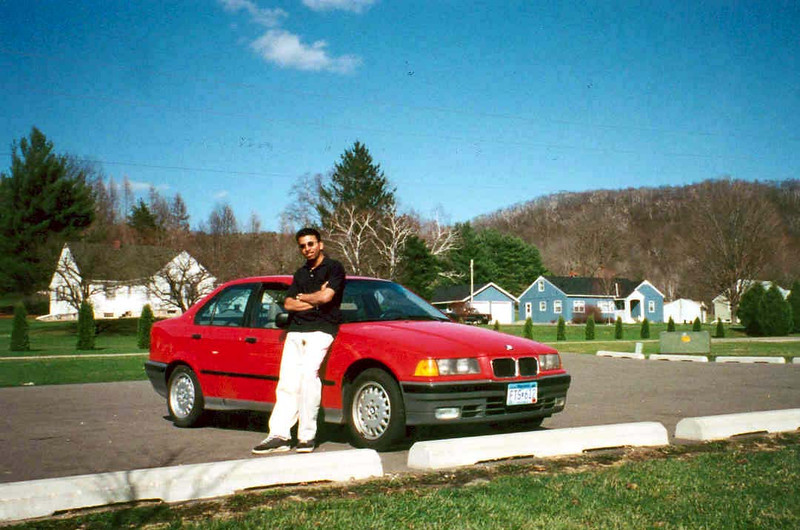
Meet Tiana, my 1992 BMW 325i that I bought when I was 19 after slaving away in a Pizza Hut for two years after coming to the US for college. She had 241,000 kms (150,000 miles) already on the clock when I got her and I put an additional 72,400 kms (40,000 miles) driving all over the US until she sadly got rear ended when I moved to Chicago. This is in southeastern Minnesota where I used to go for joy drives with Harjoth, testing the limits of the car and my driving skills, hitting its top speed and learning all about g-forces.
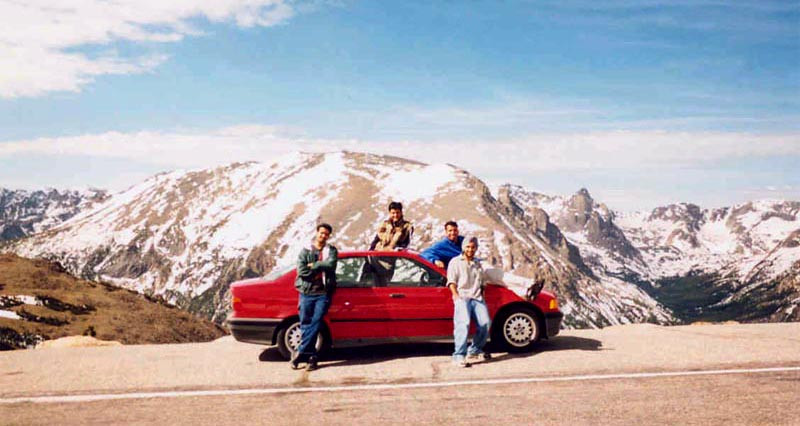
Going on a road trip with Tiana, Harjoth and the Rana brothers to the Rocky Mountain National Park. This is at the summit at 3,713 m (12,183 ft). The car was everything I had imagined a BMW to be and more. Its excellent condition for a ten year old car and good design had many people thinking it was a recent car or even a new one. I learnt how to wrench and maintain an automobile with her and she was very early in the line of mechanical beauties in my life that leads up to sanDRina.
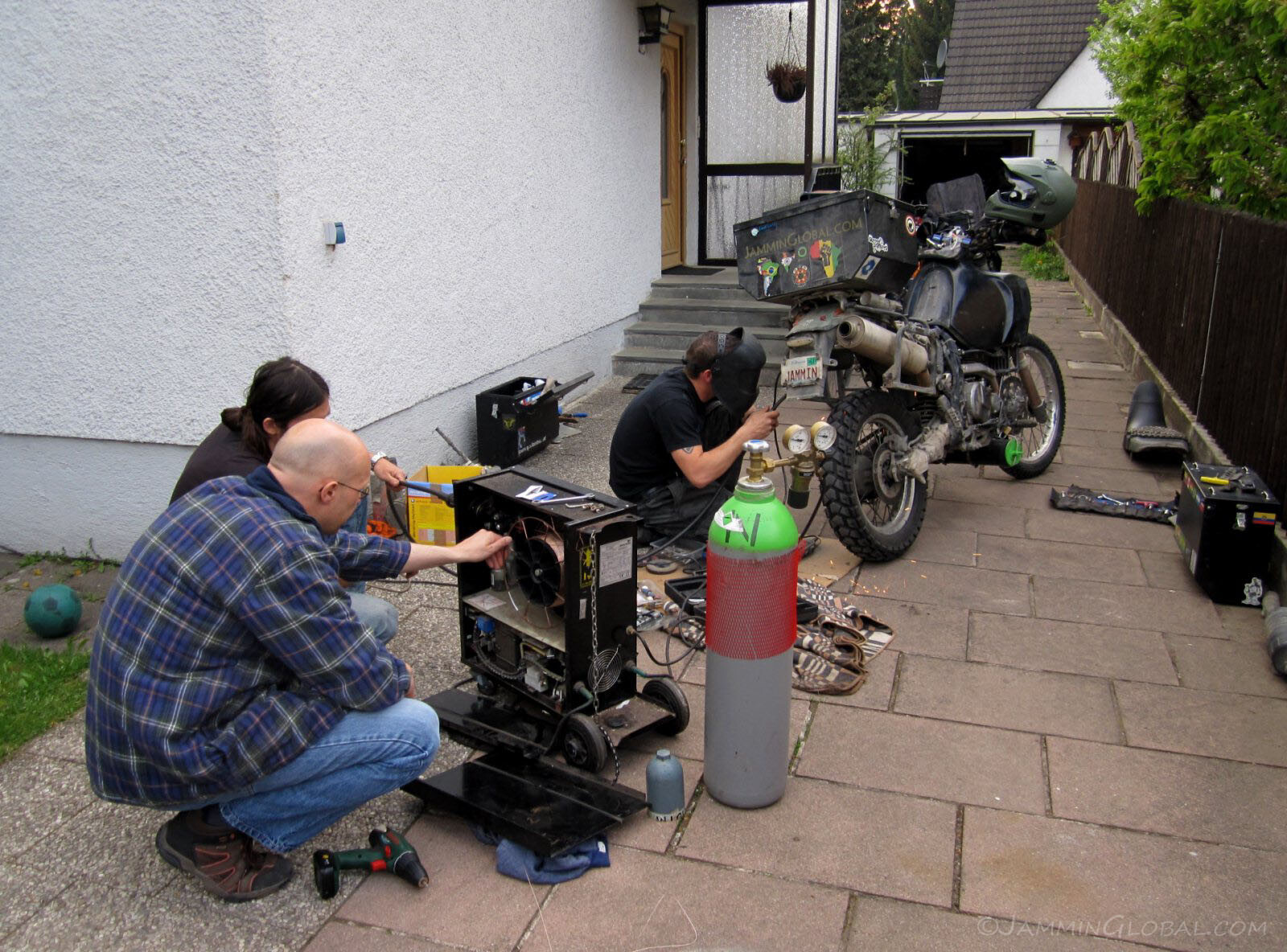
Speaking of whom was getting some welds fixed up. My friend, Michael, from Hamburg put me in touch with the dual-sport community in Munich and Erik (with the welding torch) offered to put me up for two nights. He rides a KTM 950 and asked if I needed to fix anything, which is a common question from one biker to a biker who's traveling because we know that there's always something that needs fixing, but which can wait a while and isn't urgent. My heavy panniers had started some cracks in the luggage frame after all the corrugated roads in Patagonia and I still hadn't gotten around to fixing it up. Erik said he had a welder and working as a test engineer for a tank company, I knew I could trust him. We're at his friend, Jens' house, where he keeps his welder since he lives in an apartment block and Andy came over to help, by feeding the wire in the welder.
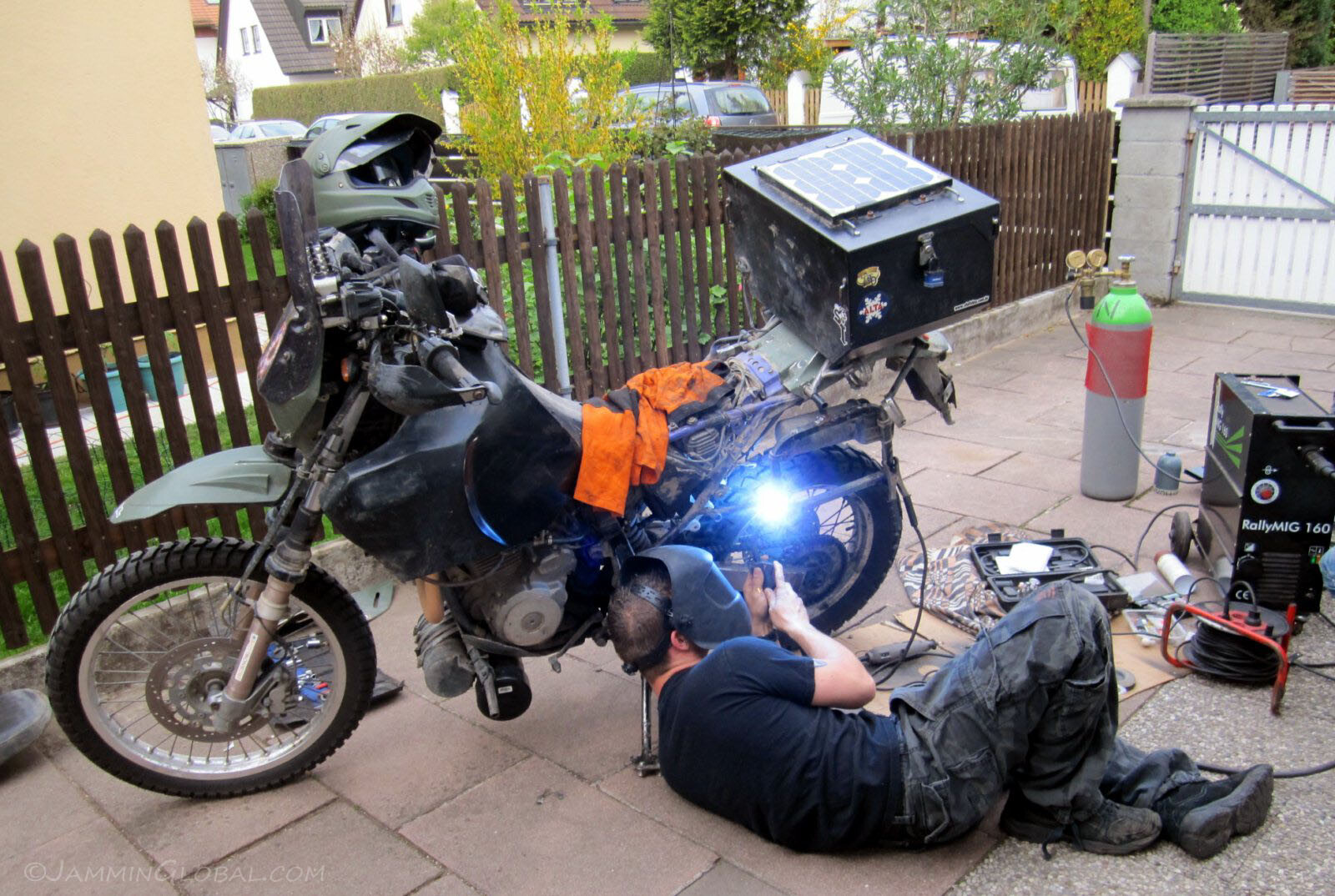
That luggage frame has been welded-up quite a few times now, but I can't fault the design. It's just that my panniers are too heavy and after some fast off-road riding, she needs a few welds.
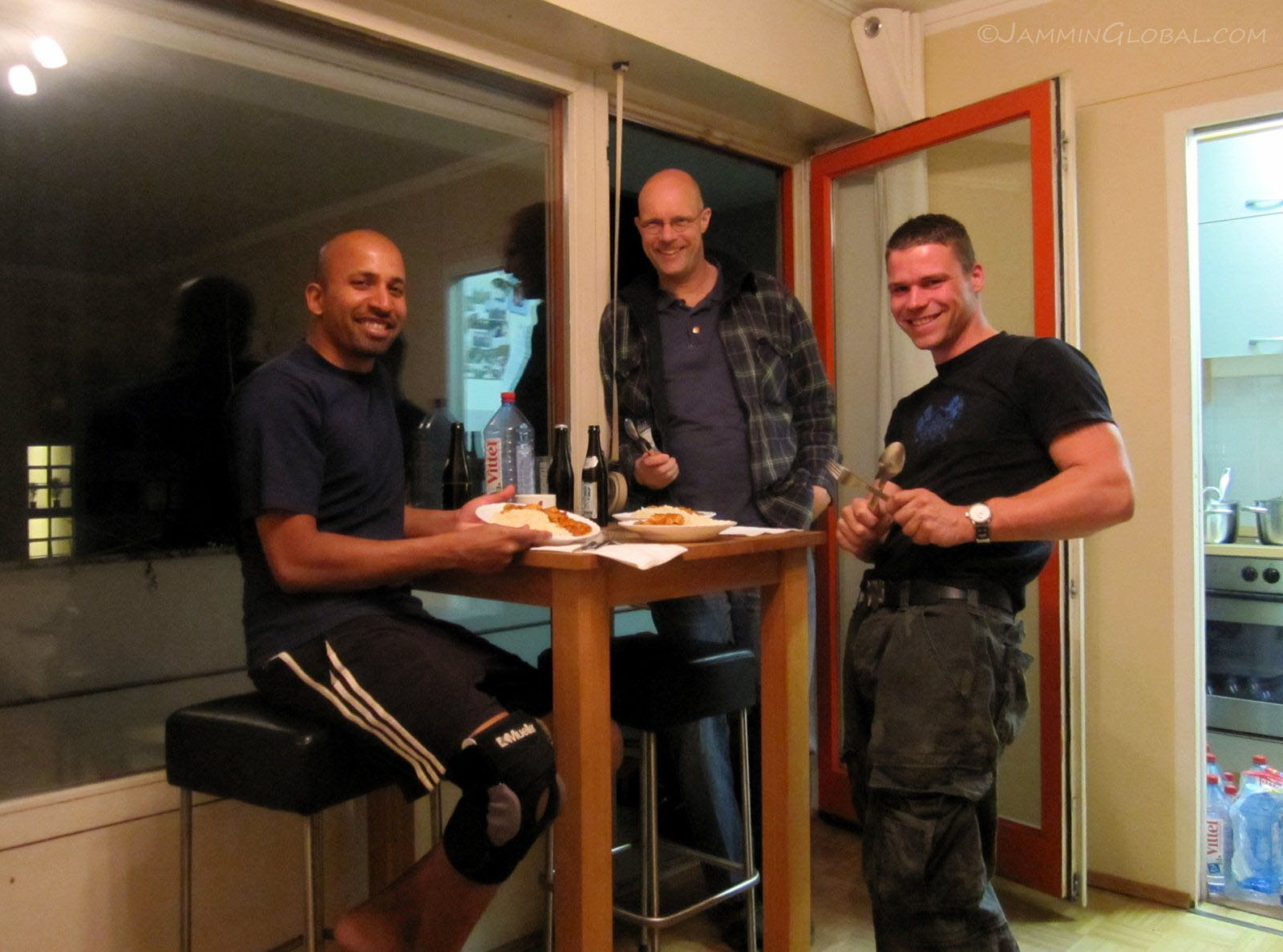
I repaid Erik the best way I know by preparing my chicken curry for him. He was a very easy going guy and I enjoyed hearing stories of him test-driving WKM Tanks before customer delivery. On the side roads in Germany, I saw road signs that warned of passing tanks and now I understood why, because they're allowed to do road tests on the public roads and sometimes they have to move from one facility to another. Erik has made some crazy tours with his KTM, like going on a winter off-road trip to Poland and he just came back from the Baja Saxonia rally. He has a nice story of why he ended up in Munich. He said after working four years in the army as a truck driver, he was riding his bike near Munich when it broke down. A man offered his place for Erik to fix his bike and he decided to stay.
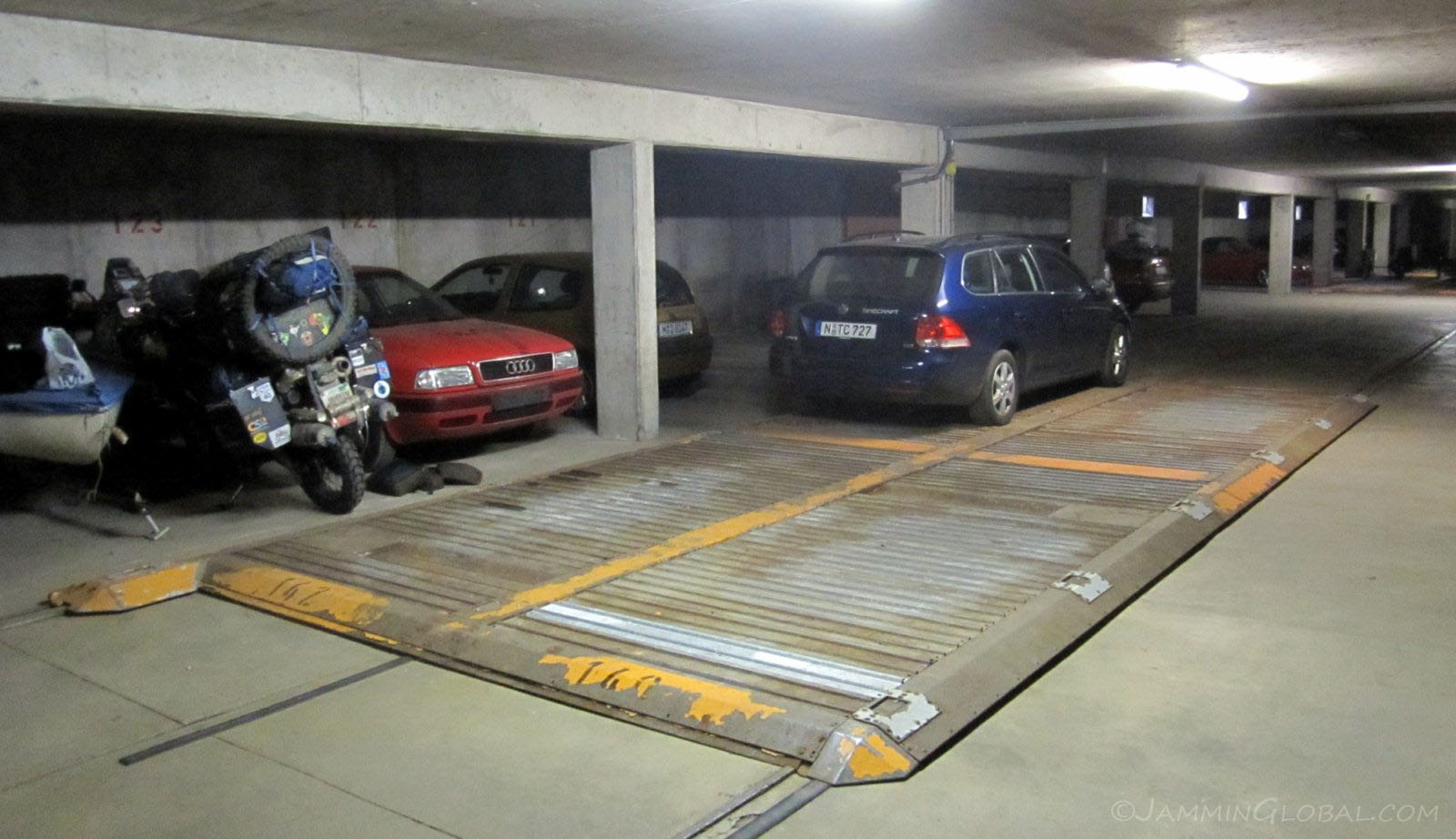
The underground garage at Erik's place. Due to lack of parking spots, as would be expected of Germans, a technical solution was found where four cars can be parked on this moving platform that owners move back and forth to get their cars out. While I was marveling at the idea, Erik was complaining that it's not amusing when it stops working and you can't get your car out. That's the problem with technical solutions - what do you do when it inevitably fails?
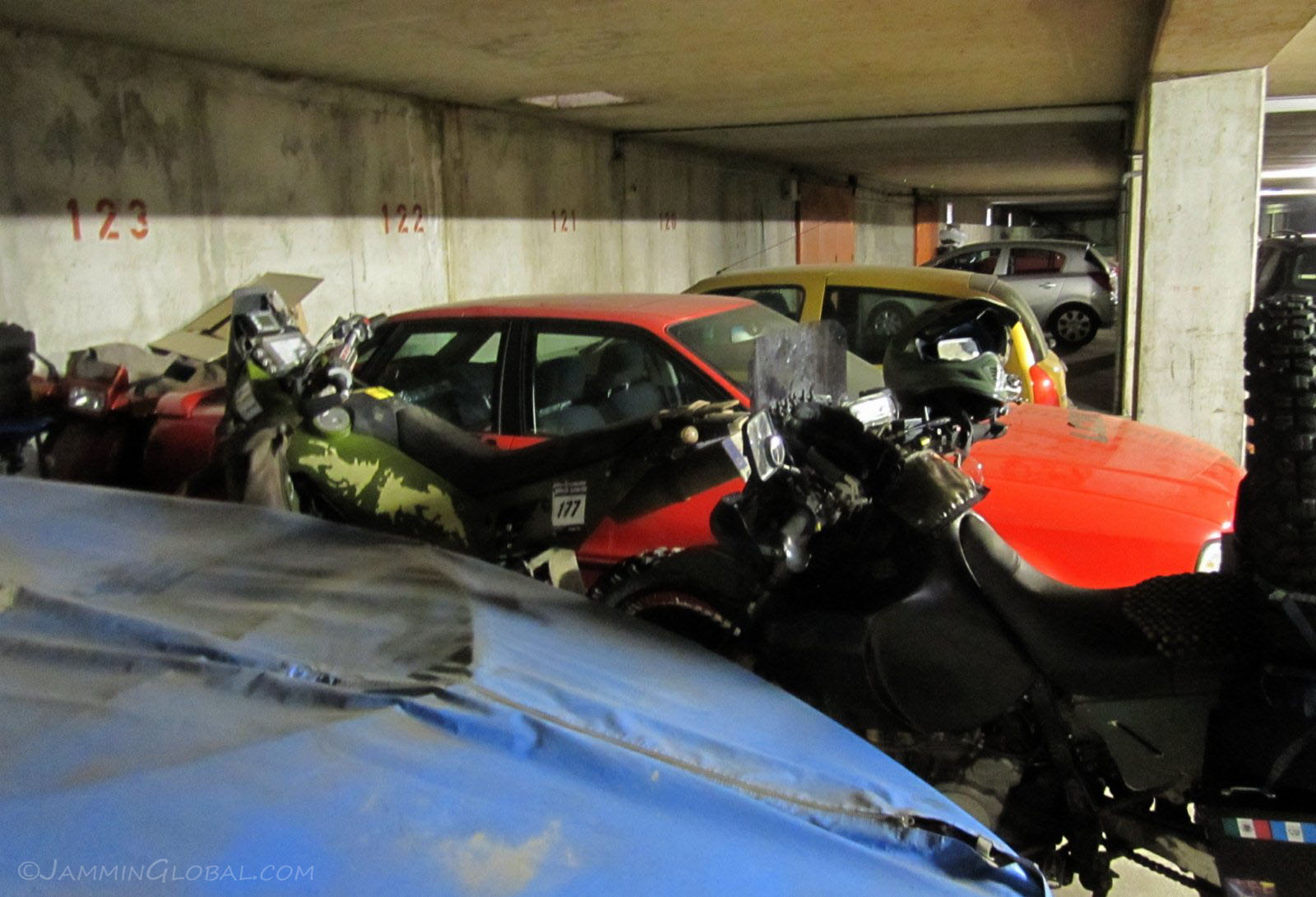
Erik was thrilled to see my self-painted olive green DR as he too has painted his KTM a similar color and like me, he's been derided by his riding buddies of his color choice but he felt vindicated that a world traveler would choose the same color. Being a proper gear head, he has an unused Audi and a boat. After Tiana got rear-ended, I kept her for a year before deciding what to do and just used her as storage space, which Erik completely understood.
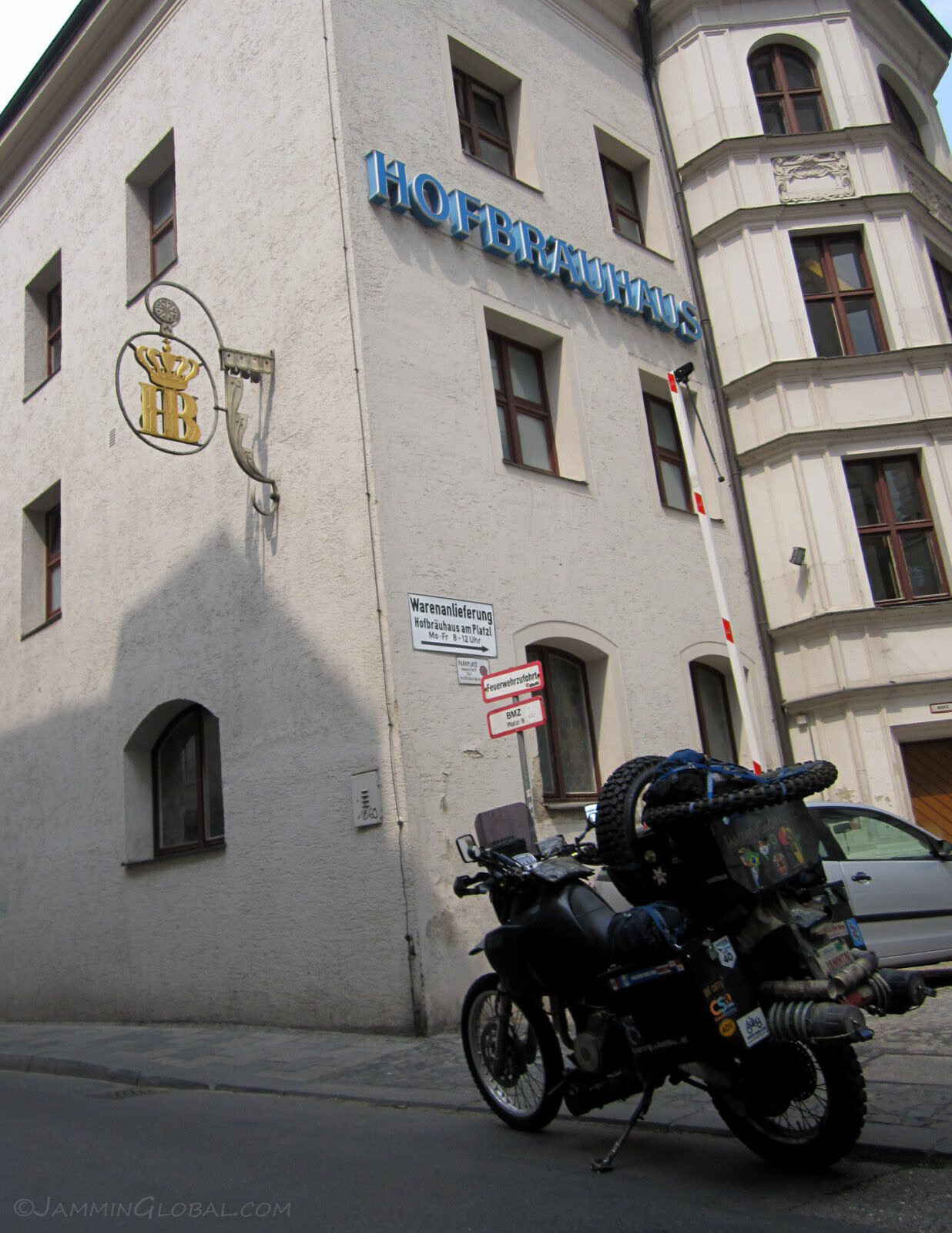
Taking off the next morning and passing through downtown Munich to pay homage to their world famous beer, such as Hofbrau, which has a beer garden in Chicago.
I know there's a lot more to be experienced in Munich, but I enjoyed my time spent in the hallowed halls of the car company that I've held up on a pedestal since childhood. Since those days, I've dreamt of visiting Munich just to experience BMW and my expectations were very high and they were surpassed. The brand lives up to its reputation and I think I've conveyed my fascination with this company. I'll come back some other time to experience all the other things that Munich is known for, such as massive beer gardens and a warm social life.
Next: Europe, Part 3: Across Germany into Prague
Previous: Europe, Part 5: Switzerland, for maintenance and the Alps